| 292. The History of Art II: “Disputa” of Raphael — the School of Athens
05 Oct 1917, Dornach Translator Unknown Rudolf Steiner |
|---|
| Every detail which we can lay our eyes on in order to understand this painting, to really understand it artistically, means every small detail has a certain meaning. |
| Let us be completely clear: under the papal predecessors before Julius II, Rome was at the time basically completely different than during Julius II's reign. |
| There they remained. One can really not understand what happens in the becoming of being human beings when one doesn't have a clear understanding of the need to repel spiritual impulses towards the East—to what is connected to Asia and to Russia as a European peninsula—from the 8th and 9th Centuries. |
| 292. The History of Art II: “Disputa” of Raphael — the School of Athens
05 Oct 1917, Dornach Translator Unknown Rudolf Steiner |
|---|
I didn't want to use several images as an introduction to my art history lecture today, but limit our observational introduction to only two images, both which will be placed into the newer historical development of mankind. We will then link these to the introduction of cultural epochs as we have done in earlier years. Look at this first painting to which our primary observation will refer; a painting you know well, the so-called “Disputa” of Raphael. 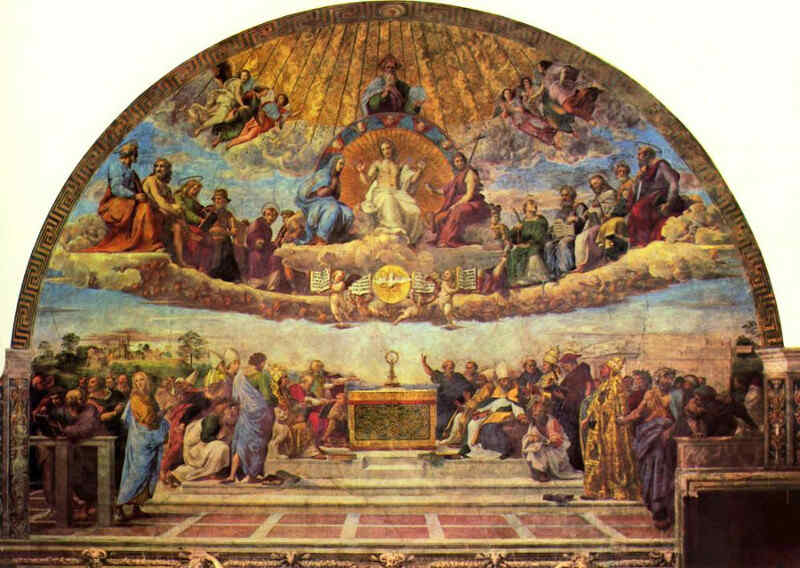 Let us visualize the painting's content briefly: below, in the centre, we see a kind of altar with a chalice on it and the host, a sacramental symbol. To the left and right are religious individuals and we recognise them as teachers, popes and bishops according to their drapery. Opposite the middle, the group is seen as moving from left and right according to the hand gesture of a person directly right of the altar. According to this we observe that these individuals are taking part in something descending from above. As a result we see, by looking at the space close behind the altar where the group is positioned, into the landscape and directly above it—in the upper half of the picture—cloud masses accumulating. To some extent we see the infinite horizon within this space. From out of the middle of these cloud masses we see angelic genii rise, floating on both sides of the dove, bringing the Gospels, transported out of the undeterminable spiritual world. In the centre we can see the Holy Ghost depicted in the symbol of a dove. Above the somewhat receding Holy Ghost we have—clearly, the angelic figures carrying the Gospels are actually coming forward in perspective—the figure of Christ Jesus and above Him the figure of the Father God. Thus we have the Trinity above the chalice where the sanctuary is found. On both sides of the Christ figure we have corresponding groups; a heavenly group above, reflected below by the worldly group. On both sides of the central Christ figure appear Saints, the Madonna on his right and John the Baptist, followed by others: David, Abraham, Adam, Paul, Peter and so on. Still further up rising into the clouds are actual genii figures, spiritual individualities. This image we have in front of us now—of course there are much better copies available—I would like to link this to the evolution of mankind. Primarily we need to clearly distinguish between what is given here and what we can experience when we transport ourselves into the feelings of the time when this image was actually being painted. If we shift ourselves into the 16th Century and compare it with the complexity of sensations a painter would paint in, today, we need to say: at that time, in Rome, when Pope Julius II reigned and what worked in him as Julius II in the middle of his twentieth year to call Raphael to Rome, was at that time, and in every town, the human experience of something which lived as a deep truth depicted in this painting. Today of course something similar could be painted; but if it was to be similar to this painting in the scene design, it would not depict any true reality. Such things need to be made completely clear otherwise one will never arrive at a concrete observation of human history but forever remain in abstract observations of a legend—a bad saga—which is called the history today in schools and universities. Every detail which we can lay our eyes on in order to understand this painting, to really understand it artistically, means every small detail has a certain meaning. Just think how Raphael, this extraordinary individuality Raphael, about whom we have often spoken, how he arrived in Rome. He too was in a body of a twenty year old and one can easily conclude that while he was mainly painting this picture, he was approaching the end of his twenties. At the time he was completely under the influence of two old people who had already experienced two great battles in life and who had plans and ideas, ideas who everyone, one could say, considered as most far-reaching. Let us be completely clear: under the papal predecessors before Julius II, Rome was at the time basically completely different than during Julius II's reign. The most remarkable here, as predecessors, were the Borgias. One could say that during the time of Alexander VI Rome was gradually being developed as overlapping the old ruins and rubble work of the ancient world where the Church of St Peter almost expired and became impractical. Admittedly these people were filled with a certain nostalgia for the artistic immensity of antiquity and wanting to enliven it again. However, a strange incident happened between the Borgias and Julius II, just at the turn of the 15th into the 16th century. Beneath the room and hall which belonged to the Camera della Segnatura, Alexander VI had two frescoes painted which we want to talk about today. It is surely extraordinary that Julius II, the patron of Raphael, had shunned this lower room which had been the ordinary residence of his predecessor, as if ghosts of cholera and the plague circulated there. He shunned this completely, could not be bothered with artistic or any other events which had taken place there before. On the contrary he decided, according to his ideas for the rooms and halls in the upper storeys, to spruce them up as we can still see them today. We must just think of the mind-set of Pope Julius II in connection with the beginning of the 16th Century and how his mind worked quite differently to those of his predecessors. The other patron of Raphael was Bramante. He had a plan in his head for the new St Peter's Church. Both Julius II and Bramante were already old people, as I said, who had the storms of life behind them. They called youthful individuals like Raphael to Rome to serve them, bring to expression picturesquely the new ideas powerfully rumbling in their heads, new impulses which they thought should penetrate humanity. One should look more closely at these impulses that originated in Rome and were to penetrate humanity from the beginning of the 16th Century onwards. These impulses depended from the one side on the close connection of the development of the outer Christian ecclesiastical world and then again, what the establishment of the Christian ecclesiastical world would relate to. On the other side it relates to the entire historic development of the western world. Just think for once, that today's human being has great difficulty in transporting his feelings and thoughts into a time, as it were, that have developed out of this image, so often named the “Disputa”. Even more difficult it is for contemporary mankind to transport themselves into centuries further back when Christianity already had power. I have often mentioned that people today have the impression that mankind were always as they are today. That is not quite the case, particularly in relation to their soul life, they were not like now. Just as with almost two thousand years before the Mystery of Golgotha something had been inserted into human evolution beside this Mystery which has spread into the breadth of social evolution, so something quite different to the Mystery of Golgotha came forth which we understand in a different way today. People imagine far too vaguely that at the time when this image was created, mankind was subjected to the discovery of America towards the end of the 15th century; secondly the entirely different social understanding came about through the invention of printing which finally, through Copernican and Kepler viewpoints established a new science. Just look at this painting. I want to say: if a painter would paint it today it would not in the same sense of truth be what it was then, it can't be; because today one couldn't find the soul who would paint this image in the same sense as at that time when it was actually painted, who would objectively with such an imagination for the earth have been thus, as if America hadn't yet been discovered. These would be souls who look at up at the clouds with true faith, who imagine the spiritual world in the clouds as we imagine it today, who to a certain extent imagine the clouds as real spatial bodies. Such souls are no longer to be found today, not even amongst the most naive. However, we imagine the souls of those times incorrectly if we don't believe that the content of this painting was something directly reflected by them. Let us consider—what exactly is the content of this painting? Out of today's scientific viewpoint we could identify the content of this image: we are accustomed to say that Imagination is the first step to looking into the higher worlds. If we say: up to the 16th century mankind had a view regarding the world and cosmic space in relation to the earthly world, which depended on imagination, then this is the actual truth. Imaginations were at that time something lively; and Raphael painted lively representations of soul experiences. The view of the world, the world image, was still at that time something imaginative. These imaginations were dispelled by the caustic power of Copernicanism, the discovery of America and the art of printing. From this time mankind took the place of imagination, what we call imaginative knowledge and imaginative perception, and replaced it with outer representational images of the world's construction in totality. Thus, while presently we imagine the sun, the circling planets around it and so on, the people then couldn't do so at all; when they wanted to speak about something similar, they spoke about imaginative images. A representation of such an imagination is this painting. In the centuries in which imaginative cognition developed gradually to allow such paintings like those Raphael made, came to a certain cessation in the 16th Century, these centuries are thus the 16th, 15th, 14th, 13th, 12th, 11th, 10th right back to the 9th Century, but no further back. If we want to go yet further back we won't find any real imaginative representations any longer if we ourselves want to experience imaginative art, as people did in these mentioned centuries, which we find difficult enough to raise in the soul today, imaginatively. If we wish to experience what Christianity was before the 6th Century we need to imagine the Christian experience as far more spiritual than we tend to do usually. Augustine extracted only what he could use from the Christian imaginations. Yet by reading Augustine today one gets quite a different feeling for what else lived as a world view and as an image of the interconnections of the world with humanity at that time, so different from now. Of particular importance are the ideas which you find on reading Scotus Erigena, who taught at the time of Charles the Bald. One might say that these ancient centuries before the 9th were permeated with Christian thoughts experienced by those who at least elevated their thoughts to permeate their Christian thinking with highly spiritual imagination. One might say when humanity created a world view during these ancient times they included really very little of their direct sense experiences. From their world view they included much more of that which did not result from sense experiences but had been brought about by old clairvoyant sight of the world. When we go back to the first centuries after the Mystery of Golgotha and follow the Christian ideas then we find that these ideas are such than one would rather say—these people were interested in the heavenly Christ, the Christ as He was in the spiritual worlds, while what He became on the earth below they considered more as supplementary. To search for The Christ amidst spiritual beings, to think of Him in relation to super-sensory spirituality was their essential striving, and that came out of the old spiritual—then the atavistic—world view. This world view filled the ancient culture right down to the third post-Atlantean age. At that time it was thought that the earth really was some kind of supplement to the spiritual. One should familiarise oneself with an imagination which is entirely essential if one would understand, would want to comprehend, how humanity actually developed from that time to now. With this imagination we must acquaint ourselves with the idea that the Europeans had by necessity to drive back spiritual imagination for the unfolding of their culture. This should be dealt with in sympathy and not antipathy—this should in no way be judged with a critical mind but the facts should simply be taken as they are presented: it was simply the fate, Europe's karma to acquire their culture in a way they had to. It was Europe's fate: pushing back spiritual ideas, curbing it so to speak. Thus it became ever clearer and more meaningful that from the 9th Century Europe needed Christianity while spiritual ideas were being suppressed. A result of this necessity was the splitting of the Greek- oriental and the Roman Catholic Church. At that time it split the East from the West. This is very important. The West had the destiny to push spiritual impulses into the East. There they remained. One can really not understand what happens in the becoming of being human beings when one doesn't have a clear understanding of the need to repel spiritual impulses towards the East—to what is connected to Asia and to Russia as a European peninsula—from the 8th and 9th Centuries. These impulses were pushed together and developed independently from western European and central European life, and propagated into the present Russia. This is very important. Only once this was properly established. Today there is a tendency not to consider things through relationships. As a result an event such as the Russian revolution apparently developed in a few months—someone or other came to this idea—while the truth pre-empting it lay in the background as a result of the specific course of events through the centuries, while spiritual life became invisible, impractical and pushed back towards the East and being stuck, yet still working in a chaotic, indefinable way made people stand right within events in the East. Yet this standing within it was really hardly living within it just like people who swim in a lake—if they have not exactly drowned—have seawater surrounding them. Likewise, what worked as spiritual impulses superficially in the East, still existed spiritually. People swam inside it and had no clue what pressed in on the surface from the 9th Century and which was then pushed back to the East, so that it could be safe guarded to survive and enter evolution later. People who originated in the East and who gradually developed from migration and similar relationships, into their souls the spiritual impulses were introduced which couldn't be used in the West, South and Central Europe. The West retained something extraordinary. The East, without knowing—most important things run their course in the subconscious—the East, without knowing, remained steady on the basic saying of the Gospels: “My Kingdom is not of this world”. Hence in the East the leaning within the physical plane is always upwards, towards the spiritual world. The West depended on reversing the sentence: “My Kingdom is not of this World” by correcting it to make the Kingdom of Christ in this world. As a result we see Europe had the fate of constituting the realm of Christ outwardly as an empire on the physical plane. One could say from Rome the law was proclaimed since the 9th Century: break away from the sentence “My Kingdom is not of this World” by actually constituting a worldly kingdom, a kingdom for Christ Jesus on earth, which would be on the physical plane. The Roman pope gradually became the one to say: My Kingdom is the Kingdom of Christ; but this Kingdom of Christ is from this world; we have constituted it in such a way that this Kingdom of Christ is of this world. However a consciousness prevailed that Christ's kingdom was not one which could be based on the 13 ground rules of external natural existence. People were aware that when they looked out into nature, lit by the sun's morning redness and the sunset's glow, by the stars, then it is not only a matter of what the eyes saw, what the ears heard or the hands could grip, but in the widths of infinite space at the same time existed something of the spiritual kingdom. Everything visible in the world is to some extent the last outflow, the last wave of the spiritual world. This visible world is only complete when one is totally aware that it is the outflow of a spiritual world. The spiritual world is real; humanity has but lost their sight of this spiritual world. It is hidden yet it is a reality, an actuality. When a person enters the gate of death and is particularly blessed, he or she steps into the spiritual world. In times past people were far more lively in their thoughts than we can imagine. When the blessed ones who had died went through the gate of death, they entered a world which we can imagine in the very present time—permeated with clouds, permeated with stars, piercing the orbit of the planets. It was something so concrete that the souls of the dead could create the upper group depicted in the painting. The souls of the dead combined what existed for them out of the past to depict this concrete mystery, this concrete secret of the nature of the Trinity in their midst: as the Father God—out of the character of the present: the Christ Jesus—and out of the reality of the future: the Holy Ghost. In the reality of that present day world, if the physically sensed world did not appear as a mere illusion to people and let them live like animals, what differentiated itself in the reality of time had to appear on the physical plane in sighs, as a reference to the invisible spiritual world weaving and living above the clouds. Future generations have to have living signs for those not yet born and for those who are now passed over souls and are in possession of direct sight. On the altar stands the Chalice with the Sanktissimum, the host. This host or wafer is no mere bit of external matter for people who stand on the right, left and around it, but this host is surrounded by its aura. Within this aura of the host forces work which pour down from the Trinity. Such imaginations experienced by the heads of church fathers, bishops and popes regarding the sanctity of an altar are incomprehensible by present day humanity. This imagination has elapsed in the course of time. A moment is eternalized in this painting by the people below the altar rising: here is the mystery which is positioned on the altar: something surrounds the host. This something can be seen by those who have died, namely the blessed ones: David, Abraham, Adam, Moses, Peter and Paul—these departed ones look upon this in the same way we on the physical plane would observe things in the sense world. When we look at what is below, under the central sacred sacrament, we have to some measure an image in the lower layers of the painting of which a person like Pope Julius II said: This, in its great glory, I want to establish on earth in Rome if at all possible; such a kingdom, such an empire—not a state but an empire—in order for things to take place in this empire and be so enveloped by these auras that the past and its impulses live on in these auras. An empire that exists in this world but which, because it is of this world, contains signs and symbols for what lives in the spiritual world. Ideas of this kind Julius II incited first in Bramante and then in youthful Raphael. Thus it came about that the young Raphael could compose this painting. In a way Julius II wanted this painting in his study, have it constantly before him like a holy saying on which Rome had to be based because it contained the most important things in the mysteries. However this empire had to be on this earth, of this earth with a spiritual inclusion. If one allows all these experiences we have spoken about to work on one's soul, from its impression one might say: the spiritual world has been pushed back into the East since the 9th Century as is shown by the clouds driven backward and up, waiting for their time to come. In contrast there were preparations being made in the West for the 5th post-Atlantean epoch in which we are all still living and in which we will live for a long time, which exists under the signature: My kingdom is of this world and this kingdom will increasingly become more of this world. However this kingdom which is of this world was founded nearly from the beginning of the 5th post-Atlantean epoch under the influence of old people like Bramante and Julius II, but also the youth Raphael. The most important historical things happen subconsciously and from this subconscious yet wise basis Julius II called Raphael. We know that humanity was becoming ever younger through the centuries; we know that since the beginning of the 5th post-Atlantean epoch the age of the twenty eight had been reached and it was now “27 years old”. Certainly Bramante and Julius II were old people but they were not as directly placed in the world as could the youthful Raphael in his young body with youthful forces of twenty-eight when he painted this way. This is an important spiritual background in the development of humanity. We can recall how Raphael painted in the characterized thought (explained above) of Rome at the time; he painted to a certain extent in protest against the 5th post-Atlantean epoch for the fourth post-Atlantean epoch. This was not the case but let us hypothetically argue that it was thus in Raphael's soul: we can imagine that in his soul, in his subconscious soul lived knowledge which would be coming out of the 5th post Atlantean time. Out of this godless, spirit-robbed world of the 5th post-Atlantean time humanity's thoughts would be permeated with bare, barren and icy space where sun and spiritless planets depict the dreary space, spiritlessly imagining the world and try, according to spiritless laws of nature, construct the unfolding of the world. Let us imagine what had been presented to Raphael's soul: the reality of the spiritual emptiness of the 5th post-Atlantean epoch. Raphael's soul had counter acted: It should not be like this, I will throw myself against this mindless epoch with its imposed notions in frozen space with mindless mist in the form of the Kant-Laplace theories, with my lively spiritual existence. I want to permeate the imagination as much as possible in this dreary existence with true imagination which offers itself to clairvoyant understanding of the world.—Suppose this is what Raphael's soul depicted. Thus it appeared in his subconscious soul; it had even appeared in the same way in the soul of Julius II. Our age really doesn't need to despise great minds like Julius II or even the Borgias as is done with historical winners, because history still has to reduce some judgements regarding our contemporaries—the greatest ones of our times—just as it did with the Borgias or Julius II and will be the case of individuals in the future. People present at that time just did not have a distance to it. Raphael was born at the start of the 5th post-Atlantic epoch, one could say, as a child of the 5th post-Atlantic epoch. He was really born out of this 5th post-Atlantic epoch but as a lively protest against his age—he wanted to stand within its beauty which this epoch no longer experienced as real; this epoch strived to insert sensible spirituality into de-spiritualized certainty and impose that on the 5th post-Atlantean epoch, as has been discovered from spiritual research. Raphael's aim was more or less to depict clear images visible in the spiritual realm, imported from that realm into this world, in a painting filled with signs of the supersensible, thereby creating another world. As a result this image is through and through a true picture because it has originated in a lively experience arising from that time. Just consider this particular time when the child of the 5th post-Atlantic epoch drew the entire imaginative, spiritual imagery of the 4th post-Atlantean time into the 5th. Roughly at this time, during nearly the same year, a Nordic personality slipped up the penitent's stair in Rome, the stairs acclaimed for their ability to be equated to godly work according to the number of stairs climbed, because the number of steps taken on the stairs meant the same number of days relieved of hell fire. While Raphael was painting in the Vatican the Camera della Segnatura and similar images, this Nordic person, so devoted, in full of belief, so concerned for his soul's salvation, ascended the stair—so many stairs for so many days free from purgatory, doing work to please God. While he was thus climbing the stair, he had a vision—the vision showed him the futility of such holy work rushing up the stairs—a vision which ripped open the veil between him and that world which Raphael as a child of the 5th post-Atlantean time was painting as a testament of the 4th post-Atlantean time. You can recognise this person as Luther, the antitheses of Raphael. Raphael, even when he was looking around in the outer world, would see colour and form, all kinds of spiritual images, everything as expressions of the supersensible world yet reflected, expressed as sensual colour, forms and gestures. Luther was at the same time in Rome, filled with song and poetry, yet amorphous, formless in his soul, rejecting everything in this world which surrounded him in Rome. Like the spiritual world was pushed back in the 9th century into the East, it was now a testament of the 4th post-Atlantean epoch in Europe. Luther pushed it all back. Thus in the future the threefold world presented itself: in the East spirituality was pushed back, in the South it was somewhat divided as the testament of the 4th post-Atlantean epoch and again became pushed back and rejected. The musical element of the North took the place of the colour and form-rich testament of the South. Luther is really the antithesis of Raphael. Raphael is a child of the 5th post-Atlantean epoch, his soul however contained everything which lived in the 4th post-Atlantean time. Luther is a late-comer of the 4th post-Atlantean time, he doesn't belong in the 5th post-Atlantean epoch; one might say he was transferred from the 4th into the 5th. In his frame of mind Luther was completely within the 4th post-Atlantean time. His thoughts and feelings were like a person living in the 4th epoch but he was transferred into the 5th and lived now out of an echo sounding into the 5th epoch with its blatancy, its obvious natural history and ice fields of barren spirituality. Raphael had the soul content of the 4th post-Atlantean time; Luther, even though he was transferred out of the 4th into the 5th, had a soul standing right in the 4th post-Atlantean time but rejected everything external, he wanted by contrast to create everything which had nothing to do with external work and external human activities—a soul based solely between the formless inner connection of the human soul and the spiritual world, dependant on faith only. Just think for a moment how a painter like Raphael would have painted out of southern Catholicism, and compare how it could be painted from a Lutheran standpoint. What would he paint? He would paint a Christ figure somewhat like Albrecht Dürer's; or he would paint a religious person in whose physiognomic expression one would recognise a soul with nothing in common regarding the material surroundings and the objects within this environment into which it has been imposed. Thus one age connects to another. In the present time mankind has quite different ideas. This you see in paintings where Christ is depicted as a person amongst the people: “Come, Master Jesus, be our guest”—as human and equal as possible:  In our painting we have a group of Bishops, learned church fathers, and in the middle the obvious sign, the symbol. This points to the supersensible world; the Trinity is concretely included. Let us lift out this “Trinity” in particular. We have another painting which represents this Trinity on its own. 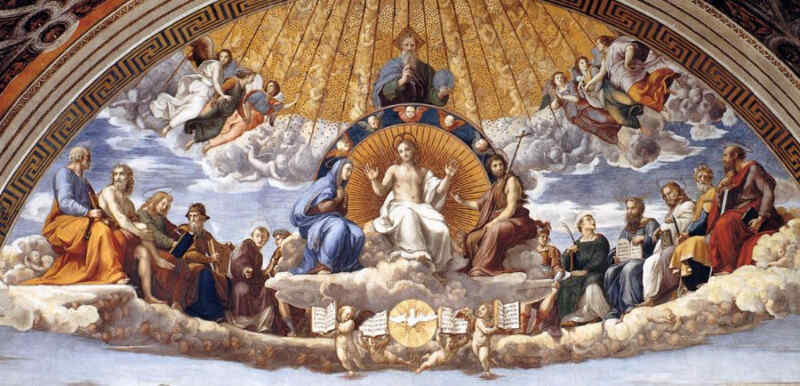  At the top we see the Father God, below that, Holy Ghost and the Son. You behold these members as concrete content of the future, the present, taken out of the past. It would not have been appropriate in the world view of that present time to mix the blessed souls of the dead directly with the observation of the outer visible world. However Raphael used, in the sense of the imagination of that time, what he observed as the truth, the free view in the widths of natural realms. To a certain extend he had to express the blatant obviousness that filled the space was not the truth; but the truth places them within the space. Thus we have at the bottom—you still notice the line of the horizon—the width, infinity within the expanding perspective. To a certain extent protest is expressed against representing nature at present as a purely sense perceptible image. Raphael didn't simply arrive at this image and hit upon the composition. In order for it to become clear, let us consider two of Raphael's preliminary sketches towards the painting's gradual development: 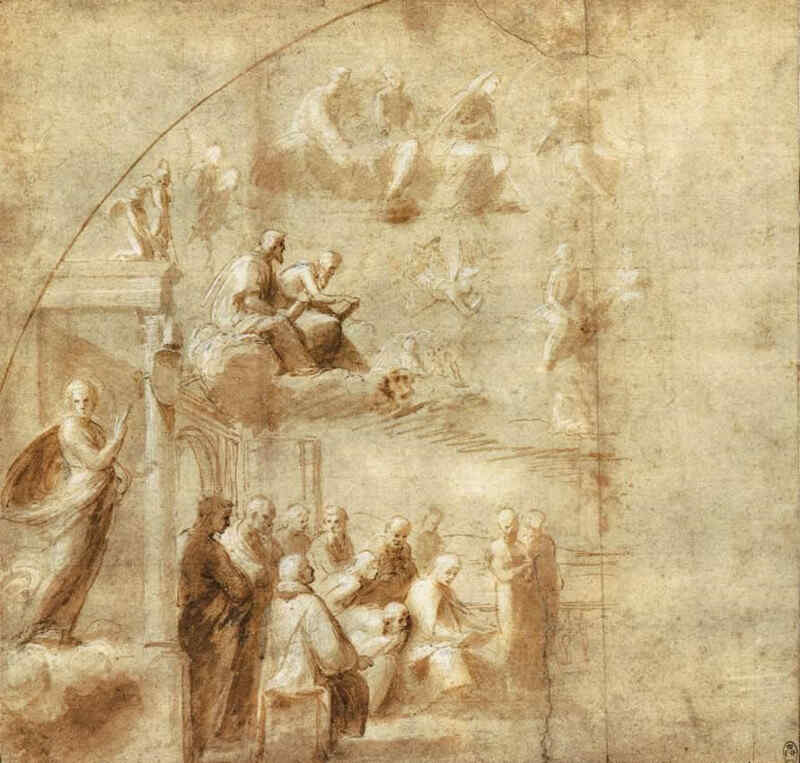 Imagine the entire story, from the time Raphael came to Rome roundabout the time Julius II called him to execute the commission in 1507, 1508, and try include this into the painting which he had in his imagination. Gradually he was first instructed by Julius II; gradually a relationship developed in him between space, nature and the supersensible and sensible aspects in the human group, how it had to be. 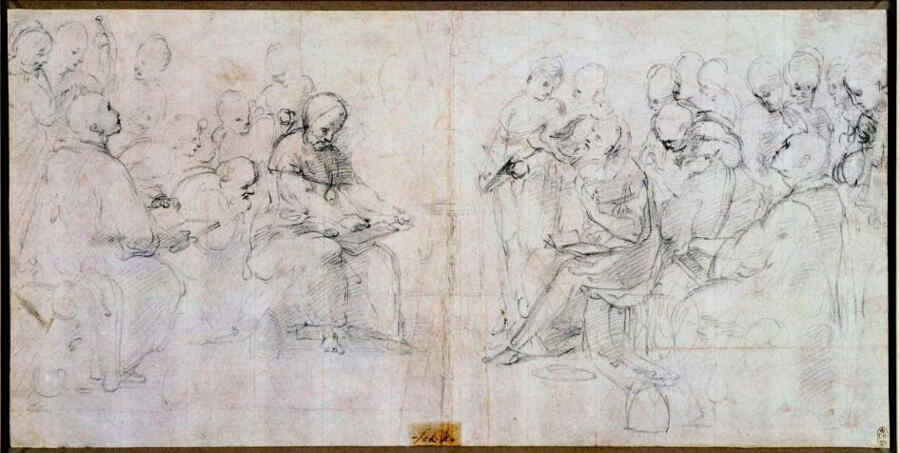 Section: the church teachers, in crayon (Windsor, Königliche Bibliothek) Also the other sketch refers more to the lower part than the first sketch, with still incomplete indications. You see it hasn't come into its own. What Raphael came to was this: he had to really imagine himself into that time and the relationship between the spiritual world and nature. In olden times, still up to the 9th Century, there was still a clear imagination of the relationship between the human past and the natural present. The people before the 9th Century—as grotesque as it may sound to mankind today—didn't think that when something was happening to them, it was by chance; no, they knew that when something happened to them it was because of the events into which they were being spun was where the dead were living, connected to them through karma. Before the 9th century the events which surrounded us place the dead before us. Such images diminished gradually and remained in the past as I have characterised for you in the 16th Century. Returning once more to the 9th Century we arrive at an imagination which needs consideration: a timely separation between the natural- and the spiritual world was not apparent for these ancient folk. Nature was at the same time a continuation—before the 9th Century, mind you—a continuation of the spiritual world. Already during the Greek times the human being had introduced their own I into their world view, by using thinking. Raphael was painting—he expressed this in the upper part of the canvas in the image later called “Disputa” even though certainly nothing was being disputed—and introduced a female figure out of the symbolism of that time with the motto: DIVINARUM RERUM NOTITIA = divinely written comment. Basically before the 9th Century the world view included the “divinely written comment” and nature was like a wave of the godlike world extending below to where mankind found itself.  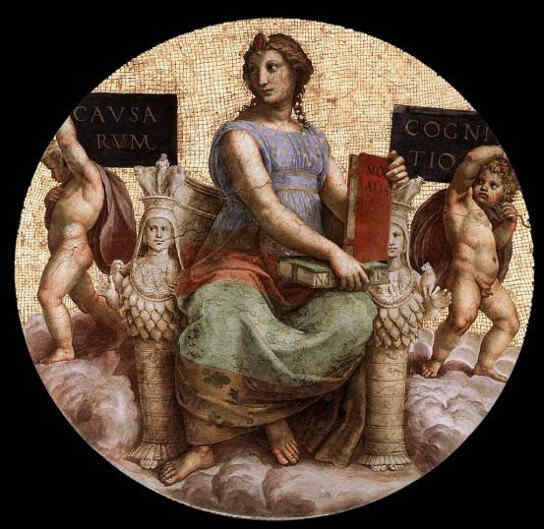 This entire notion, as I've mentioned, was pushed back to the East and the echo remained within the imagination, like a testament painted by Raphael from the 4th post-Atlantic epoch. In those days it was deliberated from the south to establish the kingdom of Christ on the physical plane itself as a real empire of power. Pope Julius II had even, like other similar personalities, written on his flag what he really wanted. He wanted to really establish this which could not happen because Luther came along, as did Calvin and Zwingli. He wanted to create the foundation for Christ's Empire in this world. He dared not say so. One can usually see this in such personalities as something esoteric. Julius II did not dare go through Italy as a commander in order to harness the Italians to his empire. He said it differently. He said he was going through Italy as a commander in order to free the Italian folk. This is what was said. In later times it was said something or other should be done to free the folk while this only hid the real goal. At the time however, many believed Julius II went through Italy to free the separate Italian nations. It didn't occur to him, just as little as it occurred or could in anyway occur to Woodrow Wilson, to set some or other folk free. Now, you see, here we have this immense border, one might say, between the two time periods: the backward push to everything southerly. Retained from this is the division in the world view in the Greek time. It was clearly as follows: What had streamed through nature as deeds of the dead was no longer present when people developed spiritual powers in themselves, unfolding it in their souls; it then doesn't become DIVINARUM RERUM NOTITIA, not something “written up as godly things” but becomes CAUSARUM COGNITIO—and attains “direct knowledge of causes in the world”. Here care should be taken not to want an interpretation of nature in its totality as an outcome. To come to an idea of nature—this Julius II felt compelled to shout in thunderous words—an imagination was to be made to show that the sun rises, the morning- and evening glow exists as do the stars, and just as people did in the 5th post-Atlantean epoch, it meant lying. In fact one denied that the souls of the dead were within the Trinity which was really something capable of imaginative expression by looking back to the dead souls, David, Abraham, Paul, Peter and express the Holy Trinity. Julius said: Leave away nature and the old Eons, only depict the youngest Eons! Do you want to rely on yourselves? If you want to develop through only human forces, depend only on what is inherent in the physical body, then you arrive at an external science regarding the outer nature of people, a science only in so far as the human being has no connection with the endless expanse of the world, but is hemmed in, interwoven within the boundaries it sets itself. This is roughly what Julius II told Raphael: If you want to paint what the human being through his own soul faculties know about humanity then you must not paint the people out of an endless perspective in nature, but include the people, whether genial or wise, in their self-made borders. You must include them in halls to show: from these rooms where the world is governed—because Julius wanted to have the world depicted as it would have become had no Luther arrived, nor a Zwingli, or any Calvinist.—If you want to paint the world as it is governed from these rooms, then paint on the one side the reality existing in the breadth of nature and on the other side, what people can find if they only sought forces from within their own souls. Then you may not paint nature but paint the people in their self-imposed borders. This is what we have when we allow the contrasting aspects in the image to work on us ... the so-called “School of Athens”. 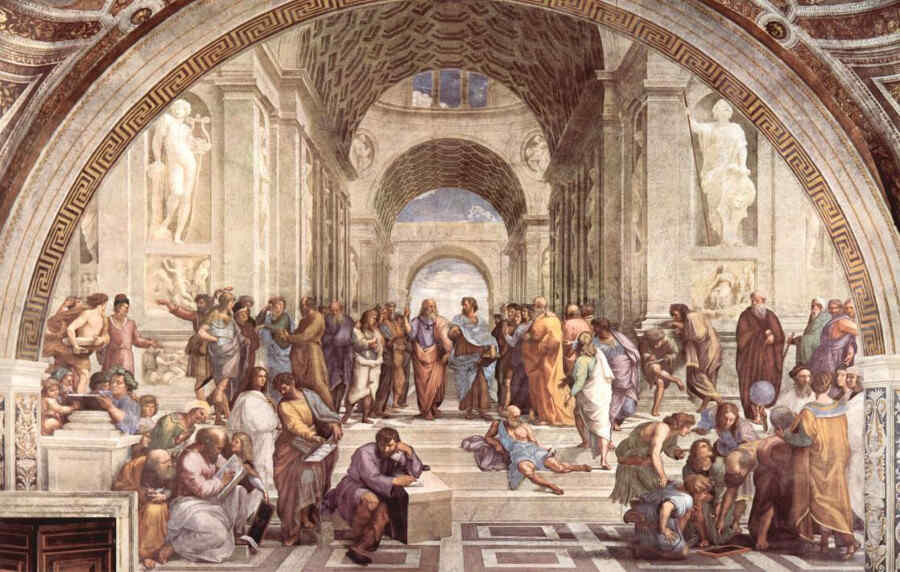 This painting, later becoming known as the “School of Athens”, was often painted over in the course of time and so the man standing in the middle had his book painted over with “Ethics” then later with “Time”—that was painted even later. The painting is in many ways ruined and one can't find the true image of the original painting today in Rome. In Raphael's time it was never called “The School of Athens”, this only happened later and then theories developed about it. We can imagine it essentially thus: truly the world is measured through the changed painting (197) when we peer into the endless realms of space and imagine nature not with obvious senses but permeated with everything existing in eternity and temporality, permeated with that which has gone through the gate of death. Taking knowledge from within one's own soul and representing it in everything coming together, like these wise men, here (202); the heavenly knowledge which can only be found built up within oneself, is represented in a personality which points upwards (203). No inartistic stupidity is needed to see Plato in this figure. (See below) You can imagine the following: the gesture of the rising hand represents the word being spoken by the figure on the right. The personality on the right begins to speak as if his expression is translated into words. Everything originating by itself in the human soul can only be truly imagined if it is contained within an enclosed space, where one remains within oneself. If one searches within for an image of nature then nothing other than an abstract image of nature will be found, much like the Copernican world view represents which is not a picture of concrete nature. Thus Raphael took the task from Julius II and placed it before the godly experience which could live by itself in the human soul in the beginning of the 5th post-Atlantic epoch. Here everything of worldly science is grouped, but worldly science raised up to divine concepts, to intellectual understanding of the godly. On analysis the seven free arts appear: grammar, rhetoric, dialectic, geometry, arithmetic, astronomy and music. Up to the culminating expression you can find the whole of worldly science applied to the divine and how this is expressed by the human word—here the opposites of looking and speaking are alive—expressed in the image itself. Un-artistic, amateurishly learned chitchat saw the entire Greek philosophy in the same image. That is unnecessary and has no relevance to the artwork we have been speaking about and of which we finally want to point out: it shows us how this painting, in the sense of that time, represents a true human experience—an experience which the soul discovers when it is allowed to find wisdom within itself regarding mankind. We have more details of this painting which I want to show you: 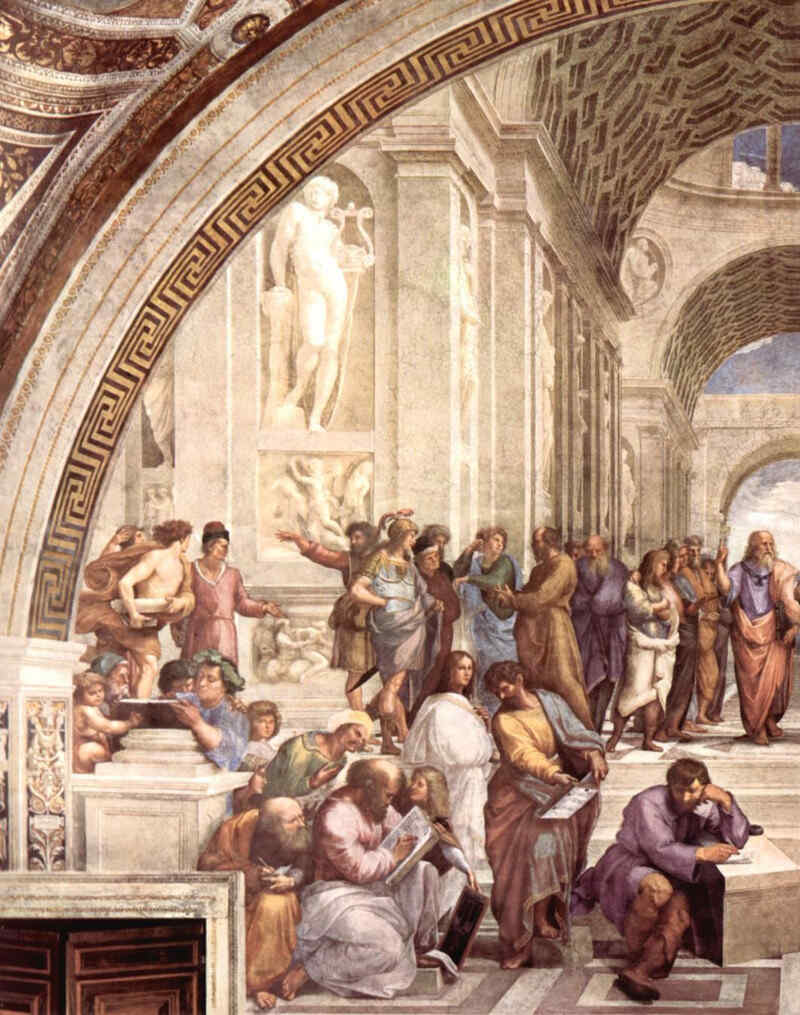 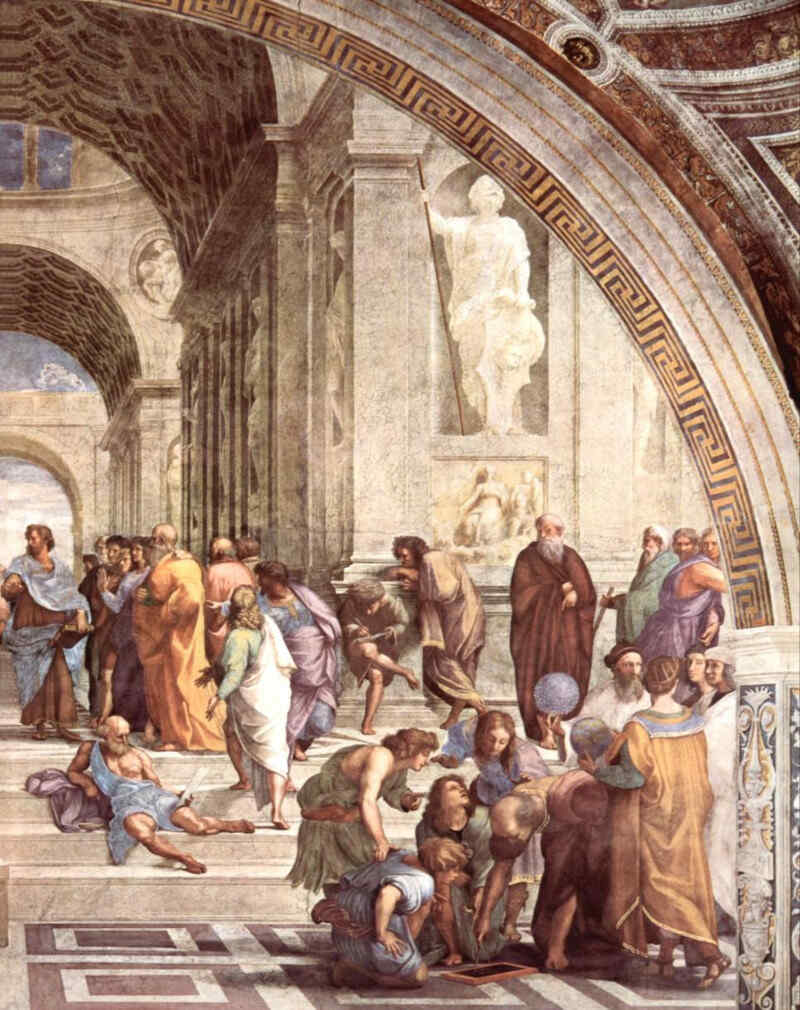 If you allow yourself to be drawn in more you will recognise the right sided figures are linked to the central main figure who is entering into speech; here on the right (205) we have everything which depends more on Inspiration, and to the left, (204) it touches more on Imagination and its equivalent. We have one more image of the central figures:  The opposite of looking and speaking is presented. Let us be clear about it—the present time can only be understood if we try to throw more and more of such glances into the past which we can do by experiencing such paintings in an artistic sense. Our time is the time in which something returns to itself. In our time there is a return in Europe—Central Europe, Northern Europe and in certain moods in Western Europe—of karmic connections with the European development of the 9th Century. This hasn't become particularly observable to most people, actually in fact, not at all. What happens today takes place out of necessity, the opposite manner used to spiritually grasp what Europe's destiny had to be in the 9th century. What had been pushed back to the East at that time was the spiritual world, so now it has once again to be manifested on the physical plane. The moods of the 9th Century after Christ are now reappearing in western European, in Central and Northern Europe. Out of Europe's east will develop something like moods out of the terrible chaos, spreading out in something like moods which will mysteriously remind us of the 16th Century. Only out of the combined harmonising of the 9th and 16th Centuries will mysteries originate which to some extent can give a degree of clarity for present day humanity who wants to rise to its own understanding of evolution. It is remarkable to see how in the 16th Century everything most secret and mysterious in nature, man and God, was visibly represented outwardly in art. The holy secret of the Trinity we have found in the most meaningful images of the world set before our souls. The opposite appears at the same time—the Protestant-Evangelistic mood which totally denies these holy secrets being able to share this historic period. At intervals Herman Grimm, a truly northern Lutheran spirit, speaks about the thoughts his contemporaries have regarding Christ, thoughts they treasure as wholly good within their souls—the exact opposite in Raphael's mood when he painted the world. You see, at the beginning of the 16th Century the Reformation brought evolution further which became the world's lot, even in Rome, in the sphere of Julius II, of the popes. But how? It became the lot of the world that people wanted to reflect about the supersensible worlds as if they were visible but visible through human development. As a result—this Herman Grimm discovered rightly—the Pauline Christianity became a particular problem for Raphael and his contemporaries—yes, even the figure of Paul himself. It can be said that up to the 16th Century Christianity was far more permeated by what one could call the Peter Christianity—Peter who saw the supersensible and sensible worlds as undivided, experiencing in the sensible world the supersensible within it, finding the supersensible in the sense perceptions. The extrasensory world disappeared from it. People were aware of this right up to the 16th Century. The experience of the Damascus secret living in Paul as a seer, and the figure of Paul himself, became a problem. As a result Raphael tried in his later development to depict, and include, Paul's figure in various paintings. It can be said: from the south a Reformation wanted to be established with the aim to depict the Pauline vision in the world in such a way as I set before you now, as it lived in Raphael's paintings which originated through the inspiration of Julius II. Paul was a problem for him. You appreciate this when you research Paul's form in Raphael's other paintings. You see a visual expression of the music of the spheres in the “Saint Cecile”.  Naturally it is inaccurately expressed. Left, in the corner, is the practical shape of Paul. Raphael made a study of Paul in a painterly way. Repeatedly Paul posed a problem. Why?—Because Paul's quest originates from within him as a human individuality through which he strives to have sight, penetrate into the sight. Here we see it in his whole attitude, in his gesture: Paul as he participates in something self-evident to others as a seeker. He develops both sides, therefore if it comes down to him, he shows Christian revelation differently. As Paul understands—you see it here, how Paul teaches—it became a problem for Raphael. Now we have another painting: Paul speaking in Athens. 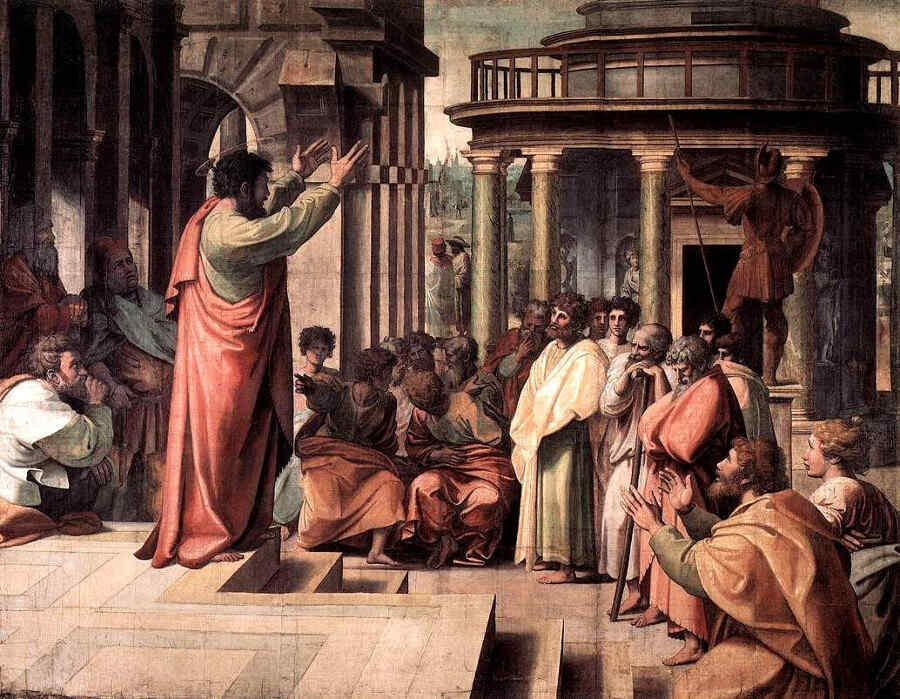 You can see Raphael studied Paul. What did Paul become for him?—The hero, the spiritual hero of the Reformation who should have succeeded from the south, but did not succeed. This impulse was pushed back and later Jesuitism from the South was put in the place of the Reformation—more about that at another time. Paul should have established the Kingdom of Christ on earth as foreseen by Julius II. Now characterise for yourself the two Paul heads, which we have before us now and allow it to really work on us.  These are heads studied by Raphael in which he wanted to depict through the physiognomy a gaze penetrating the secrets of the spiritual Christian world, into the spiritual secrets enabling words to outwardly pronounce these secrets; we have in Paul the binding link between the world of causes and the world into which only those with blessed vision have access, the supersensible world. Paul is looking and teaching, the connecting link between the world of the 5th post-Atlantean epoch and the ancient spiritual time. Remind yourselves of your consideration of the Paul physiognomy, the Pauline gestures right up to the movement of the fingers—here only the arm is lifted—and be reminded of that ...  ... consider these and then look once more at the figure in the so-called “School of Athens”:  ... and compare that to the two heads of Paul which we have looked at (235, 236) with the heads here (203) on your right and you have such a personality in whom seeing has become words, one might say: because Paul, who grew out of seeing the results of the Mystery of Damascus and became the orator of Christianity, made his pact of compromise with what can be found in the Causarum Cognitio when the experience of the physical causal world is elevated into a relation of possible experiences of divine things. As a result you will experience something like the constant “Signatur” which wafts through the “Camera della Segnatura” when you look over the image which later was called the “Disputa”, to what is called the “School of Athens”. In the “Disputa” is the truth, the spiritual truth in a nature filled space; glancing over to the other, opposite wall, so companions and visionaries encounter Paul the teacher who points to the worldly learning from which everything can arise which the human soul can find within itself. Looking at the fresco, which is the so-called “School of Athens”:  ...so one finds a soul living in the central figure with a content which is painted in the opposite fresco:  ... then one roughly has the connection. Take the one wall—everything that is within the soul, all one does not see except as the outer bodily aspect, that very aspect is revealed on the opposite wall, on the fresco of the so-called “Disputa”. I would like to say: if you could see into the souls of these two people painted on the one wall, then you will see what lives in the souls of these two people on the opposite wall, on the fresco. More about this later. |
| 292. The History of Art II: Fourth and Fifth Post-Atlantean Epochs, Medieval Art in the Middle, West, and South of Europe
15 Oct 1917, Dornach Translator Unknown Rudolf Steiner |
|---|
| Particularly in our present time it is imperative to totally understand the current 5th post-Atlantean epoch in which we stand, with all its peculiarities, in order for us to become ever more and more conscious of how affective we are within it. |
| The papacy in the time from the 9th century, before the middle of the 9th century where the ruling of Europe was so vigorously taken under control, where all relationships effectively extended, must not be imagined as the same effective papacy in a later century or even today. |
| This is what we find towards the conclusion of every time period, towards which Rome out of such a deep understanding through the three to four centuries created in the European realm, which wanted to rise out of folklore. |
| 292. The History of Art II: Fourth and Fifth Post-Atlantean Epochs, Medieval Art in the Middle, West, and South of Europe
15 Oct 1917, Dornach Translator Unknown Rudolf Steiner |
|---|
I think that it is good right now to become familiar with the most varied areas of life and the laws of existence which I have been referring to during these lectures. I want to say these laws of existence take on an importance in their realm of the spiritual life, an importance of being, which up to now has frequently not been taken into account in world opinion. Particularly in our present time it is imperative to totally understand the current 5th post-Atlantean epoch in which we stand, with all its peculiarities, in order for us to become ever more and more conscious of how affective we are within it. You know of course that we consider the beginning of the 5th post-Atlantean epoch beginning at the start of the 15th Century, from about 1413 onward. The beginning of the 15th Century was a significant, profound, incisive point for western humanity. The creation of such an about-turn which came about didn't happen all at once, it was preparatory. In the first moments of this epoch one only sees a gradual expansion. Old patterns from the earlier epochs transform into the new one and so on. Preparations were being made for a long time which were only really being experienced as a mighty reversal at the start of the 15th Century. If we want to consider another strong western historical impact in the centre of the Middle Ages, we may look at the rule of Charlemagne from 768 to 814. If you wish to visualize everything which happened in the West to the furthest boundaries up to the time of Charlemagne, you will have difficulties with this self-visualization. For many observers of history today such difficulties do not exist because they all shear it under the same comb. Only for those who want to look at reality, will such deep differences exist. It becomes quite difficult for people in today's world of experiences and impressions to reach a concept about the completely different condition of life in Europe up to the time of Charlemagne and beyond. We may however say that after Charlemagne, in the 10th, 11th and 12th Centuries a time began in preparation of our own epoch, the 5th post-Atlantean epoch. Up to the time of Charlemagne old relationships actually flowed which in our present day, as we have already said, we can't have a true imagination. Then again preparations were beginning for a new epoch, and in these three centuries, the 10th, 11th and 12th—it started in the 9th already—events took place in Europe in all areas of life producing forces which were expressed later, particularly in the 15th century. One can say these centuries just mentioned was a time for preparation but people today are hardly inclined to refer to this just as little as they will say Rome is in control of European affairs. The papacy in the time from the 9th century, before the middle of the 9th century where the ruling of Europe was so vigorously taken under control, where all relationships effectively extended, must not be imagined as the same effective papacy in a later century or even today. It can rather be said that in those times the papacy knew instinctively what the most important areas of life needed, in west, central or southern Europe. I already pointed out last time that the oriental culture was gradually pushed back; it had to wait in eastern Europe, in Byzantianism, in Russianness. There it waited indeed, waited right up to our present time. General observations can develop particular clarity in those areas which, in the broadest sense, one can refer to as artistic. If you want an idea about what had been pushed back at the time to the East, what the west, central and southern Europe should not acquire, if you want to reach an understanding about it, then compare it with a Russian icon:   In the picture of the Virgin Mary of the East is an echo of what had been pushed back into the East at the time. In such a picture quite another spirit holds sway than can ever be found reigning in western, southern and central art; it is something quite different. Such an icon picture still today presents an image which has been born directly out of the spiritual world. If you imagine it in a lively manner you can't imagine a physical space behind the Russian Madonna image. You can imagine that behind the picture is the spiritual world and out of the spiritual world this image has appeared: just so are the lines, so is everything in it. When you take the basic character of this image as it is born out of the spiritual world then you have exactly that which had been held at a distance in the 9th Century from western, southern and central Europe:   Why? Such things should be thoroughly and objectively considered historically. Why did this have to be held back? Simply on the grounds that the nations of Europe—central, western and southern Europe—had completely different soul impulses which were not in the position to understand humanity out of original elementary nature, this was being pushed back, stopped in the East. The nature of the western European soul was quite differently focussed. When this which was being pushed back to the East was transplanted into central, western and southern Europe, it could only remain external, outside the east of Europe; it could never grow together with the central, western or southern European soul distinctions. An area had to be created in western, southern and central Europe, an area for what gradually wanted to come out of the depths of the very folk soul itself. I would like to say Rome, in actual fact, understood this with genial instinct. With disputes regarding dogmatism showing quite a different character, the content of dogma disputes is not the real story; the content of these disputes is merely the final spiritual expression. It goes much further. Among other things it was about what I have just been characterising for you. So we see that from the 9th Century and into the next centuries Rome worked ever more strongly for a space in Europe where the real striving of the folk souls could unfold. The striving of the folk souls also appeared in greater clarity. You see, when you focus on what could have been brought to the fore if the eastern influence had not been pushed back but could stretch over Europe—Charlemagne made a large contribution - if it had stretched over Europe then Europe, as I've already mentioned, would have made available certain observations of representations which speak directly out of the spiritual world. This did not happen, firstly because Europe had to prepare itself for the materialistic 5th post-Atlantean period which was prepared most intensely in central Europe. Interest centred mainly on everything other than what came directly out of the spiritual world like line, form and colouring. Humanity was interested in something different. Above all there was an interest in Europe for contemporary events, for reporting and for results. By studying individuals, singled out in humanity, you realize they have positioned themselves in the course of historic, relatable events. The 10th, 11th, 12th Centuries can also be called the Germanic Roman Empire because from Rome the capacity was created, a capacity which spread for an interest in relating stories, an interest in the working of time and for conceptualising a particular form set in time. You see, this is again a different viewpoint from the viewpoint I indicated in similar lectures in previous years. This cooperation of the central European empire with the Roman church and its spread is an inner image of the way the 5th post-Atlantic epoch prepared central Europe at the time. From this it is clear that central Europe prepared itself in this period with very little interest for spatial educational art. Constituted informative art became borrowed - just remember the presentation which I gave you in previous years—borrowed from what came over from the East, spread, one might say, through to the very joints of principal interest. What shot up out of the folklore itself was being told. The content which was to be told had to be taken out of national character, intimately connected with nationality. You can encounter amazing images of central European life, life in the areas of the Rhine, the Donau and the northern coastline in the depiction of the songs of the Nibelungen, the Walthari and `Gudrun'. The manner and way in which these writings are presented indicate their obvious interest in events of the time. Look how in the time of Charles the Great when the poem `Heiland' originated, the stories of the Gospels are woven into the poem with central European characters, characters extracted from biblical events and placed directly into the central European interests of the `Heiland'. It had to be born out of the life of the European folk soul. Through this the eastern tradition, which cares little for the temporal and historical, was pushed back. For this reason, it was pushed back. If we observe how these concerns of the European nations rise from deep underground and reach the surface, then it is often only possible, and with difficulty, to really penetrate into the depth of feeling, into the deep soul experience which the European human spirit connected to in its own deepening encounter with the essential spiritual events. One might say, that which was pushed back to the East from spatial infinity and its manifestation out of space, which had to appear superficially in central Europe should reappear directly out of the human souls themselves, out of the depths of the soul, not out of the widths of space—but out of the depth of souls. The mysterious prevailing of soul depths under the surface of direct observation was already something living at that time in human souls. During the centuries we've been talking about, people were instinctively permeated with the knowledge that their souls had in the depths of their being secret impulses, appearing only sometimes at celebratory moments in their soul experiences. Life seemed deeper than what the eyes could see, the ears could hear and so on; something unfathomable rose from soul depths as a profound experience. I could say we experience an echo of this kind of thing when we hear something as beautiful as the poetry of Walthers von der Vogelweide, who to some extend created an ending to a purely linguistic age, an age when the ability to depict formless manifestations in soul depths in a pictorial manner had not yet developed. In these soul depths we are stirred when we allow Walthers von der Vogelweide's small poem to work on us, where he speaks about his own life in retrospect. Maturing as a man when knowledge grew in his soul and light fell on his soul depths from which knowledge had previously appeared as mysterious waves in a dream, now appeared in a mood, he expressed as follows:
Thus speaks Walther von der Vogelweide at the end of the three long centuries, the 10, 11, 12th centuries, the epoch in which the Holy Roman Empire blossomed at the close of this time period. It was the period of time in which the interest for current events developed. Art demanded expression, images were to express events happening and going to happen in central, western and southern Europe. A glance to the East gives the impression of existence and peace, of a quiet contemplation out of the spiritual world. Events directly taking place here, born in the human soul, binding the soul with the greatest of all, the most mysterious, all this was eager to be represented in a pictorial manner. Fertilization from the South was needed anyway, where echoes of all the traditions having come from the East were still maintained. Bringing events to expression was the primary goal. In this way striving in art was contained in the West, one might say, in two opposing streams, for certainly the representation of existence was pushed back East, but only pushed back—many things remained. Above all, something remained which can be observed in the East where strict rules determined the depiction of the icons, and old rules were being adhered to, where no violation was allowed through lines, expression, and so on. All this was transplanted into the West and alongside this was the requirement for everything experienced in the surroundings, united with traditions coming into central Europe from the South. Naturally depictions with this requirement firstly appeared in primitive, simplistic images according to biblical narratives, Bible stories. Only at the beginning of the next three centuries, the 13th, 14th and 15th did a power, one could call it, rise up out of Central Europe which could depict image-rich pictures. This power is thanks to specific facts; facts which during these centuries, the 13th, 14th and 15th, expanded and matured over the whole Central and Southern Europe as something one could call city domination, the blossoming of rural development. The cities, so proud at the time of their powerful autonomy, developed the particular powers of their folk in their midst. Such cities were not uniform, either as the old Germanic Roman Empire which was in decline, nor uniform as in the later state communities, because these cities were autonomous and could develop their individual strength according to the needs of the specific land, lifestyle and place. One doesn't understand the times of the 13th, 14th and 15th Centuries if one does not again and again glance at the blossoming of city freedom at the time. Let us visualize this flowering of city freedom—by roughly taking the 11th to 15th centuries—and consider what this freedom in the cities discovered in relation to art impulses. Some traditions originating from Rome remained. The main issue had been pushed to the East; yet some traditions remained behind, traditions of alignment, colour application and, in relation to facial expression, the eyes and nose had to be done in a certain way. Yet all of that counteracted with the aim to represent facts. These battles had two sides, we can see it here where the artistic element first only dares to appear, turns from within itself outward, where, I might say, the trained monk from Rome allows himself to be inundated with the influence from central Europe, the impulse to not merely depict biblical events but that the imagery appearing in the Bible, which are glimpses from the spiritual worlds, are depicted in such a manner that the Bible itself becomes the very expression of how people live in daily life. This was now imposed on the monk in his solitary work. When he paints his miniatures and represents biblical scenes in a small manner, he must be accountable on the one side for the remains of tradition and on the other side, what wants to manifest as life under the surface. Today I have two such miniatures to show you from which you will see, how during the 11th, 12th and also in the 13th Centuries the battle between traditional painting and history was still visible in small paintings. Look at such a painting from an evangelist representing the “Birth of Christ”—we considered this image in previous years.  See how much you are reminded of the tradition of mere existence. Consider how still here, I might say, these figures are shown in such a way which does not reflect how people in an outer naturalistic reality live but observe how the figures are born out of the imagination people made up of what the spiritual worlds were for them. From there the saints, the Christ figure himself appears; all this came out of another world. Behind the surface of the painting we can only imagine the spiritual world—of course pictorially and radically spoken. Above all there is no trace of naturalism. Observe how there is no trace of perspective, no trace or an attempt in this painting to somehow represent space—everything is on the surface, all but intellectual representation. Despite all this, when you look at the single figures, you experience the urge of something wanting to be expressed. You will notice there are two things fighting with one another. Look at the face on the right and the one on the left and you will see how the eyes, maintaining something from tradition by the person in his monk cell had a thought from his teaching that somehow or other eyes had to be done, this and that way the expression had to be done—but he battled with it, he adjusted to a certain extent the view of the situation to the events. Even in these tiny paintings made in the gospels, in books of the bible, this battle of the two elements can be seen in a struggle. Besides this you see again, for example in Cimabue even more, how existence was expressed in the oriental form. How we are absolutely reminded of the angel figures above - which already appear when it comes to Cimabue as an oriental echo of the conception of the pictorial—as a proclamation out of the spiritual world itself, as an experience of being, not of historical events! Another test is the second picture, which I have prepared, which comes from the Trier Gospels:   Here we see the proclamation to the shepherds, above is Christ's birth. When you take this shepherds' proclamation of the angel announcing “Glory in the Heights and peace on earth to men of goodwill”, when you take this you discover a mixing of these two impulses. In all three of the men's faces we find the endeavour: represent the facts! On the other side however everything at a distance is about natural observation; how traditions play into this! I would like to say, feel how the wings of the angels are in the book: wings should be depicted in such a manner that they are at an angle to the main scene, pointing to both sides, and so on. You sense the requirement and at the same time sense such a depiction impinges on the endeavour which can't be achieved according to the observation of historical events. Sense this and observe in all of them how little nature observation is apparent, how there is no trace of spatial application, no trace of perspective in this image, that everything is, I want to say, or implied in the place where they are depicted due to requirements of how something like this was to be done, teach, while still substantially in control. Now we see how at the end of the three centuries of the Germanic Roman Empire the impulse from the establishment of cities to depict history and unite it with the requirements of experiential representation, how this urge in Central Europe came to a sudden and most beautiful flowering. Cologne is one of those cities where the city's freedom flowered the most intensively and at the same time had the possibility, through intensive expansion of the Roman Catholic dominance, to take up traditional design art coming over from the East. No wonder as a result that just in Cologne the possibility encounters us in how, in the most wonderful way this comes together, weaving the two impulses into one another: the one most ancient and revered tradition depicted—what a Madonna looks like—and the urge to represent history. How a Madonna had to look like—in the East was petrified spiritually, majestic, serene, but still, solidified. It had to wait. Movement was brought in from the West. The revelation brought in from above, from heaven, revealed in the Madonna figure, is to be experienced in the Russian Madonna as magnificently elevated and permeated with something one can see directly: the greatest beauty possibly revealed in a human face, the loveliest direct expression of the ability to love, human friendliness, human goodwill, everything living in the surroundings lived in an inner relationship with the revealed figure of the Madonna. Consider this and then look at the painting done by Master Wilhelm:  Here you can see what I actually want to point out: you can see how an attempt is made to bring life, that means events, into being in the Virgin Mary depiction. Here individual observation merges with tradition right into the details, one might say: old prescriptions were only applicable to attitude, nobility of form, serenity but not much further than in the expression of line, thus tradition was already being experienced from individual observation. This is what we can admire so much in these masters. Another painting by the same master:  Another painting by the same master ... to indicate what I have just mentioned, shown in another representation. Consider just how much has come through the traditional heavenly figure, the revealed form of the Redeemer's face, of Veronica's face, in which we can see something revealed directly out of soul depths. See for yourself how those angel faces looking up are already individualized! Consider how with this image, as a result of the individualizing of figures it is no longer possible to actually imagine heaven behind it. However, something else is possible. At the back of the image, which came out of the Eastern inclination (245) we can actually imagine the spiritual world, something in addition to what the image presents. Here (237) we can also imagine something else; we must feel something different from what the image depicts. We feel much of what has gone before due to knowledge from the Bible; we feel much of what has resulted, events have been experienced and what is depicted are scenes from before and after. Thus there is not something like a spiritual realm behind it; the experience is of something before and something afterwards. When the singular is represented—visual art does this after all—then a single element is lifted out of the events. This is what we find towards the conclusion of every time period, towards which Rome out of such a deep understanding through the three to four centuries created in the European realm, which wanted to rise out of folklore. The conclusion appears to us and how this works in Cologne, by such genial Masters being capable of creating something like this. These two intertwining impulses which I have characterised flow together most remarkably here. Now I would like to indicate their power which had worked everywhere by showing you a couple of paintings, starting with Constance who probably learnt from this and many countries through which he travelled, to arrive in Cologne and gradually became the follower of so-called Master Wilhelm, Stephan Lochner. The first is the image of the Virgin Mary—we know it already:   In this image—you need only compare the single heads—you already notice the individualizing impulse which is fully expressed by the figures. This aspiration you can observe. You hardly see a tendency to use space; everything is on one plane, you see no possibility of somehow applying perspective, but you see the yearning, the desire and instinct which can be declared as events, fixed in the imagery, you see the desire characterized; you see the past and what will follow established in the imagery as a scene. Now I ask you to look at the two preceding demonstrated paintings (237,238) by the Cologne masters which appeared when these masters were blossoming, somewhat around the years 1370 to 1410, therefore directly during the time the fourth post-Atlantean epoch was coming to a close. This painting by Stephan Lochner (239) already falls into the fifth post-Atlantean time. I have shown you images in consecutive order between the boundaries of the fourth and fifth post-Atlantean time. What are the particular characteristics? Don't we see particular characteristics playing into representations in the 5th post-Atlantean time? Don't we see in the lowering gaze of Mary, the blessing little hand of the child, the differences in the right and left figures' expression, in the individual depiction of the additional figures—do we not see the characteristics of the 5th post-Atlantean time—how the character's act in the pictorial representation? Do we not see how the impact of personality arrives? Above all, don't we already here see the desire to express the element of the 5th post-Atlantean time within the imagery, the most important element for Central Europe: light-and-dark or chiaroscuro?—How little meaning the distribution of light and dark had in the old tradition! People lived in light and shadows but were not observing it, yet were feeling it - because they experienced light bringing joy, sensing life in light while darkness sank into rest, in darkness they withdrew into mysterious soul depths. This inner living in the world in the souls of single individuals which particularly comes to the fore in the 5th post-Atlantean time, as well as the application of chiaroscuro, indicate a distribution of light masses: in the middle the light is above the Child, we see this light dividing itself right and left in single masses, becoming lighter upwards, no longer completed as in earlier version only in a golden ground, but in a brightness. Thus the encroachment of individual characters is what we see here; nobody can actually look at these consecutive elements which I have demonstrated to you, without becoming aware that something, albeit quietly, but something new was coming into the 5th post-Atlantean time while the 4th post-Atlantean epoch faded. Let us look once more at the previous Madonnas:   Memorise this child's face well and try to feel how much tradition still lives in it. Now consider once again another one:  Look at the Madonna and the Child and note how a really new impulse has entered just like a new impulse does enter with each individual. Considering the following paintings of Stephan Lochner. I want to stress that Stephan Lochner originated from a region where most people were incapable of absorbing tradition because most of them had the impulse to develop individualism. It is the region around the Bodensee in the region of Bavaria, the area of western Austria. Here the tribes strived out of their folk nature towards individualism, mostly rejecting tradition. Stephan Lochner was lucky, one might say, to aim for the Bavarian anticipation of individual expression, where, despite the striving for the individual, there still lived the great sublime sacred tradition of olden times. As a result, his individual impulse, much more pronounced than Master Wilhelm with his radical individual urge, he connected to his revolutionary individuation impulse with the smooth, typically Cologne imaging tradition to produce this image. For an artist like Stephan Lochner depicting space within art had not yet been invented; to depict space could simply not be done at that time in Cologne, but his soul tried to introduce this into the images. Fully within the historical events, completely within development this can be ascertained by a comparison between the Virgin Mary image of the West compared to that of the East:  Look at the next image:  ... which you also know already; look at it particularly in the way the specific fits into the general, so typical in Stephan Lochner's work, how the dark and light come to the fore even if there is no continual intention of capturing space, to indicate perspective, but in the chiaroscuro we see another kind of spatial capture than that of perspective. The perspective is more to the South, one could say: invented by Brunellesco—I have explained this to you in previous years. And now …  ... in which you see there is no trace yet of composition and how here also, where the depiction would have insisted on a study of space, there is nothing about space, and how on the other side an attempt is made to depict each of the six accompanying figures as individuals, with an attempt to individualise the Redeemer Himself. Please recall the paintings of the Cologne Masters (237, 238) and compare these with the paintings of Stephan Lochner (239-242) which we have seen. It can't be overlooked how deeply this incision imprints on us what lies between the two: because this incision lies between the 4th and 5th post-Atlantean epochs. Stephan Lochner attempted to depict soul qualities, but he looked for representation in nature to find forms which express the soul. Master Wilhelm still hovered in a supersensible experience of the soul and his impressions came out of his inner feelings. He didn't depict them by looking at a model. Here (237) we still see a reference to the model in order for the soul itself to identify with it. Master Wilhelm still expresses his own feelings. Stephan Lochner is already a copier of nature. This is in fact realism: realism rising. We can clearly draw the boundaries between these two so divergent painters, during hardly decades. So you see how the laws which we search for in spiritual science really come to expression in single spheres of life when these spheres are not taken as unimportant, but with their importance are led before the soul. Now I would like to place this fact once again before your souls, by introducing two painters who worked more in the South. This took place in Cologne. Let us look more towards the South, to Bavaria, Ulm or the Rhine area and we will see the how conditions appear before and after the incision of the 5th into the 4th post-Atlantean epoch. I want to present two paintings to you by Lukas Moser, who lived in the beginning of the 15th Century, who can certainly be counted as being from the 4th post-Atlantean time. Look at these paintings:   Try to sense how everything painted in it is done in such a way that one notices how the painter went through schooling which insisted: when you place figures beside one another you must place the one facing you, the other in profile; when you paint waves, you must paint them like this. Thus you see the entire play of the sea's waves, not as they are observed, but “according to the rules”; you see the figures as prescribed “according to the rules”; nothing observed, everything composed. This image from the Tiefenbronn altar thus depicts the ocean voyage of the saints. The following image shows the time of repose, the night time rest of the same saints:  ... A medieval house built on to a church, strongly suggestive that nothing was observed but everything was painted out of the head. Look at the sleeping Saint Zedonius: he still wears the mitre as well as his gloves. It had to be painted according to the rules where the main interest is located. Consider this as an ongoing journey, because the saints are taking a trip, they sail on the sea, they rest at night, it tells a story. Yet it is presented as set out in an existed image remaining within tradition. Lazarus resting in the bosom of this mother! We can look back to representations of earlier times when we have such an image in front of us. This is at the point where the 4th post-Atlantean time came to a close. In the West there were still prescriptions regarding how church imagery should be painted. Painting was done according to particular traditional rules. The painters obtained their method out of tradition: this is what the Saint Zedonius looked like, what Saint Lazarus looked like, Saint Magdalene and so on; they had to be painted according to prescriptions, not quite as strictly as in the East, but still according to the laws. However, he still had to depict desires, instincts and reveal a story! In this way the elements swim in and around and battle with the end of the epoch. Let us also look back to the 13th, 12th and 11th centuries. In all the churches strict rules were set. Each picture had to look the same as another right through the whole of Christendom, only with a slight variation in the way the things were ordered. If Saint Zedonius was ordered, then he was to be painted according to prescription - that was the tradition. Let us now think of the incision of the beginning of the 15th Century and go from Lukas Moser, the last latecomer of the 4th post-Atlantean epoch, over to Hans Multscher and see how these painters really already stood in the beginning of the initial blossoming of the 5th post-Atlantean epoch. Look at these paintings:  ... and you observe how in these paintings the individual-personal appear, characterising the personality. Moser does not have any desire to look at nature. Here, (399) you find an artist who strives to work out of the soul—yet who does not have the slightest inkling of spatial treatment and above all mixes up multi-coloured things in relation to space and perspective - yet who strives to characterise it out of the soul, in such a manner as if nature itself is characterised in the soul. He already tries to depict individual figures.  It will become even clearer for you, what I've just been speaking about, particularly when you look at the three sleeping figures below. There is already an attempt, first of all, to express the soul element, but there is also an attempt to depict the nature of those sleeping. Compare this with what you can remember about the sleeping saints on their sea voyage (335) the resting time (336) and then you will realise what a mighty incision lies between these developments. See how the light-dark depiction is consciously brought in. Solely characterized this way and not by working with perspective does the painter reveal spatial relationships. Perspective is in fact incorrect because an actual cohesive vanishing point can't be found in any area of the painting; nowhere can a central point be found from where the layout is arranged; yet still a spatial relationship of a certain beauty exists through the chiaroscuro.  Look at this “burial” scene. You find everything, even in the depiction of the landscape itself, as characterised by the individual's penetration of tradition: interest in events without any indication coming out of the spiritual world.  You see here how particular individualizing elements enter the entire painting, an attempt is made in a corresponding manner to represent the guardians, the twist of their bodies enhancing the individualisation. I ask you to look up, to the left, how an attempt was made to represent the figure's particular situation, his unique experience, portraying his peculiar individual inattentiveness. Try and imagine how the painter tried to show the front view of the head, how on the right he characterises the skull of the other guardian, from behind. One can see how the attempt is made to show individual forms and also how the chiaroscuro comes in. One can see how through individualising, depiction of spatial element enters while perspective is not at all yet clear. You can imagine the point from which the individual lines go from the characters, but now you need to think apparently quite far towards the front, where the coffin is placed and you have to think again about another reference point—regarding the trees! These are painted in full frontal positions. I wanted to show you how the legitimate developmental impulses I spoke about already last time in the Italian paintings have a profound effect and what rises as characteristic in our time, originating from the 15th Century, can only now be understood if you clearly take the entire, deep meaning of every time period, from the beginning of the 15th Century, which built the boundary between the 4th and the 5th post-Atlantean epochs. What transformed itself here had already been living in all the events and becoming of Europe, but it was pushed back from the 9th Century because Europe was made incapable at that time; Europe first had to allow something else to take form out of the depths of its being. Those in the East waited in the meantime. We should promote an awareness today for what waited there and what wanted to rise to the surface in the East because these forces are available, these forces weave into present day events, still wanting to be active. A clear understanding of what pulsates through the world, what works in the world, we need to take possession of, this which is an urgent requirement for the present time epoch. This I am now and have repeatedly stressed in the past. Through the development of the middle age art in its characteristic time period I wanted to make this clear for you. You see, here we approach two incisive waves in history: one swell is everything which came easterly from the south, the other is, I would like to call it, coming from the depths itself. In these centuries - 13th, 14th and 15th, in the centuries of freedom in cities, what wanted to rise from soul depths to the surface was most strongly applicable. Then again from the 16th Century another setback came - development rose and fell, oscillated—and then, obviously not simultaneously, the continuation of what had been started in of the 15th Century became outwardly visible as I've indicated to you, on the one side living in van Eyck, on the other side Dürer, Holbein and so on. We see in the lower lands, towards Burgundy on the one side and Nürnberg on the other, Augsburg, Basel, the results of what wanted to come as a wave rising from soul depths to introduce the 5th post-Atlantean period. I wanted to introduce only one of the impulses of this 5th post-Atlantean epoch to you. About other impulses I have various opportunities to speak at the moment. |
| 292. The History of Art II: Greek and Early Christian Art, Symbolic Signs, the Mystery of Gold
22 Oct 1917, Dornach Translator Unknown Rudolf Steiner |
|---|
| If one considers it in this way, then your mind understands the deepest mystery of gold. What did Siegfried's friend tell him? What does the Nibelungenlied say? |
| Learn once again how humanity experienced not mere air moving over the earth but that there is spirit above the earth, spirit which must be searched for; that beneath the earth there is not only stuff which they could take out with the aid of material tools, but that which was to be unearthed from the sub nature had to be offered up to the super-sensory. To understand mankind again, that is the mystery of gold! Not only spiritual science teaches this but this can also be learnt through the real understanding of the history of art in a spiritual sense. Oh, how terrible it is to see how the present day humanity wait day after day and do not want to understand the necessity to grasp the new; that they make no progress through old, worn-out imaginations. |
| 292. The History of Art II: Greek and Early Christian Art, Symbolic Signs, the Mystery of Gold
22 Oct 1917, Dornach Translator Unknown Rudolf Steiner |
|---|
Today I will introduce some observations and the way in which these will be presented will appear to be more loosely connected than those of the previous discussions which I have been giving you during these past weeks. Despite the aphoristic form in which I will speak today there is still a part for future considerations; I'm thinking of the next time when it will be possible to come back to some items which were attached to these contemplations in order to arrive at a culmination, a world view tableau, which I believe is necessary now, into which the human being may be placed. Today I would first like to show through some observations which can't be supported by images—because I don't have images to illustrate this—how within history, within Europe's unfolding evolution during the last two to three centuries the most varied impulses worked together, impulses of a threefold nature. There were of course actually an infinite number of impulses but it is actually sufficient to look at particular elements which are the closest to reality in these impulses. We live in the 5th post-Atlantean epoch. We stand in this epoch which expresses itself outwardly in many antagonistic and battling impulses these days. We live right inside many things which admonish mankind to be ever more and more awake for what is happening around us. One can say that never in the unfolding of history, as far as it can be researched, is mankind so called upon to wake up. In no other time had mankind shown such sleepiness as in ours. In this 5th post-Atlantean time with its particular impulses which we have come to know through our anthroposophical considerations, there play echoes of the 4th post-Atlantean time into it, but also echoes of the 3rd post-Atlantean epoch. Inside all that is bristling and playing in our present events we can distinguish between various things but today we will focus from a particular viewpoint on three principal impulses, echoes of the 3rd and 4th post-Atlantean epochs and how these work on our present 5th post-Atlantean epoch. In the 4th post-Atlantic epoch one element asserted itself in particular—here we approach the development in art for our observation—in particular, and most valid, in artistic development's depiction was what there was to be discovered within the human being him- or herself. The Greeks and after them the Romans strived to present time and space as experienced within themselves as part of being human. We know why this is so; we have often considered this. In other cultural forms of the 4th post-Atlantean epoch, the Greek-Latin time, this also revealed itself and we find it expressed particularly in art. As a result, in the Greek time period typical individuals were idealized and particularly elevated in art. One could say the highest, most elevated form which could be found in the sense world were the beautiful people who took on such attractive forms and wandered around at that time, in the most beautiful movements in the widest sense of the word—Hellenism strived to depict them this way. During no other time of earth's development can such a similar striving be found; because each epoch of the earth's evolution has its particular impulse. Within this representation of the beautiful humanity of the 4th post-Atlantean time was a resonance from the 3rd post-Atlantean time. This echo was not limited to a particular territory but rayed out over the cultural world of the 4th post-Atlantic epoch. Thus one can say: the 3rd post-Atlantean epoch became particularly active by influencing the 4th post-Atlantic epoch and continued to be active, even though it was now a weak echo, in the 5th post-Atlantean epoch. As Christianity and the Christ impulse spread, it had to deal with these interweaving impulses. Art impulses simply could not unfold in the 3rd post-Atlantean time on the physical plane as was the case in the 4th post-Atlantean time, because even in the 4th the depiction of the physical world was granted through beautiful people, in beauty humanity was created. The 3rd post-Atlantic epoch had to express many more, even if they were atavistic, internalized impulses. In order to bring this about, it had been necessary to reach back to grasp this kind of impulse from the 3rd post-Atlantean epoch, in a certain sense. Thus we see, while the Christ impulse spread through the world, the artistic depiction of beauty within humanity reaches back, and sometimes has an impact which is like a kind of renewal of an impulse from the 3rd post-Atlantean epoch. The Greek impulse which brought art to such a blossoming, quite within the style and sense of the 4th post-Atlantean epoch, had to preferably be limited to express growing, flowering and thriving. Beauty for the Greeks was never adornment. The idea of embellishment was unknown to the Greeks. The Greek had the idea of everything alive, growing and flourishing. The idea that embellishment could be added was something which came much later into the world again, namely in the continuing cultural development. The idea to which the Greek world was the furthest removed can perhaps be found in the word “elegant”. Elegance was unknown to the Greeks—elegance which the living used to bedeck themselves with adornments so that they would “shine” on the outside—this was unknown to the Greeks. The Greek only knew form and expression as originating from what was alive itself. The impulses of Christianity also represented death; the Greek epoch mainly represented all that sprouted, grew, and was life-giving. The Cross of Golgotha had to stand opposite Apollo. Yes, this was the great task of humanity, the great artistic work of humanity, to work against death, in other words all that could come from the world beyond because Hellenism regarded ideals sensually represented as its highest accomplishment. This becomes obvious in all that is juxtaposed in an artistic expression. This is evident when one sees how artistic skill strived to express the beautiful, growing and blossoming, youthful and prosperous people. This artistic skill brought the Greek-Latin time particularly far. One can also see how Hellenism was already growing in the first artistic Christian creations, but how simultaneously these artistic creations struggled with what couldn't be captured in the physical world or dealt with artistically. As a result, we see how the perfection of the representation of youth, vitality and prosperity is placed beside the still clumsy representation of death, eternity, including infinity which is the door to it all. I have put together two motifs from the ancient Christian art of the first centuries, to illustrate what I'm trying to present. Firstly, the “Good Shepherd”: 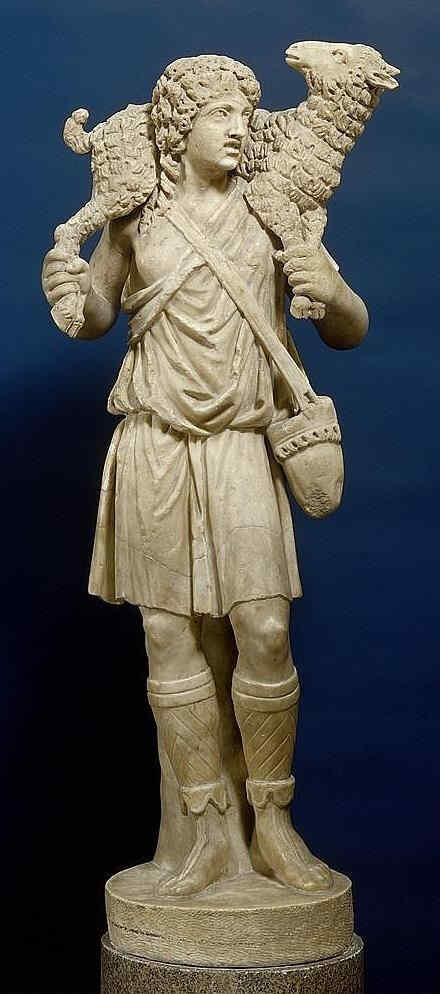 ... a statue to be found in Lateran, in which you can see how the artistic skill is presented in the growing, blossoming and prospering element, the vitality as it grows within the Christian art; if one believes that the Jesus figure is linked to the “Good Shepherd”. Greek art was dedicated to life, dedicated to depicting the world of the senses with the human being as the highest accomplishment of life, who in death will grasp the consciousness which alone will give access to infinity, eternity, and the supernatural. One can see how they tried to adapt this to Apollo, Pallas Athene and Aphrodite who really represented youthful blossoming, growing and thriving, how this development wants to merge with the other form, yet still holding on to the striving in the artistic sense, with death, the infinite, towards the supernatural. This is the echo in art which came out of the sense world and became the magnificent flowering in the 4th post-Atlantic epoch. Now we take another artwork carved out of wood—coming from about the same time period—the representation of the crosses on Golgotha: 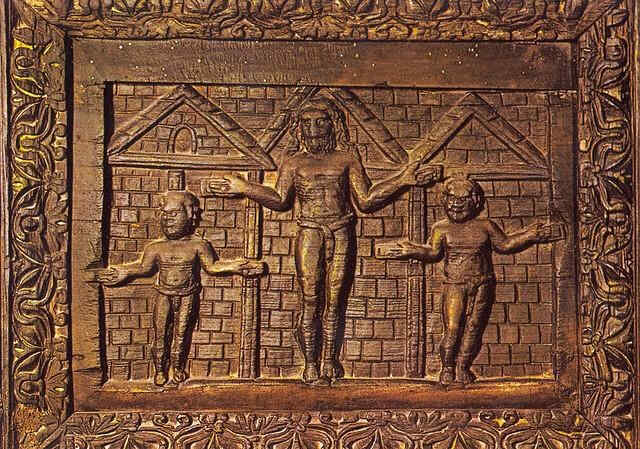 Christ on the cross, between the two thieves. If you look at it you realize how unskilful it looks in comparison with the previous image. The mystery of Christianity could not be mastered artistically, it still had the work of an entire century ahead. During the very first centuries of Christianity one finds such inadequate representations of the central mystery of Christianity. One can already say that these things should not be taken up in the sense of false aesthetics or in hostility towards sensory impressions, because the gaze, the soul gaze during the first Christian times was focussed on the mystery of death, which had to be validated in a super-sensory way through knowledge of the Mystery of Golgotha. By believing one is connected to the mystery of Golgotha, it was believed that one could grow into feelings and experiences and see the infinite validity of the human soul which lay behind the door of death. No wonder that as a result, in the field of the most varied cultural forms of worship of the dead during the first centuries this was particularly noticeable in sensitive Christians. So you see why this characteristic style which I want bring into expression is directly linked for you in the Good Shepherd (661) to this “Representation of the Mystery of Golgotha” (662). Thus we see the characteristic style in the artistic creations of the first Christian centuries depicted in reliefs and most of all in the carved reliefs found in sarcophagi. The dead, the remains of the dead, memories of the dead combined in the sarcophagus, are linked to the Mystery of the Dead, this was a profound need of the first sensitive Christians. The secrets of the Old and New Testament were the favoured elements to be depicted on the walls of the sarcophagus. To study the sarcophagus art of the first Christian centuries in particular, means to delve into what was being done in Christianity, to a certain extent the Mystery of Death is also there, where it shows itself in reality: with the sarcophagus, expressed artistically with the mystery of death, it is brought together with the knowledge of the revelation of everlasting life, with biblical mysteries.  So we see for example the sarcophagus of the early Christian art: 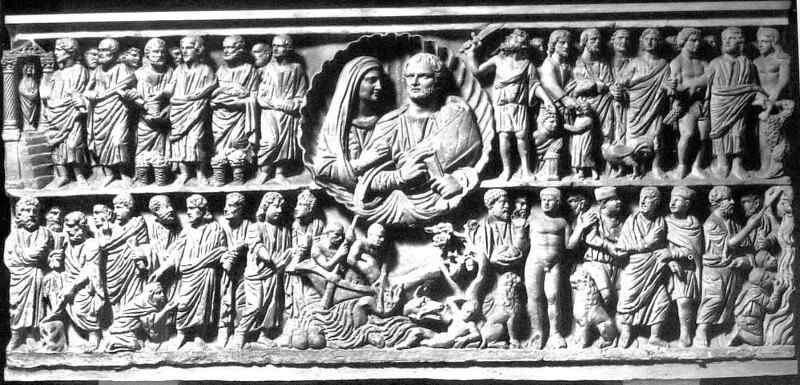 In the centre is the married couple to which the sarcophagus is dedicated, presented in portraits, then the two rows above and below of biblical scenes from the Old and New Testaments. It starts, as you can see, at the left top with the resurrection of Lazarus. You then see the continuation, to the right of the rounding shell, the sacrifice of Isaac, continuing further one recognises the betrayal by Peter. Below, right, you see for example—they are all biblical figures—here it is unfortunately too small—above and below are Bible scenes. We see what Greek art created up to its culmination, the free standing human figure, which here has to be squashed into reality, but reality connecting this world to the world of the afterlife. So we see the figures lined up. Here we see the free depiction obviously impaired, this impaired composition is exactly what we want to look at in particular. In this example we have for example a sarcophagus configuration, an extraction of the materials in form, as an example of an entire composition pressed into it. Please look carefully, the entire composition is compressed and composed of human forms. Overall we have physical forms: Moses, Peter, the Lord Himself, Lazarus being awakened, Jonah there in the centre; thus we have the composition, possibly reducing spatial depiction, the geometric figural moving back to allow the refinement of human form. I ask you please to particularly consider this because we shall see quite different things in the following sarcophagus. Already here you see that not everything is pressed into the human depiction, these are only one behind another, but look at the centre, below, how in the Jonah scene composition comes very obviously to the fore. 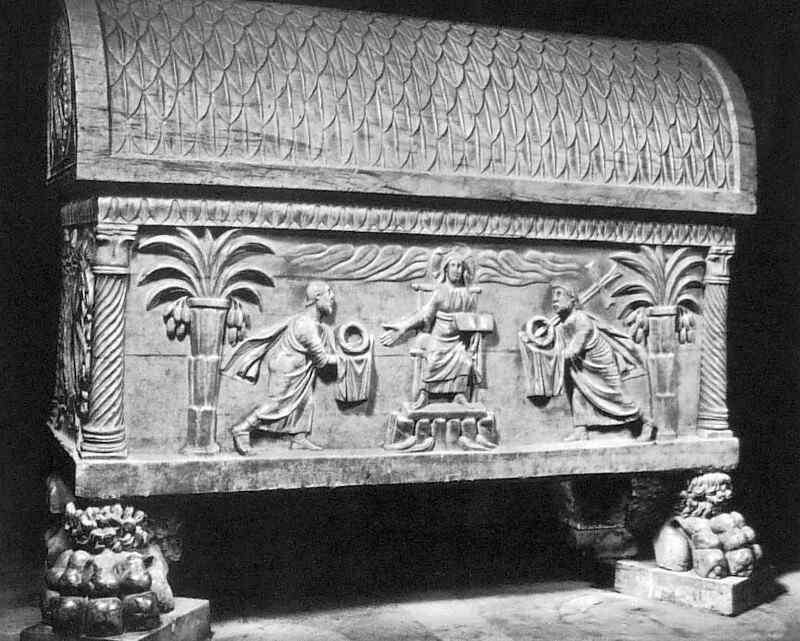 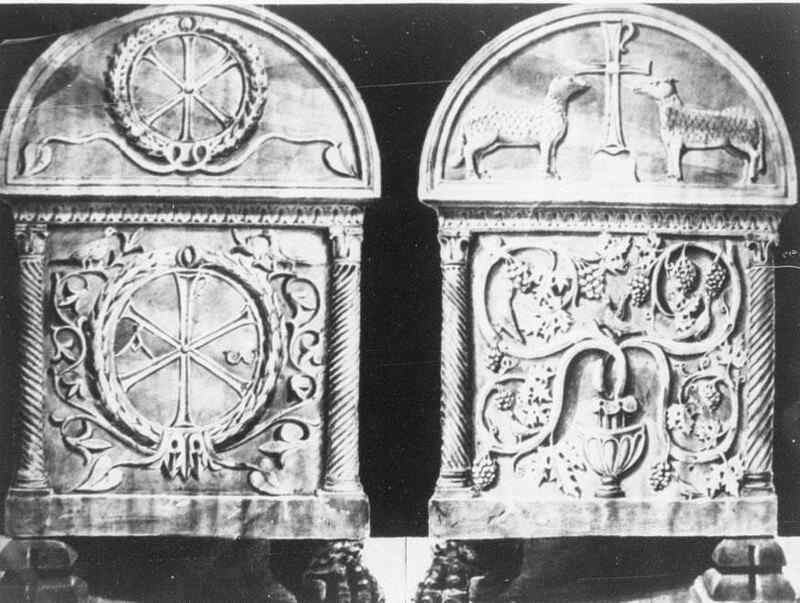 The central figure: the Christ. Notice how the two other figures are produced, and behind them the plant motifs on both sides. Do you remember the very first lecture which I held here in Dornach, in which I tried to show the motifs of the acanthus leaf, how it didn't grow as a copy of nature but came out of geometric form, out of an understanding of guidelines and only later, as I showed, did it adapt itself to the naturalistic acanthus leaf? So we see, like here (667) lines and line ratios build a kind of central theme ... and how to some extent the pictorial, which Hellenism brought to its highest expression, now recedes and becomes threaded into the compositional. We can say we have vertical lines, then two opposing angular lines and a centre. When we draw these lines we start to consider spatial relationships:  Let us then add two plant motifs and two figures—ostensibly filled with reverence—rushing towards the centre  We see that it is possible to say that the symbolic image becomes connected with something which can only be suggested as naturalistic because naturalism itself is idealistic: the human figure or even the organic being and the symbol are interwoven and become hardly distinguishable from one another. We shall see that quite other, quite different motifs will come to meet us in other sarcophagi as for example with the following one. 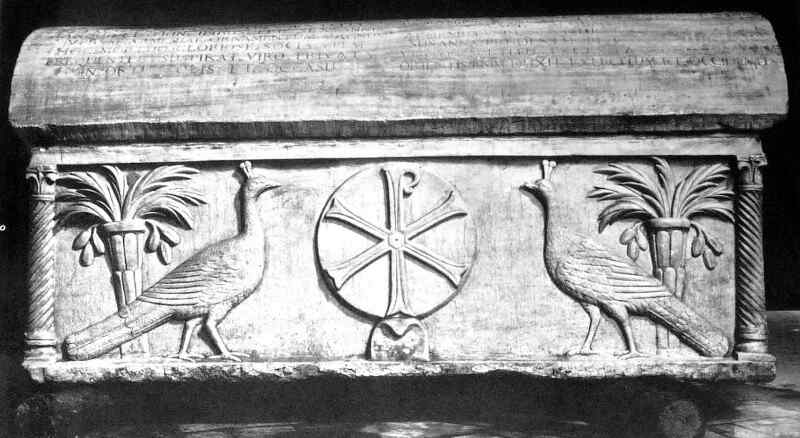 Here we have something quite different. Here we have admittedly also plant motifs; you have the same lines—now not with human beings—but filled in with animals. You have the central motif but this motif itself is symbolic; this motif is a sign, a monogram of Christ, Chi (X) and Rho (P); therefore, Christ construed as the Wheel of Life in the centre. Considered spatially this composition is the same as the one before. Instead of the central Christ figure we have the Christ monogram in the centre; instead of the two figures approaching in reverence, we have animals; and on the sides, plant motifs. Yet, in a remarkable way, we see the image formed here as more complete. The basis of such a monogram representation is always linked to an ancient view but in today's opinion may appear somewhat bizarre, yet that is the basis of it. You must clearly understand that people had some knowledge, even before atavistic Gnostic wisdom—which only really withered in the 18th Century, some even as late as the 19th century. When you take this presentation (666) then you will easily find yourself entering into the artwork despite the naturalistic drawing: the stone as such—physical; the plant motifs left and right—etheric; the animal motif - astral; and the monogram of Christ in the centre—the indwelling of Christ in the “I”. When we gaze as such signs, at the imagery, the naturalistic images shown in such signs, we see an interplay coming out of the 3rd into the 4th post-Atlantean epochs. What were the most profound characteristics of the 3rd post-Atlantean epoch? There where it really acted out of its own impulses, this 3rd post-Atlantean epoch mainly strived to find the sign, the actual symbol which works magic. Understand this well: the sign which works magic. The symbolism was there and gave birth to script. Remember how within the Egyptian culture the priest was handed the letters through the god Hermes himself, the revealed words were received from above. These sign were revealed from the supersensible by the sensible. The signs were to reappear as something in the sense world which had come out of the super-sensible as a Christ impulse because the Christ impulse had to speak not merely of outer manifestations but the Christ figure had to represent the embodied Apollo. The Christ impulse had to present the Christ in such a way that it could be said: “In the beginning was the Word” which means that the sign originated in the heights of heaven, and has come down, “and the Word became flesh”. Thus we need to bring together what lived in the signs as impulses in the 3rd post-Atlantic times with the Christ impulse living in the 4th post-Atlantic time. In Egypt during a relatively earlier time signs could be transformed into script; we see also in northern countries signs in the runes are charged with their own magic, and the rune priests who threw the runes tried to read them, tried to recognise what revelations the runes revealed from spiritual heights. Thus we see the influence of the runes in the 3rd post-Atlantean time, runes which can be found way back in all the centuries before Christendom. This propagated and streamed together with the naturalistic, Hellenic presentation, then already presented out of nature by spiritually beautiful people. Both streams merge. This we can see in the motif (666) as coming together. This is most important here: the grasping of one over the other, the flowing together of the 3rd and 4th post-Atlantean epochs. Look at the next motif, the “Presentation of the Offerings of the Kings”: 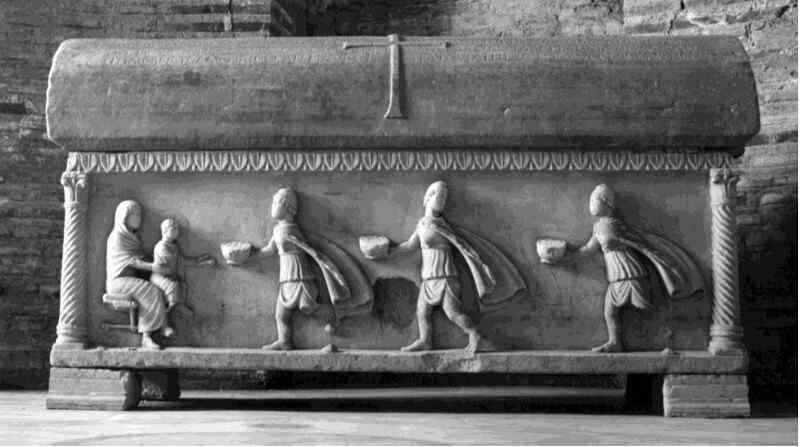 ... we see how the expression of the linear lives beside the naturalistic reality. Let us look at the next sarcophagus motif: 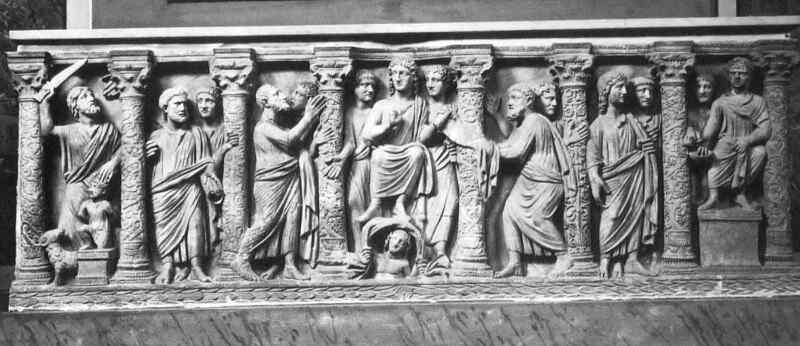 Once again we have something else, despite the succession of the figures which mainly present a biblical scene, although we have the figures simply in a row we see how an attempt was made in the movement of the linear quality of the figures, how the spatial aspect is expressed. So this again is done in the other way (like 664). The following motif is from the sarcophagus of the grave of Galla Placidia: 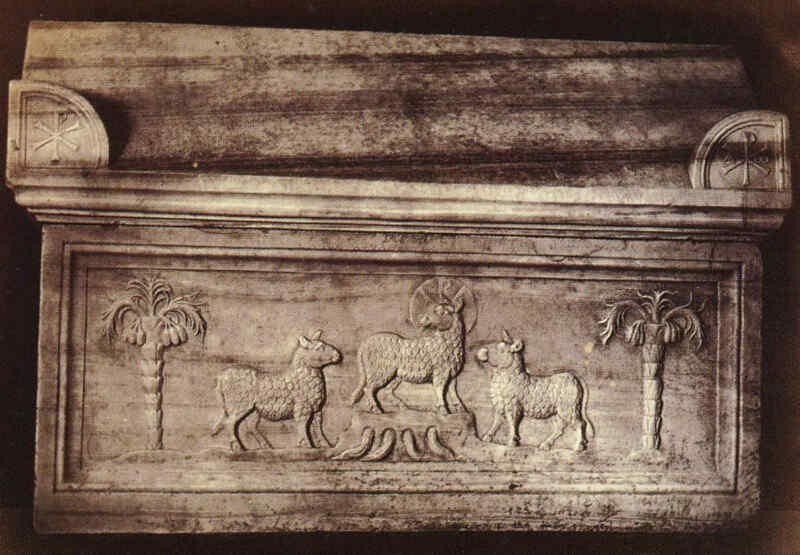 Here the spatial aspect is expressed to a strong degree yet we only see the same thing we've often encountered before (664, 666), the secret of multiples of five you see expressed here, in the centre is the Lamb this time—one could say the Lamb is supported by others—and once again the plants close off the periphery. In the most diverse ways the spatial artistic element of the 3rd Post-Atlantean time will support Christianity, and again penetrate it, as a support for Christianity. All that comes as sarcophagus art. I ask you to really hold on to the idea that the basis of these signs was allowed to flow into Christianity, secretively: you have the pentagonal, you have the triangle in the centre, again a sign; besides this you have the line as I explored earlier. Why did Christianity allow these signs to flow into it? Because they saw magic within the signs, magical effects which did not only happen in the naturalistic area where it became blurred, but worked through the supersensible; within the signs a supersensible expression came about. The next motif: 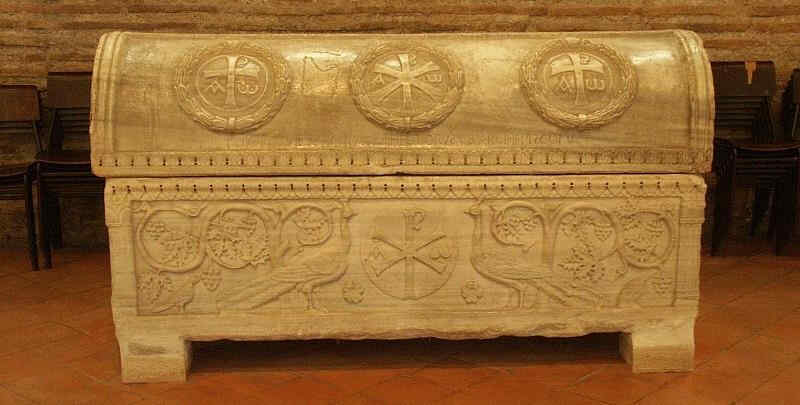  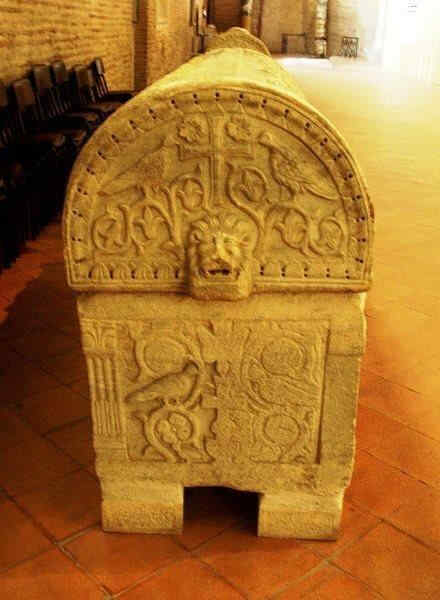 Here we see the signs again mixed in a particular way with the naturalistic elements: the monogram of Christ in the centre and the two animal figures which you have seen already, on both sides. However, the plant motifs are designed in multiples. Above you can see the sign applied. Here you have signs and naturalistic depictions intermingled, the signs as magic, the signs which originate from the same world if they are depicted meaningfully, which the dead enter at the portal of death. One felt something like this: out of the world into which the dead enter at the portal of death these signs come, they are transformed into script. The naturalistic element however exists there where humanity lives between birth and death. The next motif is the Miracle of the multiplication of Bread:  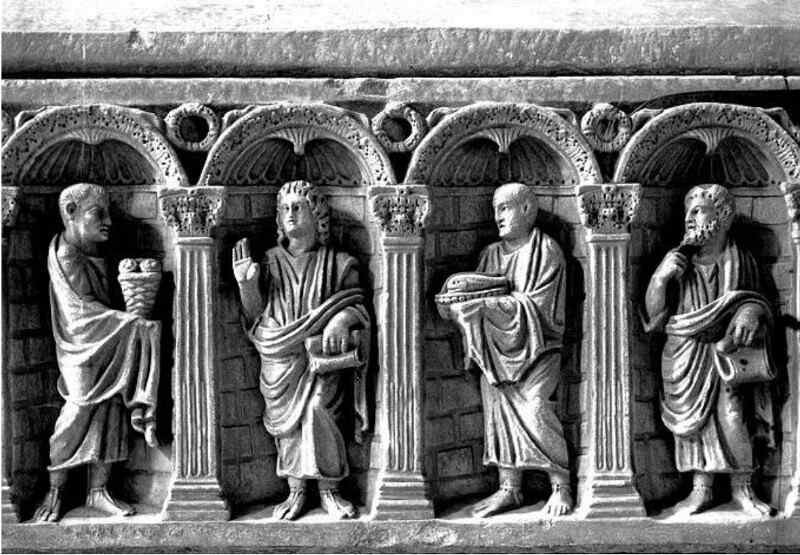 Here in contrast is another way (663, 338) where the mere architectural has inserted the signs. The following is not a sarcophagus motif but is an ivory carving. 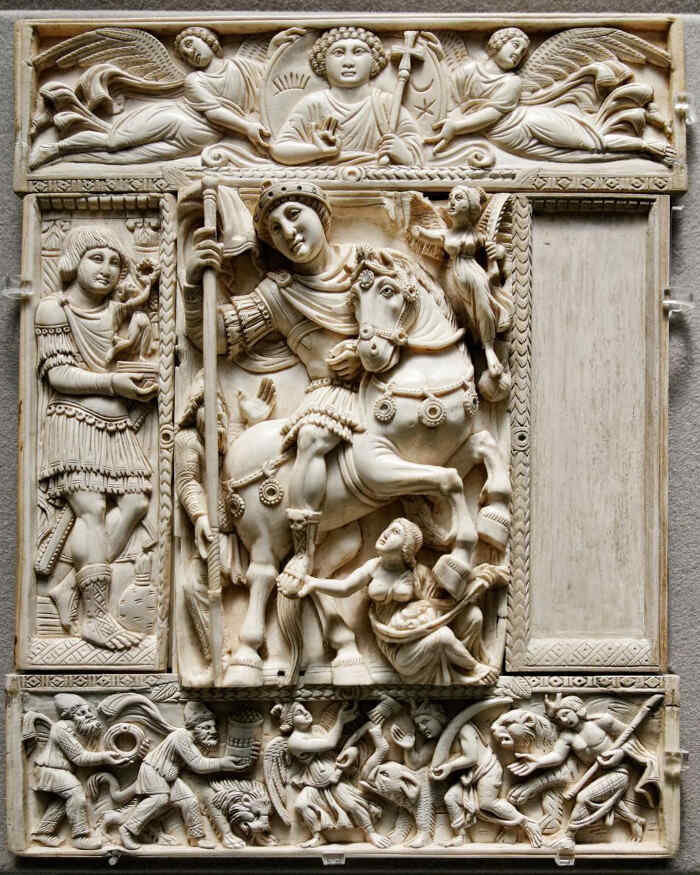 With this I want to make a definite point regarding the way the material was worked in the same way it had remained in the art of the 4th post-Atlantean epoch. The manner in which it was created out of the ivory as relief art during the first Christian centuries was a capability of the 4th post-Atlantean time when naturalism was expressed artistically. The following motif is likewise an ivory carving: 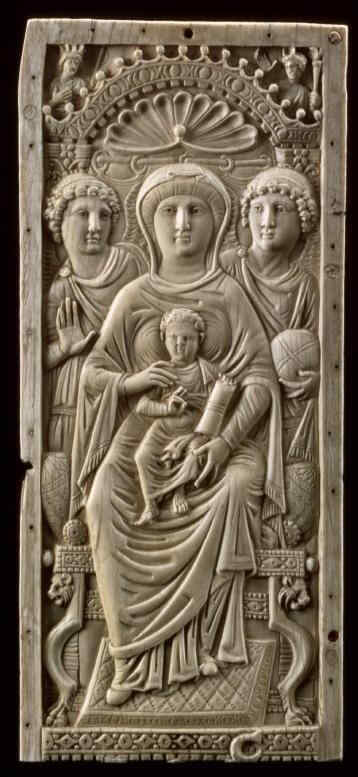 Here you already see likewise more signs complimenting the lines as well as the figures and images being applied to the imagery, you can clearly see how it is possible to fill to a certain extent the area into which the figures are threaded, pulled in, how they can be expanded as geometrical figures. These are, one could say, the backbones which Christianity has brought in the form of the symbolic art of the 3rd post-Atlantean epoch and which we see appearing everywhere. I have another example out of the Dome in Ravenna:  ... in which I can show how completely the motifs are converted by the application of the signs. On the left at the top we have the Christ monogram, below left and right we again have geometrical and figurative motifs, above in a similar fashion the Christ monogram, a simple motif, symmetrical left and right. We can, if we get a bit of help from our imagination, see how a real evolution has taken place from the first to the second motif. Just imagine in the top left under the curvature, the Chi (X) and the Rho (P), the Christ monogram simplified, think of the Chi crossbars simplified and then you arrive at the central motif, top right, as the monogram forming the cross. Imagine the growing together of the monogram at the top left, with the wreath, a mere plant motive of creeper with leaves, and you will come to the animal motif on the left and right. Simultaneously you could imagine the top right motif in a simplified and more elevated configuration as the evolution of the left motif. In the same way the right sided monogram can be a forerunner of the left. Just imagine for a moment the left palm of the monogram configured in these entanglements around the monogram, consider how the left motif is similarly growing here as is apparent in our (Goetheanum) Building, where column motifs develop out of one another; consider the simplified geometric forms more organically depicted, then you have the right side motif as it develops from the left one. When one goes back into the mysteries of the 3rd post-Atlantean epoch, you find spread all over Europe, from the north and even into America—because there has always been a connection between Scandinavia and America which was only lost for a short while, a few centuries before America was discovered by Spain, much earlier one always sailed from Scandinavia to America; they lost their connection for a short while and it was only re-established after Columbus rediscovered it—one finds, spread out over southern Europe, over North Africa, over familiar regions of Asia, the front area of Asia in particular in the 3rd post-Atlantean epoch of the Mysteries, afterwards some latecomers—one finds the real mystery centres of earlier, of the third post-Atlantean epoch. Here magic and signs were spoken about in particular. What Egyptian mythology related in regard to the priesthood of Hermes are the outer exoteric echoes of the esoteric elements in the Mysteries regarding the magic of signs, which was learnt in northern lands as the magic of the runes. This was the magic which came, on the one side, from a spiritual side, from magic which was used to try and form signs which came forth purely out of the spiritual realm and to some extent permeate this realm of signs by human will in order to create particular signs into which the forces of the supernatural would be poured. This was not the only place where magic was searched for. It is very significant that magic was looked for on the other side, one could say, in the supernatural. Isn't it true that the naturalistic as well as art was simultaneously spiritual for the Greeks? In supernatural signs magic was searched for which merely lay within the signs themselves. However, magic was also sought in sub-nature. Besides the mysteries which speaks about the runes and signs in olden times, there were other mysteries which spoke about other riddles regarding sub-nature. This sub-nature one discovers in quite particular products when one looks for them mainly under the surface of the earth. If one goes above then one meets the gods in the heights who give sense to the signs, where the supersensible works as magic, then it is possible to grasp it in the sensual sense and unite it artistically. If one goes however into sub-nature, into the inner earth, one finds a kind of magic held there. Among the manifold magical things, one sought in particular for the identification of two riddles. If we today express the knowledge of these two riddles, we could say that in the secret mysteries the riddle of gold was well kept, as it is sought in the veins of the earth, and also the riddle of gemstones. This sounds extraordinary but it really correlates historic fact. The magic of the signs was particularly connected to the church. In the 3rd post-Atlantean time they sought to incorporate magic into the signs. The magic of gold—where in particular it is formed as it appears in nature—and then the magic of gemstones which bring light into what had been dark, where light is held in something material, material which was held in darkness—this didn't enter into the priesthood but gave itself into the profaneness of humankind who stood outside the church. So it happened that out of certain impulses which were very, very old—when liberated town culture established itself in art which I have just recently explained, as everywhere the liberated town teachings developed, that these liberated town developments came to the surface -the joy of gemstones, the joy of gold, the delight in gold processing and the delight in precious stone application came through as waves in the spiritual life. Just as the church wanted to bring signs out of the heights of heaven so from the depths of the earth came the secret of gold and the secret of the gemstones as part of the liberated town culture. Not just by coincidence, but through deep historic necessity the art of the goldsmith developed and I would like to say, only as an annexure to the goldsmith art, other metal art grew out of the desires of town culture, by applying gemstones, because gold and gemstones contained magic, a magic from below in nature that should be loosened and spread before the senses. Still today an echo of this urban working with gold and gemstones can be seen in art, as founded by the Bishop Bernward of Hildesheim. In Hildesheim, situated in the midst of northern Europe's centre one sees many such works of art—otherwise also available but particularly concentrated there—where gemstones are incorporated into the most delicate artistic metallic works of art. Bernward of Hildesheim    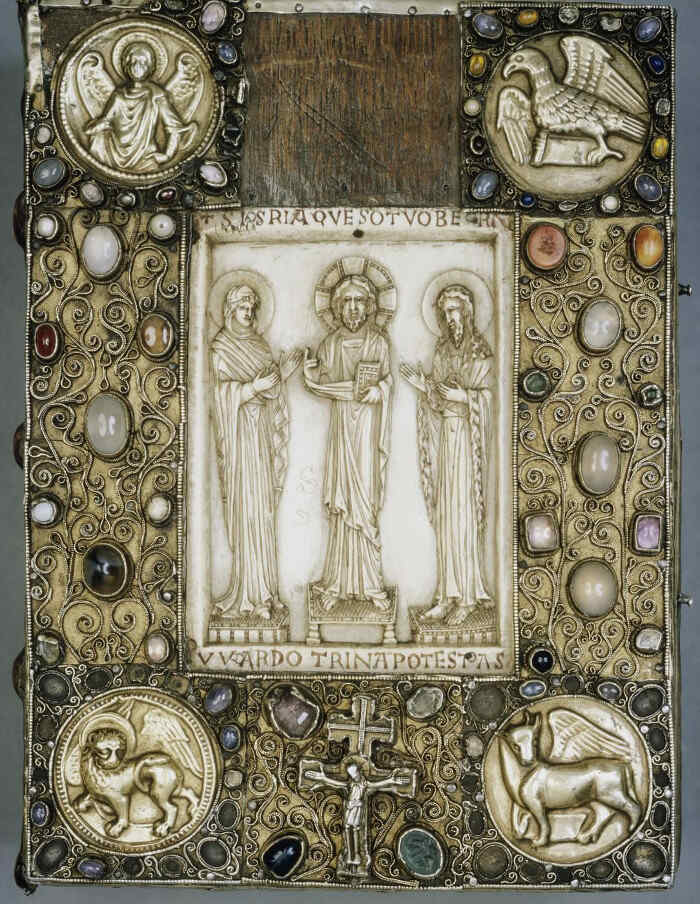 In Hildesheim it comes across to one as phenomenally important in its ancient form. It spread out, and actually this which I have pointed out as appearing and blossoming particularly because Central European impulses are also found in Italian cities. Basically the art of the goldsmith in Florence and what was designed by later goldsmiths to become the great art in the arena of sculptural relief and sculpture as such, dates back to this same origin. These things are interlinked in the most manifold ways. Now consider the following. I had said that in the 9th Century when the church of Rome and the papacy had a different understanding than later, of what actually had to happen in the western world, from a certain viewpoint I represented this, how from the 9th Century onward forces in Rome, which one could say rose from below and became valid, how these laws from Rome became systemized just like laws originating from the spiritual world should have been included. On the one side Rome can seem thus: from the South rose the magic and sign world which came from above but with a focus towards the North where liberated town culture was being developed, focussing towards the North where joy grew in the secret of gold, in the secret of gemstones. However, this northern influence had already produced something out of its old mysteries, which necessarily had connections through the mysteries to, on the one side, the mystery of gemstones—this we can leave out of the game today—and on the other side, connections to the mystery of gold. Christianity didn't simply develop out of a single impulse and impulses also worked against Christianity. Just as it was opposed in the South by the magic of signs, so in the North it was opposed by the world of Central European legends and out of the North incorporated by the great gold mystery, as illustrated. With the gold mystery the figure of Siegfried is connected, who looted gold and perished through the tragedy of gold. Everything which is connected to the Siegfried figure is related to the mystery of gold. The theme that gold and its magic only belong to the supersensible world is like a red thread throughout the Nibelungenlied, gold is not to be dedicated to the sense world. If one considers it in this way, then your mind understands the deepest mystery of gold. What did Siegfried's friend tell him? What does the Nibelungenlied say? What is its great teaching? Offer the gold to the dead! Leave it to the supersensible realm; in the sensible world it makes mischief. That was the teaching which propagated through Christianity in the northern countries. This is what was understood in Rome during the great synthesis taking place between Roman elements of the 9th Century in the northern European areas when within art it united with what rose from the one side out of signs and on the other side from symbols added into the gold and gemstone work. How beautiful this confluence of symbol-rich art and gold-gemstone art is during the 8, 9, 10, 11, 12th centuries. Everywhere we see this ancient Christian art of symbols. By connecting other impulses, we see the incorporation of the symbols into the working of the gold and gems. This was now systematically sought in Rome, but was also prepared for in Europe. As a result in the early days we see, rising from the south, the Christian traditions in a form that even in a non-pictorial, purely by word-of-mouth form, the symbols moved and worked. The heathens coming from the North were heralds of everything worldly, embellished, and ornamental, linking the magic of the symbols to the sub-nature. By associating the cross of the South with the gold and gems of the North which originated in the heathen mysteries, just like the symbol of the cross itself out of the mysteries is applied to the Mystery of Golgotha, so we see three impulses combining: the naturalistic depiction of spiritualised nature taking the Greek power of form from the 4th post-Atlantean epoch, and the other two impulses: the symbol of the magic in signs, and the magic of sub-nature, of gold and gems. Yes, to find the preparation of ancient times in the historic development of becoming, the further back we need to go. Our time is already in the epoch in which, I might say, everything battles with the human being, in order for him to learn and not remain sleepy by gazing into the present, but that lively impulses of evolution are really grasped, otherwise he might nevermore be forced to see how chaotic the present has become. Today I have the opportunity, but in the near future this opportunity might not be so, to show you how, by the art influenced by the South being brought towards the North, that a particularly strong motif is expressed by the merging of the animalistic and human. In earlier time this started to appear and later became seen as the interworking of darkness and light. Out of the figurative dark animalistic realm the bright human form rises in the relationship of the dragon with Michael, and so on, also seen in other compilations of the animal and human. This becomes the light-dark artistic expression later. All these things are interconnected. Much, very much has to be spoken about if one wants to show the artistic expression of this interworking between the olden and newer times, this penetration of the naturalistic heathen impulses with the Christian impulses, which however, to be valid, has to renew the old magical motifs, now to have this magic in the old heathen sense undressed and lifted up into the real spiritual world. This was known particularly in the 9, 10, 11, 12, 13th centuries. It was then known that the ancient heathen elements had become obsolete, but lots remained behind—yet these elements had become old—and that the young Christianity of that time had to work into this, was known. This we meet in literature, in art, in the creation of legends, everywhere. I have already often pointed this out, how present time humanity has become completely lost to the idea of spirituality working in outer reality. In the 5th post-Atlantean time when materialism is written on people's banners, this idea has nearly become lost completely. People are unable to imagine the streaming in of the spiritual, of the meaningful elements in pure naturalism, in pure matter. As a result, the gradual dying of the heathen and the gradual becoming of the Christ impulse in European culture is considered, at best, in abstract terms. In the 9, 10, 11, 12, and 13th centuries this was not the case. Then one presented it, if a representation was wanted at all, in such a way that the soul and outer corporeality were considered simultaneously as outside of the human being in history and in natural events. Everywhere one looks at the physical geographical surroundings something spiritual is simultaneously expressed. Hence much in the prophetic line came to be seen in these ideas. People at present, if they do not only want to have superficial feelings but have a heart for the monstrous events taking place in our time, cannot today think of the Nibelungen legend without seeing prophetic depths within it. Whoever understands the Nibelungen legend in its depths, feel prepared for all the terrible events which flash through the present. By thinking in the same way in which thoughts are shaped in the Nibelungenlied, one thinks in a prophetic manner because then thoughts are formed through the mystery of gold. Hagan allowing the Nibelungen treasure, the gold treasure, to sink into the Rhine, was a prophetic idea at the time the Nibelungen saga was created and is experienced as deeply tragic in view of the future, on all that the Rhine will become as a cause for antagonistic impulses against the future. At that time the outer geographic natural world was not regarded as soulless, but was seen in connection with the soul, in every breath of wind was a soul quality, in every flowing stream something of a soul. At that time, it was also really known in what sense the purely materialistic reference meant regarding “the old Rhine River”. What is the Rhine actually in a materialistic sense? It is the water of the Rhine. What flows in it these days will in future be somewhere else. The water of the Rhine is actually not really something one can call the old Rhine, and one does not usually think of the mere coincidence of the earth. All that is matter flows on, it doesn't remain. In olden times external matter was given no thought, other than everything being an illusion; it was not believed that external events were merely embedded in the flow of what was described as naturalistic. Whatever was external was simultaneously a soul expression permeating physical existence. For this reason and particularly during this time it was a necessity to allow the old heathendom to dissolve and allow the new introduction of the Christian impulse—that was necessary in Europe in the later centuries—there people tried to think soulfully about geography, making geography plausible to the soul, the heart, to the mind. Let us look at the example of the Odilienberg there in the Vosges and see the Christian monastery of Odile, to whose father, the pagan Duke, she was born blind; we see on this site the pagan walls of the Christian monastery. These pagan walls are nothing other than the remainders of old pagan mysteries. We see a merging of dying paganism and the rise of the Christ impulse at this geographic location. We see this expressed in the myth with remnants of the own pagan ancestry imposed by Odile being blind but who becomes inwardly, spiritually seeing through the Priest of Regensburg, through a Christ impulse. We see a working together in Regensburg a blossoming later as in the great fruitfulness of Albertus Magnus, we see it blooming, we see it instilling the Christ impulse in the eyes of Odile whose pagan ancestors had blinded her. We see geographically at this place the telescoping of the Christian light into the old pagan darkness. We see this as the basis imposed by Rome: take up the gold, but bring the gold as offering from the realms of the supersensible. Let the gold enter into that, of which the Cross is a sign! In our time we see by contrast, the flood of gold taken up by the senses as it was brought into expression in the old heathen legends. We see how time takes a stand of opposition to the supersensible light contrasted by the gold. Siegfried was drawn to Isenland to fetch the Nibelungen gold. The Nibelungen gold he brought was offered to the Christ impulse. This Christ impulse dared not turn pagan again! Oh, one could use many, many fiery words, as human words are, to really depict the terrible sense of this time. This time is filled with signs. During this time human ears unfortunately wanted to hear very little. The first year of chaos arrived - and it was believed that it would soon be the past. They didn't want to listen to the deep powers moving within this chaos - also into the second, the third year—and also now. Firstly, when this adored gold can be eroded, will people have ears to hear that no ordinary tools can be found which are so needed during this time, tools brought over from the past, but that it is only possible with the forces of renewal brought about from within the flowing Christ impulse, which in many cases had already been forgotten as Christ impulses. In no other way could these things improve than if as many people as possible decided to learn from the spirit. Let us look for once at the manner in which earlier humanity comprehended things, even thinking of the direction of the wind not in a materialistic sense but that the windsock was inspired, ensouled by the region with, on the one side, the Odilienberg and on the other side, Regensburg. It was the same with other places. Learn once again how humanity experienced not mere air moving over the earth but that there is spirit above the earth, spirit which must be searched for; that beneath the earth there is not only stuff which they could take out with the aid of material tools, but that which was to be unearthed from the sub nature had to be offered up to the super-sensory. To understand mankind again, that is the mystery of gold! Not only spiritual science teaches this but this can also be learnt through the real understanding of the history of art in a spiritual sense. Oh, how terrible it is to see how the present day humanity wait day after day and do not want to understand the necessity to grasp the new; that they make no progress through old, worn-out imaginations. More about this again at another time. |
| 292. The History of Art II: The Changes in the Conception of Christ During a Certain Period of Time
29 Oct 1917, Dornach Translator Unknown Rudolf Steiner |
|---|
| I say: the abstracted cosmic element transported over to the West! If you want to understand that then you must above all completely enter into the art of being, into a soul nature which was found in Romanism. |
| World domination was actually the Roman Empire's ideal. To bring the then total cultural world under Roman rule was the Roman Kaiser's ideal. The content from Hellenism to Romanism was prescribed by the desire to represent the individual. |
| The Greek influence actually existed in art with little influence from central Europe. Understand, this had to be so, from the second half of the 9th century it went well in Rome. Everyone knew, as I expressed it once, this `Eastern Being' had to be kept back. |
| 292. The History of Art II: The Changes in the Conception of Christ During a Certain Period of Time
29 Oct 1917, Dornach Translator Unknown Rudolf Steiner |
|---|
Today I want to bring you something about the transformations around the concept of the Christ from various viewpoints but set in a specific period of time. In a certain sense one can speak about the influence of the Mystery of Golgotha in every cultural sphere and in order to elucidate the correct idea of its influence on the earth's evolution it is necessary, where possible, to examine this impact independently from each cultural area. Within the evolution of art, it is possible to speak about the important changes brought about as a result of the impact of the Mystery of Golgotha in the general progress of humanity. However, these thoughts will not suffice without the awareness which link to, I might call it, intimate artistic changes in the evolution of individual arts. When we start looking for the starting point of when people in Europe depicted the Christ figure, it is repeatedly shown that the attempt to depict the Christ figure artistically actually only started from the moment when, within historical development, the concept of the Gospels as a literal perception of Christianity experienced a conclusion to a certain extent, a view of the Mass and Gospel traditions through participation in the church thus rejecting some declarations considered questionable at the time. When the foundation of Gospel literature was completed and also the transition was made to a certain degree in the minds of those looking at the content of the Gospels, a desire started in the West to artistically depict scenes and figures found in the Gospels. This should not be lost sight of. Before the Gospels were concluded and rounded off in the minds of those calling themselves Christians, they limited their imagination to a depiction as a signature which you can see in this slide of the monogram of Christ: 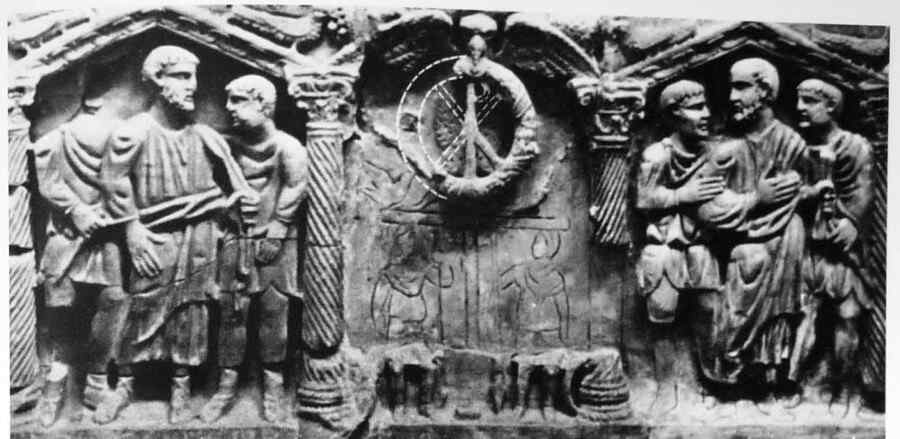 710 Christ monogram See in the centre the Χ and the Ρ, ie. Chi and Rho, which is simultaneously the angled Cross with the Rho. Or you see it in a similar form, as you see here:  712 Christ monogram ... or combined with animal figures: 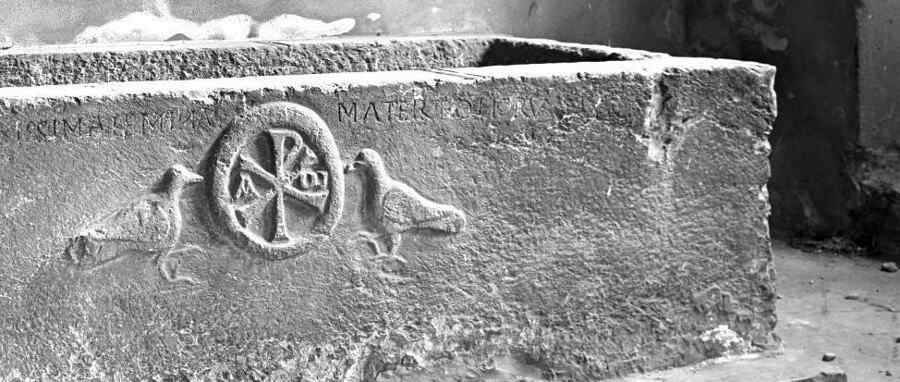 713 Christ monogram with two doves. ... or the changed form, as we have here: 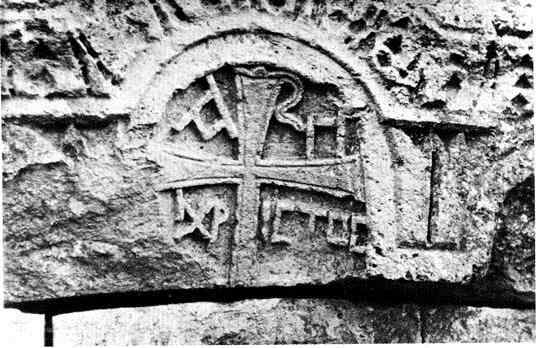 711 Christ monogram: This is what people limited themselves to during that time, during which the mass of the Gospels became unified and gradually penetrated people's minds. This is the reason why actual pictorial representation of the holy history can only be spoken of as originating from the 2nd or 3rd centuries onwards. In the course of our local art observations which I have emphasized I want to point out another relationship today by referring to what I've highlighted before. I have stressed that the first representations which were created still obeyed the forms of the old, ancient pagan artistic development. People simply transposed the pagan artistic expression on to the content of the Christian development. This is very important. One can say that before and up to the 3rd Century nothing had been done in the western cultural development to depict images of the Gospel scenes as such, which had not come as a transfer from pagan art. Here we find figures which we connect to Christian representation as similarly depicted to what we usually see in pagan myths. Today we want to limit our observations to the Christ figure Himself. In this regard we find at the start of the first times the Christ is represented, most frequently of all, the image of the Good Shepherd, in the most varied forms in antiquity, presented in the pre-Christian times. This image—chosen from one out of many representations of “The Good Shepherd”: 714 Mosaic of the Good Shepherd, Mausoleum of Galla Placidia, Ravenna ... 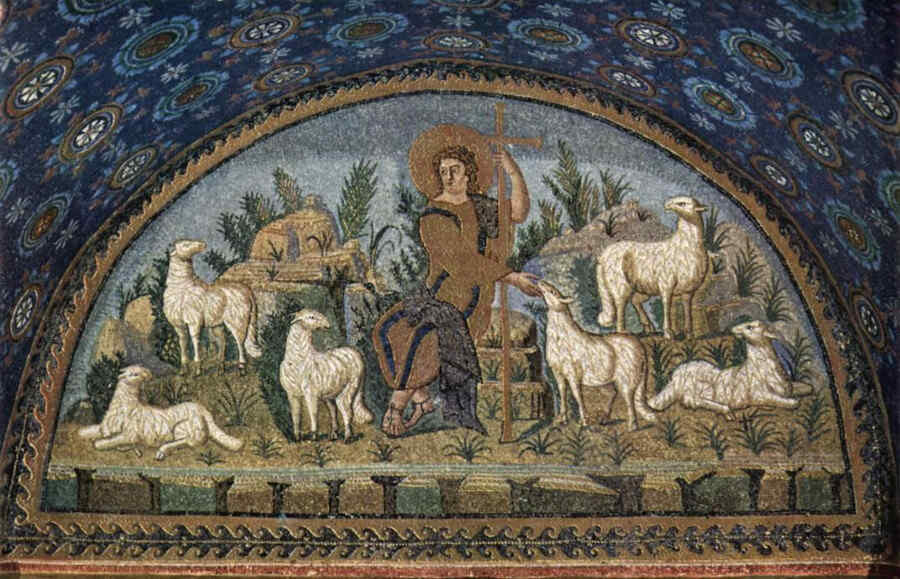 ... reminds us of the depiction of David amongst the animals. It reminds us of other Greek images. If we limit ourselves in particular to the Christ figure in this image, as it still stands, you see an absolutely antique expression. We notice the endeavour in this pictorial representation towards the expression of a mild, noble face, generally found in these olden times, beardless, still with tousled hair, youthful, gracious. These were the endeavours which live in all these images. We already see in this representation of the Christ imagery the pagan imagery imposed on it as the basis because in such images everything is still pagan. Now a question about such a statement is created: what precisely characterizes the paganism in this imagery—I'm speaking from an artistic point of view. So much has been written and spoken about art but the essential vigour, if I may call it that, of the pagan artistic expression has not been stressed. When you—as much as it is possible from what is still available—study Greek imagery you will very gradually find the fact that this Greek imagery, studied realistically in the sense we speak of realism today, did not exist. The forms of the human body were not presented by the Greeks as a direct likeness of a portrait of some model, corresponding in any way at all as a mere copy of the human body as it walks the earth because the Greek simply had an ideal body in mind. This ideal body they had in mind, actually incorporated something quite different from what human eyes could actually see in a model. In order to really understand the most important Greek bodily depictions, the artistic physical forms, one has to refrain from considering what the eyes see in the model and its form; one should remember what I already mentioned in previous years: the Greek depiction is according to the inner feelings experienced within the body. A muscle wasn't merely a direct rendering according to what the eye saw but how it was being experienced, how with inner feeling it cooperated with movement, streamlined with muscle contraction. The rendering in artistic matter carried a feeling which was being experienced within the physical itself. What single factor made this possible? Indeed, it was only possible as a result of the Greek artist, when connecting his thoughts to the physical nature of a person in the majority of his creative images, he relinquished the individual nature of the person. He refrained from including it. When he looked, he saw only the physical expressed in the human form. Pay attention—he looked at the physical nature of mankind as if it represented the outcome of the entire cosmos, as a total spiritual depiction of the cosmos. When you look at a Zeus figure, at a Pallas Athena figure, an Apollo, an Aphrodite figure, you find the soul within it. However, these souls which are within these physical forms are not individual human souls but they are souls that live as results of the entire cosmos: world souls in a human physical form. One could say that what the Greeks searched for as souls in this realm they saw as absolutely beyond the idea that the human is a result of the universe, but that through their thinking they considered the forces cooperating in the universe as striving to produce the crowning glory of its creative forces, the crown of its creative power as a product resulting in the human organism. How focussed and concentrated the creative cosmic forces were, to bring the human form into existence! In such Greek human organisms are the forms I have been telling you about, and here we also find the concentrated expression as seen in laws creating the entire culture, and also through which the entire Spiritual All rules: the creativity of the cosmos condensed in the human being. One could say the Greeks configured the body in this way. Indeed it seems extraordinary but much more correct if one thinks of what I want to say now. One imagines that when people are asleep, the soul, therefore the `I' and the astral body are outside the physical body and that the sleeping body is ensouled by universal spirituality, absorbed by this spirituality which belongs to the cosmos and through the spiritual aspect being driven out of the human body it has the result of enabling the individual spirituality during earth evolution to enter into humanity and thus one acquires the Greek inspired shaping of human form in such figures, as I have indicated to you. Not that the Greek had no understanding of individual spirituality but he saw the individual soul qualities as not yet penetrating the human form; the human form was for him still something universal. So it happens, which is extraordinary enough, that the individual soul aspect, the specific human soul aspect in Greek art only appears when the Greek does not represent forms which in Greek art, in their higher development, are regarded as typical. When the Greek presents an Apollo or a Zeus, Pallas Athena or Hera or Aphrodite then something typical is presented; when these are not presented, when Satyr or Faun is depicted, then what is presented is pertaining to the individual human aspect, applicable to every soul which is present when it is awake and which leaves the body when it is asleep. You see this is the curious thing in pagan art development in its highest configuration in Greece. Specific human soul qualities had not penetrated the art forms when the ideal-type aspects were adopted. By contrast all that was working in the soul, the emotions and impulses permeating the soul with the preference of the Satyr and Faun figures, one could say these reminded one of animals. When the Greek presented the god Apoll, then in the god Apoll lived a super human, a super individual soul as an artistic figure of Apollo. Swinging over to the humanistic we first find, in the Greek depiction of a Mercury-type, the Hermes-type. We can find many—you can study the Hermes-type - inspired by the Faun- and Satyr-type. One could say it was the conviction of Greek art that the human soul had not come sufficiently far in its development that it had its own powers to express itself in the human form, when this human form wanted to come out in its full glory. If we now go even further back in Greek art history we encounter the oriental art form, to discover the total universal cosmic coming into expression. Thus Greek art was the final flowering of universal cosmic expression, the representation having been attempted in the physical human form. It is extremely important that this is looked at. One can now say that as the Christ became the redeemer in relation to the rest of the powers of evolution in humanity, so He also became the redeemer in relation to this view of art. Imagine an elevated mind posing a question such as this: how can one idealize a representation in order to reach an expression in contemporary art, an expression of something spiritual, something human, how can one idealize something which earlier was merely represented by using the mentioned deviation of an ideal type, namely a Faun-type, a Satyr-type and so on? How can the problem be solved in connection with the specific human form, how can something be idealised which in ancient times did not want to be idealised but that the divine humanistic be kept in contrast to the all-too-human aspect? This question was never stated on the physical plane yet it is answered in the further development of art. It is basically also being answered in the history of humanity. It will always be part of extraordinary interesting facts that one man in Greece, who so deeply descended into the Greek life that he through his own destiny, to a certain extent, he prepared the redeemer destiny—Socrates traditionally didn't represent and ideal type of Hellenism but more something of a Satyr or Faun. It is as if world history itself wanted to create the specific human out of the subhuman. 715 Greek sculpture, 4BC, Socrates, scale down copy (London, British Museum) 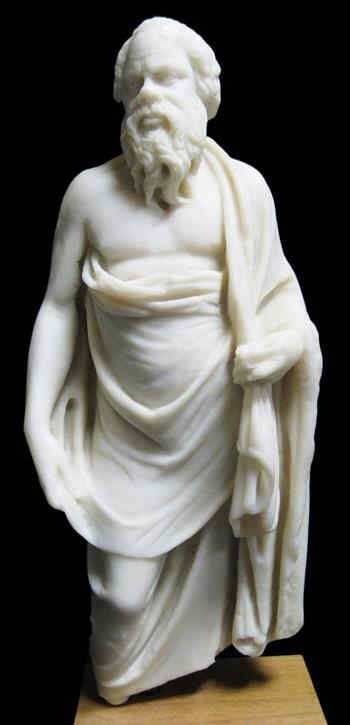 Here we see in the continued progress in the shaping of something which had not been achieved in the ideal humanistic form in Greek counter art, in the Satyr- and Faun art, by wanting to achieve a breakthrough as a human form only originating from the cosmos. The individually human conforms according to spiritual lines and forms obtained only from the cosmos. Oriental forms we must always look for in the cosmic, but western form in the individually human. So we see, the moment humanity wanted to conquer the pagan, just then the Christ-type entered in order to penetrate the specifically human into the commonly typically cosmic element. Just observe how that penetrates the typical ... 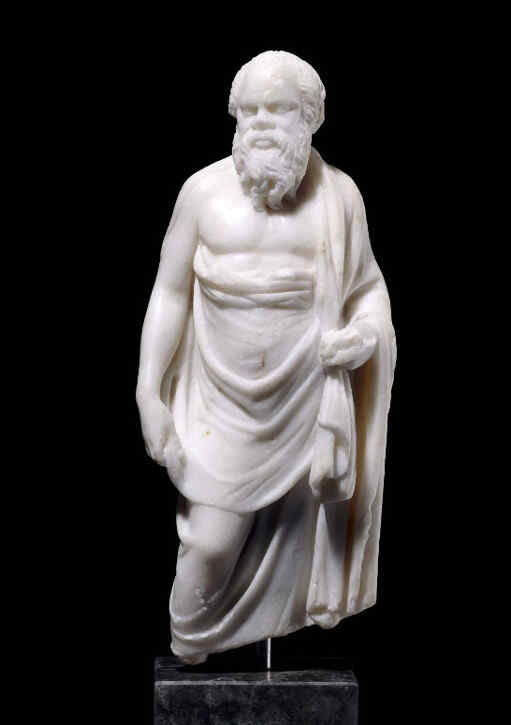 715 Socrates (London, British Museum) Here we have a 716 Catacomb painting of a Christ depiction (Rome, catacomb of Pontianus)  ...out of a somewhat later time of ancient Christian art, complete with an added beard, while many Christ representations in the first centuries were beardless. We see how there is a continual attempt to not only make the cosmic aspect in the figure a reality, but to show how the cosmic element is at war with the individuality, how the one is working against the other. The cosmic element here still carries more weight, but actually it outweighs only as tradition. What had to be overcome in the oriental-Hellenistic still carried the most weight, and would still outweigh it for a long time. Only gradually the penetration of the specific enters as the individually human element into the form. So we see how gradually this happens. I have to show you the next image as a result: 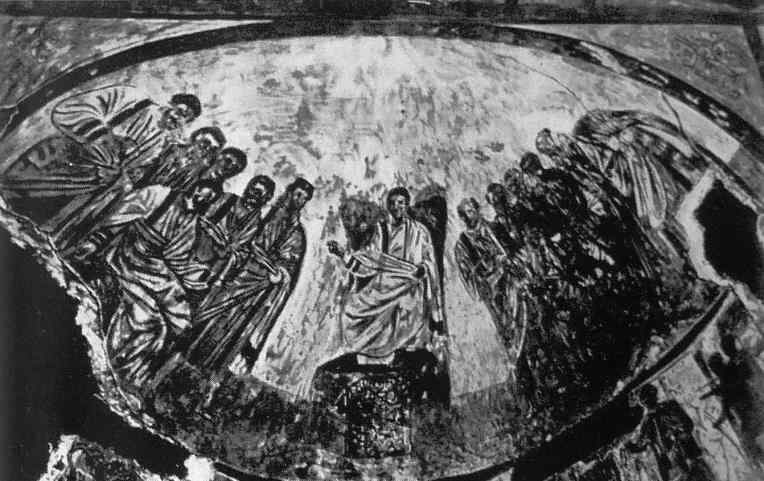 717 Catacomb painting of Christ amidst his apostles. Here you see—it belongs to the first centuries—how the endeavour existed to maintain the whole arrangement of lines originating from the cosmos, and so on, but as something entering which is specifically human. As a result of this the strange battle started which had particular importance during these ancient centuries, the old battle of how Christ had to be represented; should He correspond more to the Apollo beauty or should He be represented as an individual human soul? The endeavour was to represent Him as an individual man with a soul. Now here is actually the peculiar thing, you see. Here one accomplishes one of those reversals, as we have encountered in other areas during the last days: to represent the human individualism, simply by pulling up again what earlier had been frowned upon. This was developing in the highest degree within Greek trends while in the west, in Latin circles, the continuation was being developed of something which once had been quite oriental—to depict a certain cosmic figure. This was in a time when the unfolding of art in the west dwindled and one could not be sure about the correct explanation any more. Thus it happened that the depiction of the Christ-form itself triumphed for the eastern, the oriental and Byzantine type of depiction, while the Christ individuality was not included. However, while artistic evolution was on a downwards path one can say that this type degenerated, He no longer retained the lofty dignity which the East wanted to give Him but He was depicted as becoming, one could say, the downward trend of humanity. He became the kind of representation of humanity's characteristics which enter in a degenerative way. His hair was parted, his beard took on particular forms, his expression became such that people saw: the superhuman-cosmic was now being conquered by the human aspect. However people were not yet in the position to really depict this human element as a kind of ideal-type. We see this exactly when we allow further Christ images to work on us, for example even this very beautiful mosaic in Ravenna:  718 Mosaic: “Christ with Archangels crowning the Holy Vitalis” (San Vitale in Ravenna) in which we find neither great beauty, nor a cosmic-universal image, but in which we can already see that an attempt was being made to bring in the human element. Even more clearly we can be impressed by the expressive images in the mosaic of Palermo—the Monreale Dom, in the apse:  719: Mosaic, 12th Century, Christ, and below Him, Our Lady with the Child. This is an image which evokes the most immensely impressive thoughts through its wonderful craft of mosaic. However, precisely within these images we see the battle of both streams which we have been speaking about. Exactly as a result of this battle, this image is one of the most interesting regarding what we have ahead. All of this belongs to the general course of humanity's evolution. We see how in a loop line the individual jumps over the abstract cosmic aspect coming from the East, and lets it go over to the West. I say: the abstracted cosmic element transported over to the West! If you want to understand that then you must above all completely enter into the art of being, into a soul nature which was found in Romanism. Imagine how this Romanism worked. You must free yourself from everything which educated people are so inoculated with today because Romanism has conquered the schools; our entire education is Roman based. However we must not forget the actual content of Romanism when we look at the first blossoming which drew its content for two centuries from Greece, right up the blossoming of Romanism under the Julian Empire. Roughly 150 to 200 years before the Mystery of Golgotha and somewhat later se see how Greek imagery, how Greek culture was conquered by fantasy-deprived Romanism, how this fantasy-less Romanism took over Greek content. Rome became ever bigger in precisely this peculiar insult of which I have spoken, the transference of abstracted cosmic elements on human affairs. In Rome originated that distinctive talent to launch world domination, the talent for world domination which in ancient times—while the slandering they were initiating had not yet happened, or taken over—the peculiarity was the great oriental empire of the 3rd post-Atlantean cultural epoch—that went over to Romanism. World domination was actually the Roman Empire's ideal. To bring the then total cultural world under Roman rule was the Roman Kaiser's ideal. The content from Hellenism to Romanism was prescribed by the desire to represent the individual. Indeed, one finds in Romanism this Greek yearning to represent individualism, even as ugliness, thus letting Latinism conquer the Greek type. Initially there was resistance to do this because the former desire was for the beautiful type and because of this at first it didn't strike them as beautiful but as ugly. It reminds us of the Latin old Faun- and Satyr-types, which are elevated as the highest human quality. Gradually within the Greek being itself came the cosmic Zeus type, the Apollo, the Pallas Athena, Aphrodite in a state of decadence; out of this came something which had formerly only lived in the area of ugliness and now was being striven for in idolised moral beauty. From the West, in Romanism, quite a different Christ-type was depicted, it was actually depicted as a consequence of the pagan Apollo-type and this is due to the background of Italian humanity in that century and their sculptural inventions because they didn't have an inventiveness of their own, in fact had none at all, because Romanism in essence was without imagination. We can now continue. You see, we then find fallow centuries, tendencies towards Hellenism but simultaneously decay in Romanism. A time of hope only started in the time Augustine appeared, but now from Greece conquering Christianity. The same thing appears again: Romanism prepares to snatch spiritual world domination, but suitably turns to the begotten content of Greece. The same phenomenon again. During this period Hieronymus translated the Bible into Latin. Throughout the following centuries everything developed out of Rome, the striving was to make Rome the earthly human central point of world order. In order to inculcate the cosmic element into this social structure of the world it was turned completely abstract; this was the prevailing teaching. Art—in as far as one can speak of art in this way—was on a parallel path up to the 13th Century with suggestions coming time and again from the East, building up whatever wanted to be developed. So we see the then completed period in art form of the image of Christ Jesus Himself brought nothing new because the Greek-Oriental type was transported over to the West. This is essentially what can be seen as expressed by Cimabue. Now we want again to hold on to the 13th Century form which the Christ-type had taken on: 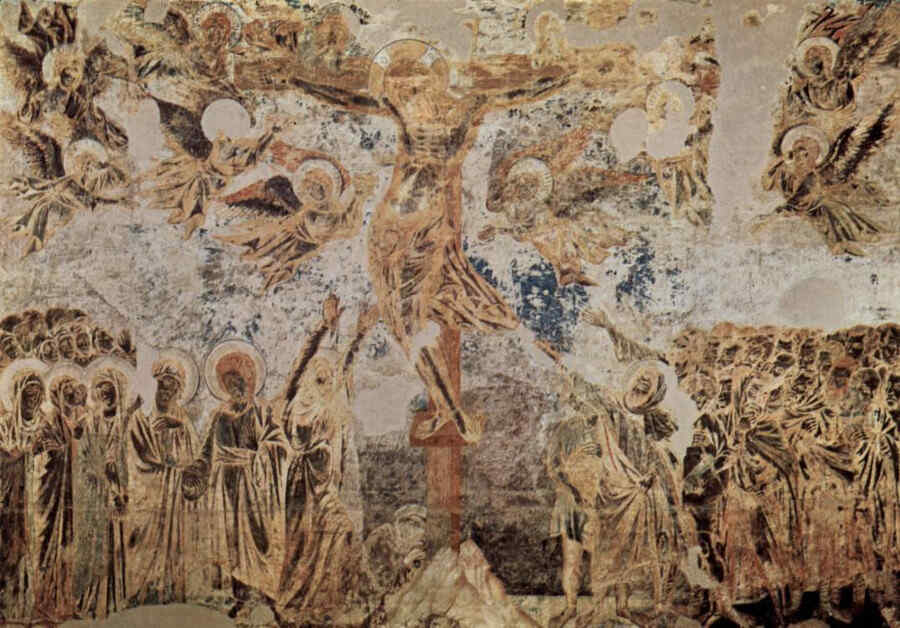 720a-7 Christ on the Cross by Cimabue. Here with Cimabue we see something, one might say, which has been flowing into souls during all the previous centuries. You see what lives here which came over from the Orient into Hellenism. We see in the image how earth and heaven are linked, how heaven is as active in its essence as the earth too, is active. Even in the depiction of the crucified Christ we can observe the two streams weaving through one another, as I have been speaking about. Within the world of art itself artistic creativity could not exist, while positive suggestions towards imagination was still being received out of the East. The next image I want to show is done by Giotto:  720b-36 Giotto (?) The Crucifixion, Assisi, San Francesco You nearly see this Giotto painting developing out of the earlier one (720a-7). You can still see the heaven activated by its beings. Still, the complete descent created out of the universality of the world has not taken place and entered into the earthly world. We already see the earthly, which still quite bashfully and shamelessly throbs in the Satyr- and Faun-types, we see rising here, their control spreading, idealizing, enforcing the human being, because what wanted to be expressed here could only show itself when it was permeated by Christ, through and through. Three things can be distinguished. Firstly those forms which exist in every cosmic soul are found in ancient art. You find then the battle of the human soul in the first depictions of Christian art. We are still in the kind of a battle as we have before us here. The cosmic element is still everywhere—I mean the spiritual cosmic, not the Copernican materialistic cosmic, but the spiritual cosmic—sparkling everywhere, yet at the same time from below the specific human soul is striving to take on the form which the soul gives to the body, wanting it to be revealed. This was the second element I want to present to you where the two battle with one another, where the human-soul opposes the cosmic-soul element. Perhaps this battle is most intensively depicted by Giotto compared to other artists. For this reason it is interesting that this particular battle can always be studied in a Giotto. Giotto strives from this one side quite significantly back to this model. He has a strong naturalistic vein yet in him remains the non-specific, one might say forms originating out of the spiritual world which were not yet so completely mastered by Cimabue. In the following image you see another “crucifixion” of Giotto:  721a-35 Giotto: Crucifixion (Padua, Arena-Chapel) The previous painting was not even a real Giotto, perhaps originating from someone else. Here we see Giotto in the most genuine sense. See how the heaven is not only implicated but definitely contributes to the image. Notice something entering here, also with the Redeemer's form—and this is our main focus today—something depicting the soul wretchedness in the way the bodies are constituted. Here we already see the human aspect coming in, which one never could see in an Apollo form. I ask you now to not consider the fact I'm about to reveal as inappropriate. What I want to say, I say reluctantly now and I hope that you will be mistaken if you want to believe the facts are inappropriate. Research orientated at truth results in something extraordinary. When we delve into an image such as this one by Giotto, we see a new element surface in the old tradition, a Greek orientated idealization which could only appear in the Faun and Satyr, a super-imposed idealisation of the human if we look at a Giotto, and then we may essentially put Giotto as an opponent to his master, Cimabue, who was fructified from the Orient. How does something new happen to be introduced here?—Now we arrive at something which is difficult to say: it spread out from an external point, outer territories of Europe which actually had their origin in Central Europe itself, which we have often seen originating from Central Europe: the very new impulse to configure the individual human element within the soul. Very little Roman blood flow for example in the present day Italians, really very little. A great deal has flowed in—refer to historical studies as far as ancient documents allow—much has flowed into Central European blood: from this comes fructification. The naturalistic, soul principle which lived in Giotto was created by the fructification through Romanism, the unimaginative Romanism plus this emanation from Central Europe. Romanism was actually great only in ideas which pre-occupied themselves, the social structure in the sense of abstract cosmology; what one regards as “State” is really a speciality product of Romanism, originating out of the Roman soul. The state which wanted to spread out over everything is a copy of what sprung in the Roman head where it originated. We now go to the next image, another Giotto:  721b-32 Giotto: Christ on the throne (Rome, St Peters) Here we see a Christ. I have chosen this image because here Giotto was most inspired to represent the old type of depiction as it came from the East. Only, look at the face, how much individuality he has brought into it! Look at each of these fingers lifted in the right hand, how many individual soul qualities have been brought into it, how in the best sense the spiritual-naturalistic lives in it! Here one gradually enters into the southern art in which the oriental essence is linked, with the cosmic-oriental essence; here enters something we have seen in images of Central Europe, something in its purity, without the cosmological essence, merely out of the human soul itself. The next image is once again a Giotto: 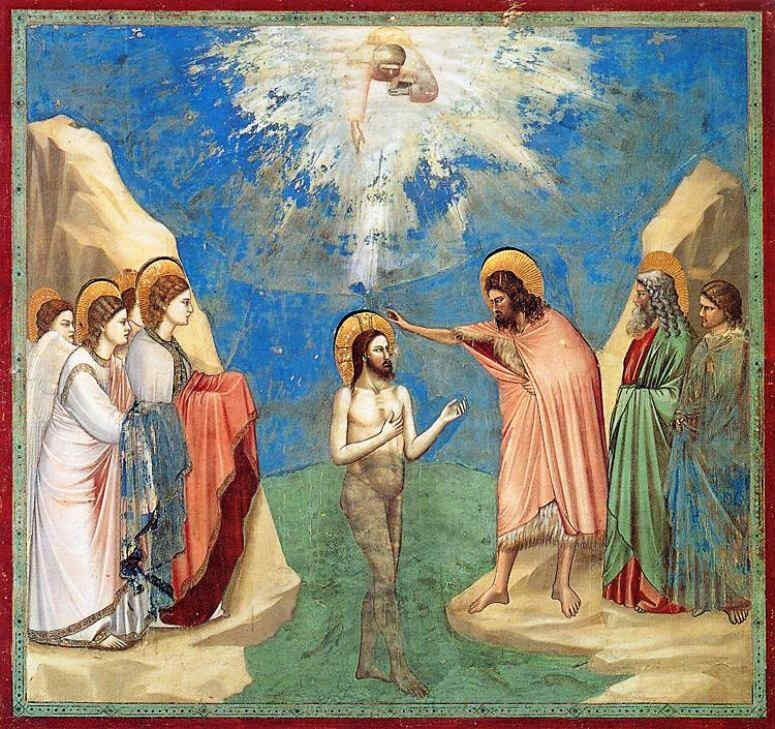 722a-21 Giotto: The Baptism of Christ. (Padua., Arena Chapel) Here too you see heaven and earth play into it. Now just look at the Christ figure itself and you will find how Giotto made the effort to allow the soul quality of the divine form to come to expression, not only in the face but in the entire figure, in the main bearing and hand gestures. Here we have another Giotto, the evening meal: 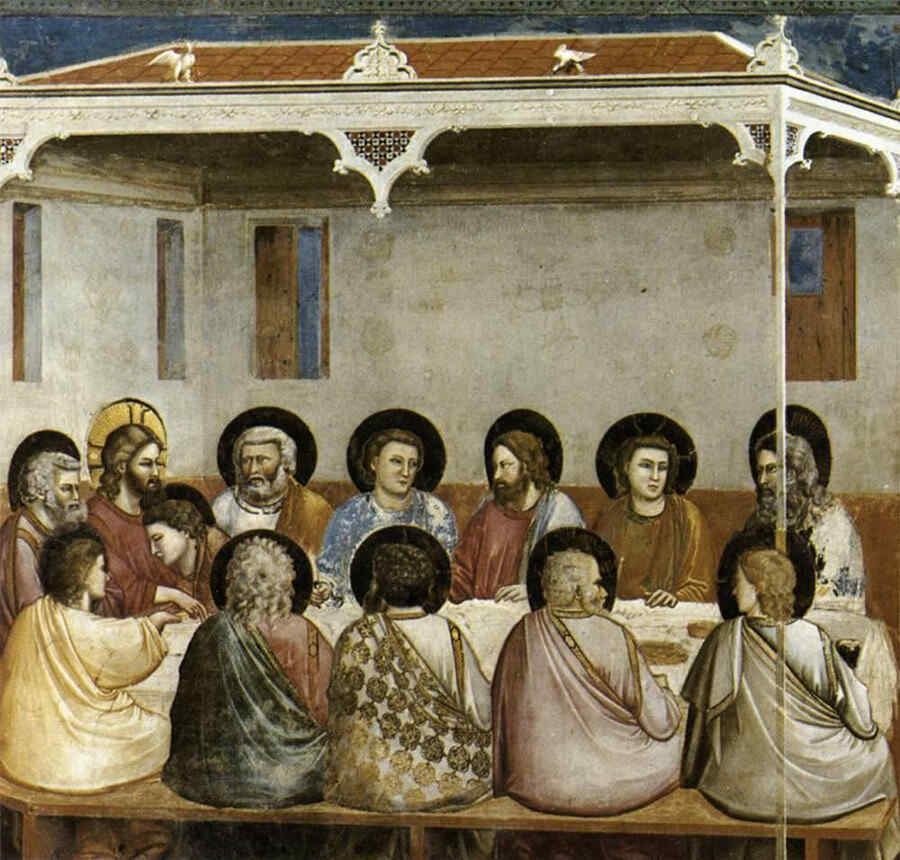 722b-34 Giotto: Evening meal (Padua, Arena Chapel) You see Christ on the left side partly coming to expression as the Greek Christ-type yet the effort to express the individuality of soul is also being made. Everywhere this insertion is apparent and so we see this extraordinary thing streaming forth which in the highest sense is artistic, oriental and still in the old Persian cultural impulse dependant on Central Europe, one could say, having a rendezvous with the inartistic, assessed purely on a State structured unimaginative basis. Another Giotto: 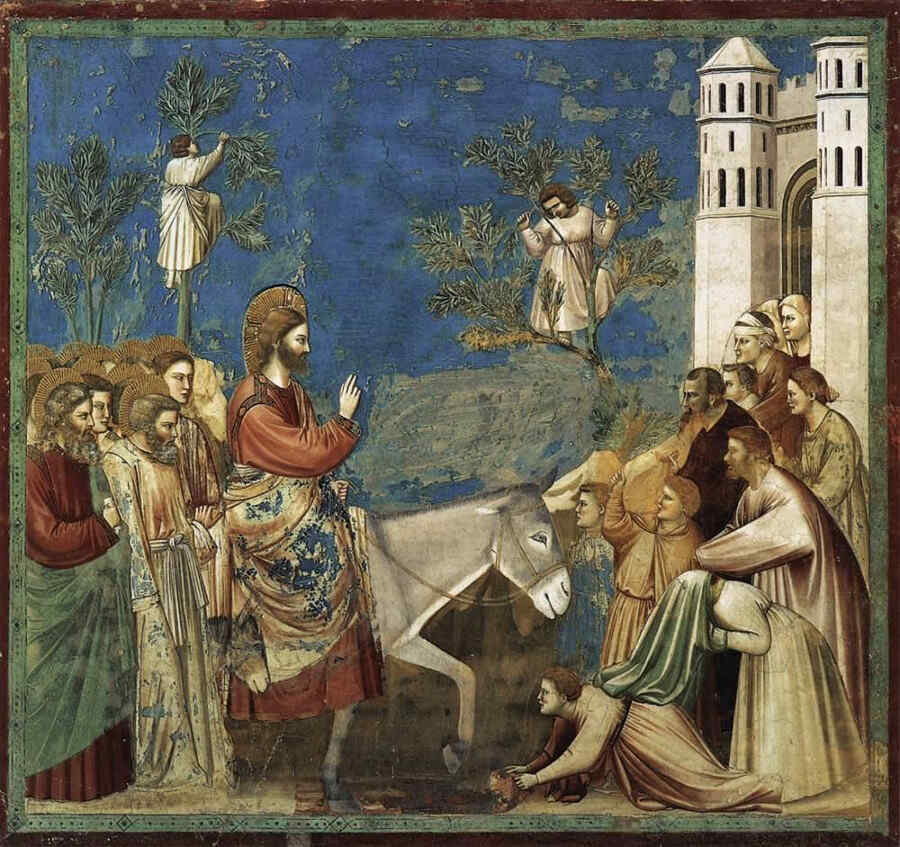 723a-40 Giotto: Journey into Jerusalem (Padua, Arena Chapel) ... which I have chosen again to present the same phenomenon to you. Just by taking these images of Christ in various biblical scenes does one see how Giotto endeavours to bring the individual expression into the soul nature. 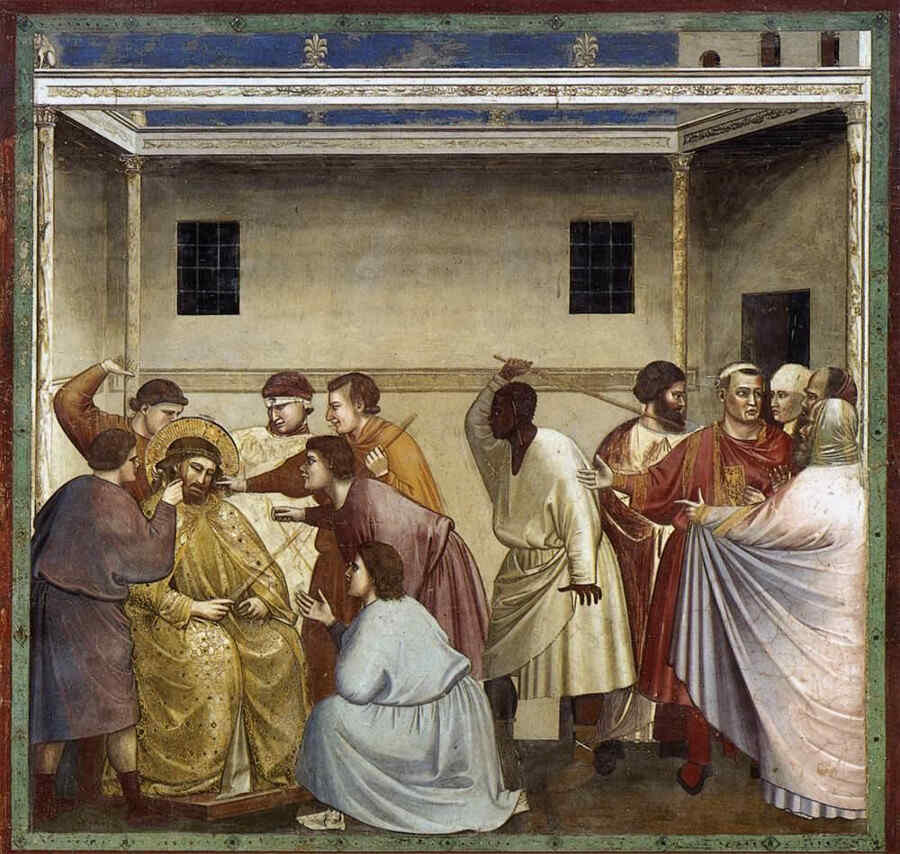 723b-33 Giotto: Crowned by Thorns (Padua, Arena chapel) We want to bring these changes of the Christ depiction itself to you as it took place through these centuries. Now think of the first tentative efforts we found in the ancient Christian art. Certainly a great deal depends on the material, but that materials were applied, that it was particularly used for these ideas, that is the important aspect which we see here. Now:  724a-31 Giotto: Resurrection (Padua, Arena Chapel) Everywhere you'll find the confluence of both streams of which I have spoken, confirmed. Perhaps at the same time you'll notice the intensity which works further with the Greek Christ-ideal type, because in the background, one could say, in the sleeping powers of the artists it was present everywhere. Now we come a little further. I have now chosen an image from the 14th century, by Orcagna depicting Christ as the World Ruler:  725 Andrea Orcagna: the Youngest Court (Florence, St Mary, Novella) It comes out of the church of Saint Mary Novalla in Florence. Here you clearly see the old type as an endeavour for a complete individualisation, the soul gently appearing. With this we are already in the 14th century. The various developmental streams of human culture move at different speeds. Up to here we don't only see the influence of the Greek Christ type but we also see some of the inspirational powers found in oriental art. I would like to state a fact and not a criticism: in all these images it does not come to be expressed what the Roman worldwide church domination within its full historical rights had initiated itself since the 9th century. The Greek influence actually existed in art with little influence from central Europe. Understand, this had to be so, from the second half of the 9th century it went well in Rome. Everyone knew, as I expressed it once, this `Eastern Being' had to be kept back. The western world had to be permeated with it out of the basis of the life of the folk striving towards something higher. Out of this we see a sentiment which I have characterised for you, which I identified with the liberated city culture, this free city culture which has its point of origin from central Europe and spread itself over various other territories. These free city cultures had the urge to express the specifically human soul element. Now in the 9th century Rome understood and thus considered this European impetus and carried it into account. The specific western form of Catholicism which spread through the institutionalised world churches was by contrast being held back in the Orient, and this Catholicism came to a specific expression in those artists and their art as most wonderfully expressed by Fra Angelico: 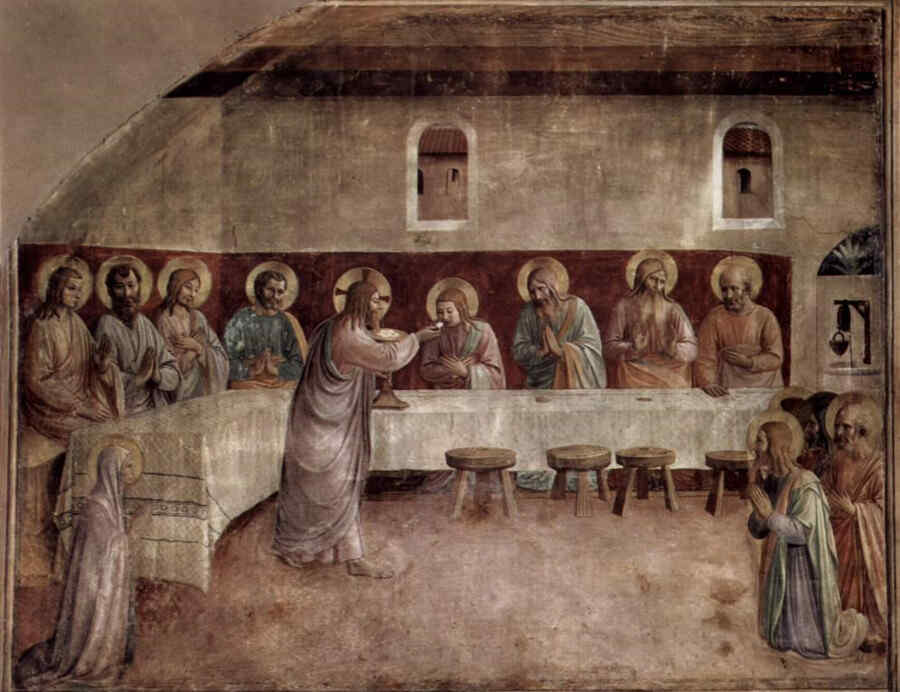 724b-65 Fra Angelico: Evening Meal. Here firstly we see—when we have an understanding for such things—the western Catholic element poured out in art. The differences between the previous (725) and this image (274b-65) as well as the previous Evening Meal (722b-34) and this image (724b-65) are unbelievable, because in these images, as it lives in well loved art, the western catholic sentiment is alive. Look at the forms into which the sacrifice has been brought, woven equally into the composition as a reminder of the Last Supper before the event of Golgotha. You don't only see the Last Supper but you see the continuation of the evening meal within the composition of the catholic sacrifice. Catholic sentiment is poured out over the image of the evening meal and particularly over the figure of the Redeemer. Here, primarily, the Redeemer is shown as a model in art to western priests. In reality He had been there much earlier, in outer reality. Thus we see the Roman world domination church spread its rule also over art in a totally decisive manner. In addition we can say Giotto created his artistic offering of Francis of Assisi out of a freed individual soul. Here we can see Fra Angelico who paints as well as Messe reads in San Marco in Florence. An aura of Catholicism permeates these images. He isn't an individual sacrifice, but paints the church with it. No less you see this in the following image of 726a-64 Fra Angelico: Crucifixion Catholicism paints into the art.  I ask you please to look closely at the next image and see how the being of the Catholic art actually is alive in the Catholic organization, that even in world domination, one could say, the organisational power of the Catholic Church works right into the realm of supernatural beings.  726b-68 Fra Angelico: World domination We find this now increasing with another friar, of which I want to show you the following image:  727 Friar Bartholemeo: Christ and the Four Evangelists Here we see the third stage in this interesting process. Look at the interplay of a new freshness as a resurrection out of old Hellenism. This entered now again, the old Greek influence. So we notice how for a long time the individualized soul concept of the Christ-type, which is of interest to us today, prevailed. Take the entire design as it evolved from the cosmic forces working from the beginning, which are then taken up as the individualised soul through the Greek impulses influencing it ever more, and how through this it became increasingly individualised. How was Christ individualised, my dear friends? Now we see how antiquity so recently intervened just a little but it is already in it. It is again working from the characteristic towards the typically-beautiful. This is notable as being continuous, because this is actually the secret of the Renaissance. These images I want to show you in conclusion are the starting point for the Renaissance artist, we see how the Renaissance artists completely renewed a rise in Hellenism but they didn't enter into that which conquered the form of an individual. Here you have the Evening Meal of Andrea del Sarto which is in Florence. 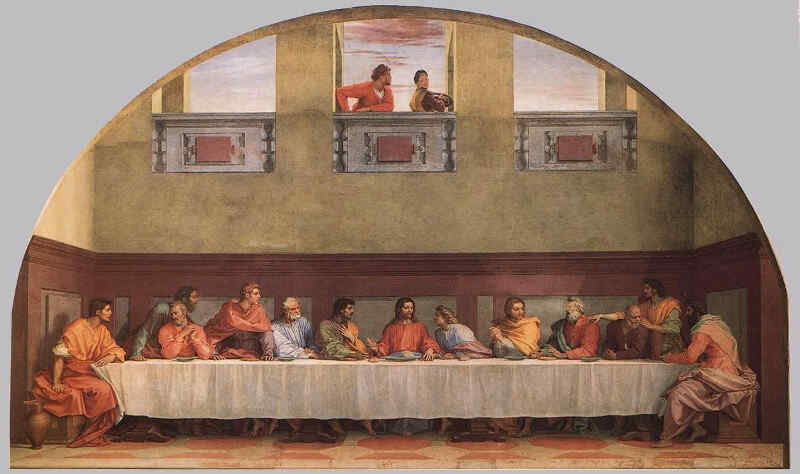 728 of Andrea del Sarto: Evening Meal. Again there are beautiful forms, with still a touch of cosmic consciousness which the Greeks still had, something of the traditions of a cosmic element brought into the forms but purely out of tradition and no longer from direct observation, with direct feelings as found among the Greeks. We discover it here; this is brought further by Raphael, Leonardo da Vinci and Michelangelo. We see something developing here which is particular to Leonardo da Vinci, in this image of the baptism by Verrocchio, the teacher of Leonardo.  729a-92 Verrocchio: Baptism of Christ The same motive done by Masolino during the same time period: 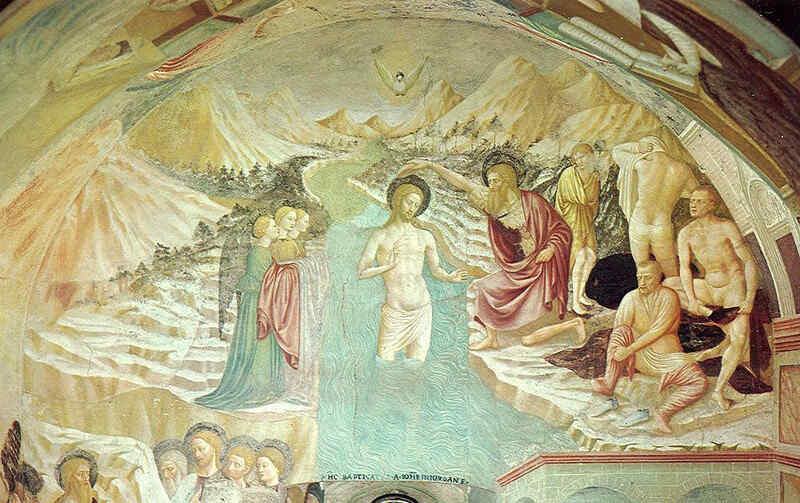 729b-50 Masolino: the Baptism of Christ Yet again I want to include the image “The Baptism” by Giotto:  722a-21 Giotto: the Baptism of Christ Look at the Baptism where the battle is still on between the two principles, without the Greek influence, also without the antique Greek impact, without the impact from antiquity, to the new Greek, the Christian impact particularly strong. Now we bring out the two other images:  729a-92 Verrocchio: Baptism of Christ 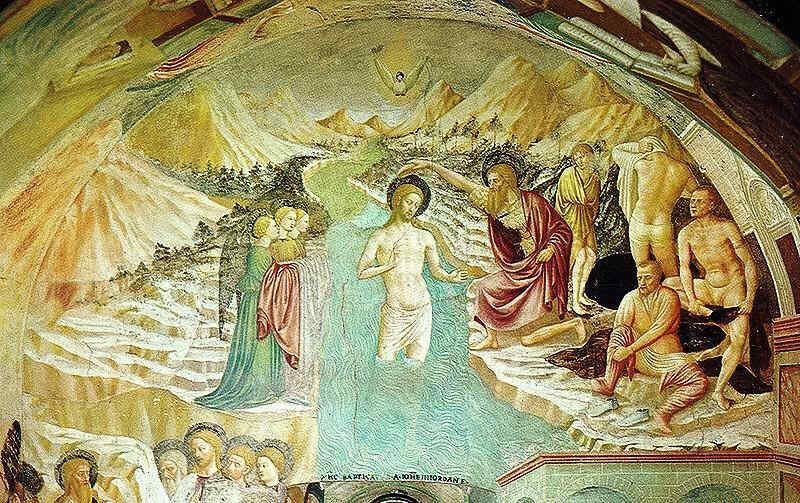 729b-50 Masolino: the Baptism of Christ You see how the Renaissance works. Out of a Verrocchio comes a Leonardo; perhaps Leonardo even worked on these paintings too. Now I would in closing still show 2 paintings, in which you would be able to see what came over from the North, from Central Europe and how all of this mixed into the others. We have a northern product here, the Man of Sorrows, by Dürer:  730a-303 Dürer: Man of Sorrows Here we have the endeavour without a cosmic aspect: the human Christ. Where Fra Angelico poured the Catholic aspects over his artistic creations, here we see the formation against world domination, here we see how the human individual wants to depict His Christ. Here a single human being worked on one image. While Fra Angelico painted in the San Marco Church in Florence, the whole Catholic sentiment painted with him. Here a single person worked on his biblical depiction. This became fixed in this particular time. Later the Renaissance came but moved South, mixing with other influences. I still have another image which depicts a similar kind of thing:  730b-311 Dürer: Christ on the Cross. These things should show us how through the centuries the Christ image changed. I have demonstrated this with these two images from later centuries. I would like in the further progress of these ideas, if it is possible, to show you how these Christ images develop further. A world history can be written since the Mystery of Golgotha by simply describing the changes in the development of the Christ paintings and images. Everything which in reality contributed to it is expressed clearly. One could continue with this right up to the present. Christ depictions are researched at the present time: years ago I saw a whole collection of Christ images in an exhibition, the one more hideous than the next! Today the attempt is to make reflections of present events thus reflecting the chaos leading up to events in which we live. If we try—without this tendency I've just spoken about in the creation of Christ figures—if we try to introduce what lies within this form in the spiritual world, shaped initially by our first efforts through painting, as good as it gets with limited material, then it does appear as a further progress on this cultural line of the realities of humanity's unfolding. RUDOLF STEINER 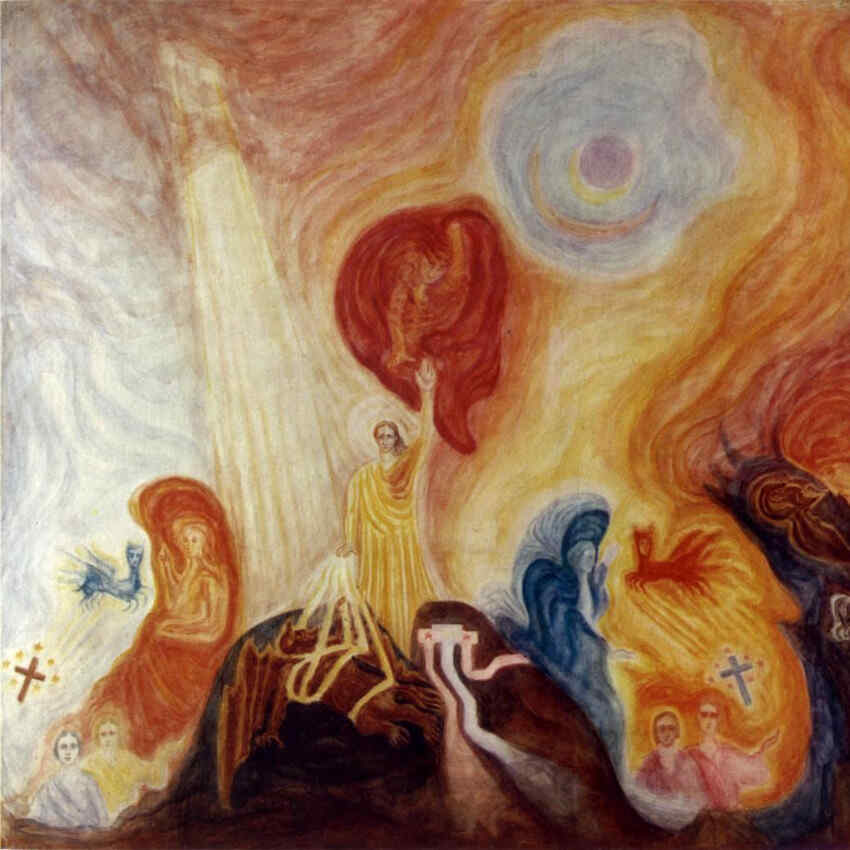 731 Painting (Plant colours) in the small cupola of the First Goetheanum, Dornach, detail with the central motif, with part of the architraves. 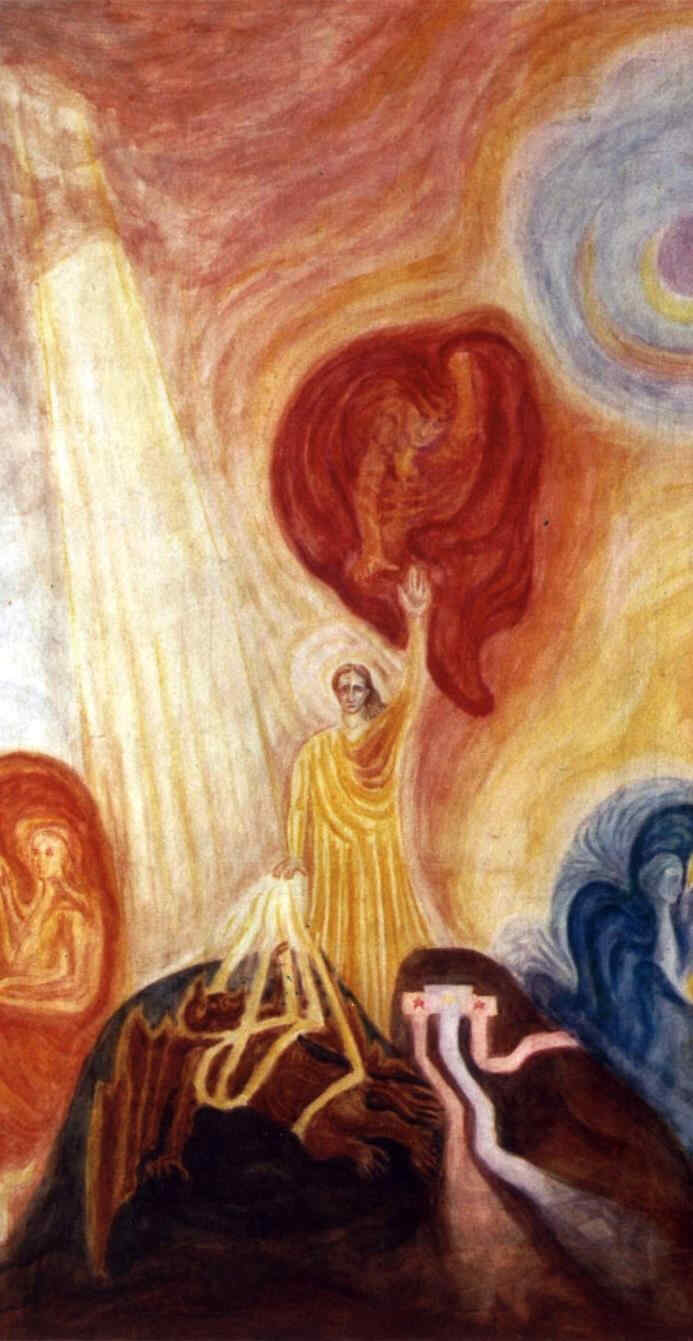 732 Painting (Plant colours) in the small cupola of the First Goetheanum, Dornach, Central Motif: The Representative of Man between Lucifer and Ahriman. 732 Painting (Plant colours) in the small cupola of the First Goetheanum, Dornach, Central Motif: The Representative of Man between Lucifer and Ahriman. 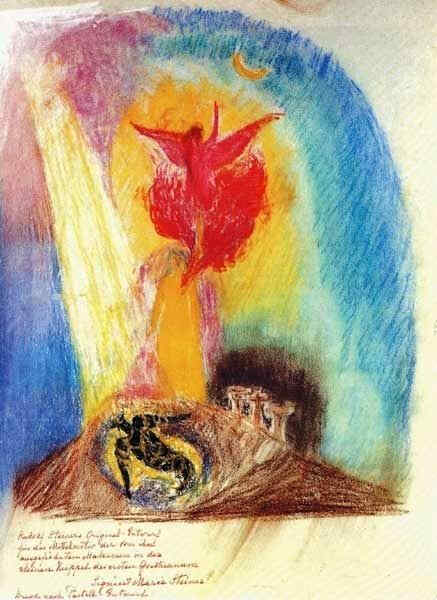 732 Painting (Plant colours) in the small cupola of the First Goetheanum, Dornach, Central Motif: The Representative of Man between Lucifer and Ahriman. 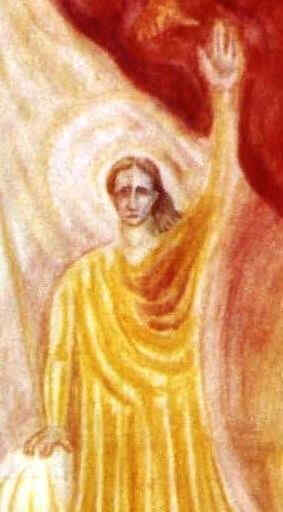 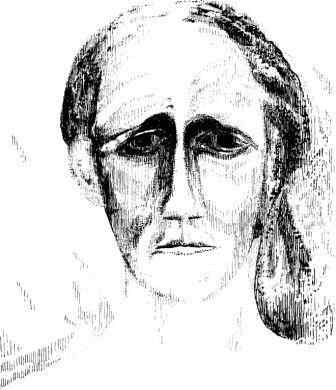 734 Painting in the small cupola of the First Goetheanum, Dornach. Section: Bust of The Representative of Man. 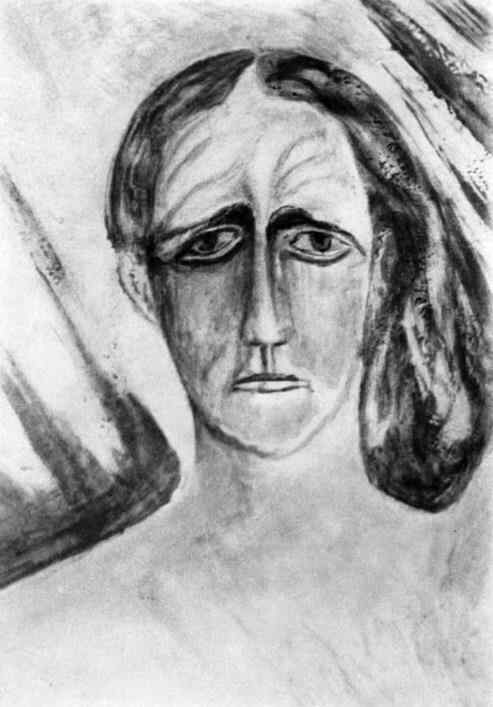 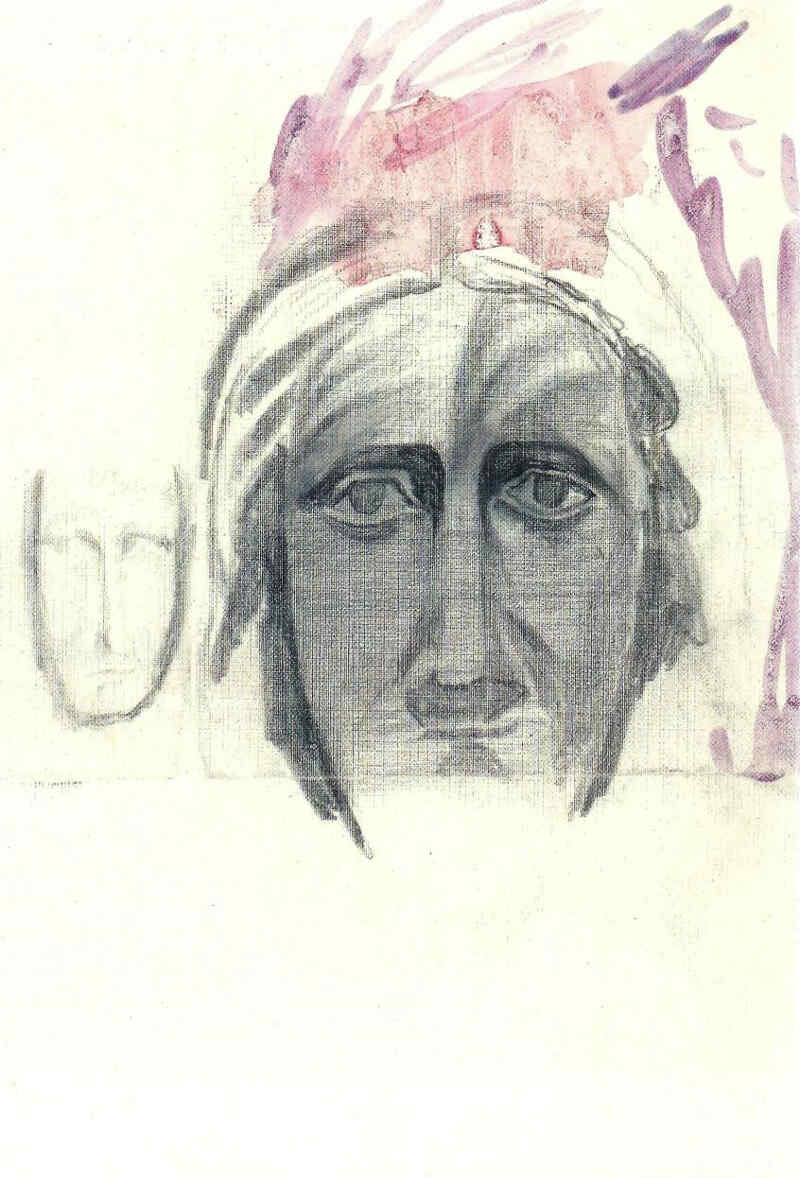 735 Visage of The Representative of Man, pencil sketch.  736 Wood sculptural group: The Representative of Man between Lucifer and Ahriman. 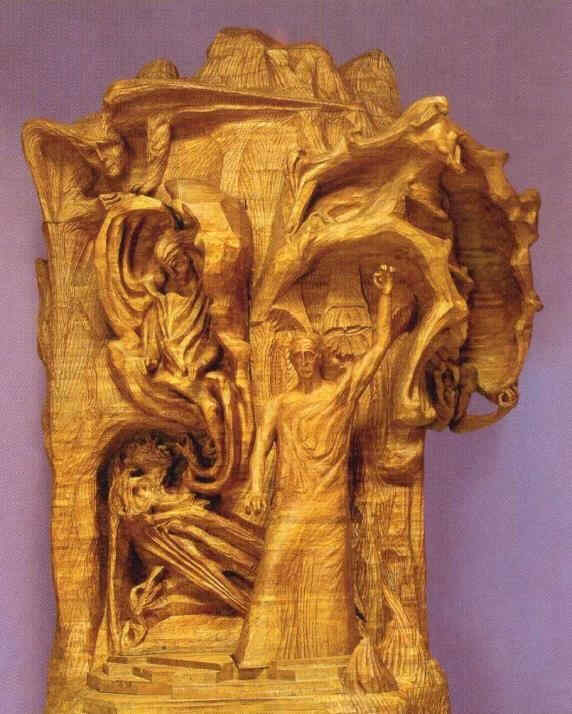 737 Wood sculptural group: Detail: The Representative of Man. 738 Maquette for the wood sculptural group, a Plaster of Paris cast.  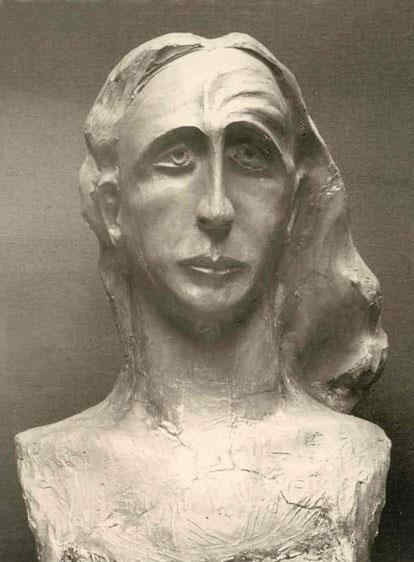 739 Wood sculptural group, detail: Head of The Representative of Man, side view. 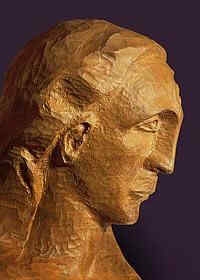 740 Wood sculptural group, detail: Head of The Representative of Man. 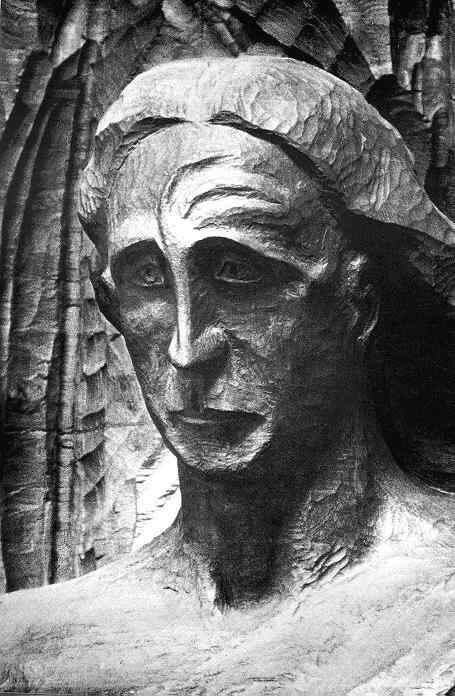 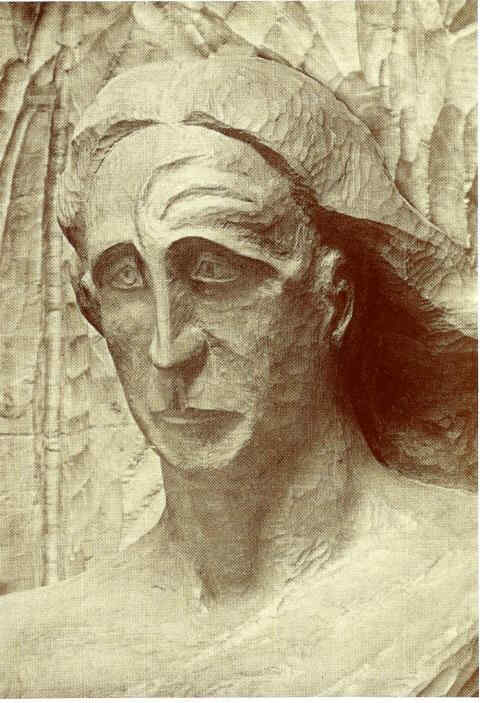 741 Study of the head of The Representative of Man, plasticine.  It is really good in the present time to fructify ourselves with such ideas which can be gained from cultural areas of art, and see a bit of the truth, because in the present time gods will be offered to mankind to be worshipped, while mankind will have no talent for seeing the truth. In our time (1917) it is possible to say that four fifths of the world should ally itself against a fifth, in a time when so much indifference is accepted, it is time for recorded concepts to be taken out of the history of humanity's evolution and to revise them a little. |
| 293. The Study of Man: Lecture I
21 Aug 1919, Stuttgart Translated by Daphne Harwood, Helen Fox Rudolf Steiner |
|---|
| Indeed our intentions will only be fully accomplished when we, as humanity, will have reached the stage where parents, too, will understand that special tasks are set for mankind to-day, even for the first years of the child's education. |
| We must first gain an Anthropological-Anthroposophical understanding of the human being. Thus, the most important measures in education will consist in paying attention to all that rightly organises the breathing process into the nerve-sense process. |
| The child sleeps his very way into life.” Nevertheless, what inwardly underlies sleeping and waking, this the child cannot yet do. The child experiences all sorts of things on the physical plane. |
| 293. The Study of Man: Lecture I
21 Aug 1919, Stuttgart Translated by Daphne Harwood, Helen Fox Rudolf Steiner |
|---|
We will begin by making a preliminary survey of our educational task; and to this I would like to give you a kind of introduction to-day. Of necessity our educational task will differ from those which mankind has set itself hitherto. Not that we are so vain or proud as to imagine that we, of ourselves, should initiate a new world-wide order in education, but because from anthroposophical spiritual science we know that the epochs of human evolution as they succeed each other must always set humanity fresh tasks. The task of mankind in the first Post-Atlantean epoch was different, it was different again in the second, and so on down to our fifth Post-Atlantean epoch. And we must realise that, in actual fact, what has to be accomplished in any one epoch of human evolution does not enter into the consciousness of mankind until some time after this epoch has begun. The epoch of evolution in which we live to-day began in the middle of the fifteenth century. And only now is there coming forth, from spiritual depths as it were, a perception of what has to be done in this epoch, particularly in the realm of education. Hitherto, even with the best will in the world, men's work in education has been done in the light of the old education; I mean in the sense of the education of the fourth Post-Atlantean epoch. Now much will depend on our placing ourselves in the right relation to our task at the outset. We must learn to understand that we have to give a very definite guidance to our age—guidance which is of importance, not because it is considered valid for the whole evolution of humanity, but because it is valid just for this age of ours. For, amongst other things, materialism has brought it about that men have no idea of the particular tasks of a particular age. Please do understand this at the very beginning: particular epochs have their own particular tasks. You will have to take over children for their education and instruction—children who will have received already (as you must remember) the education, or mis-education given them by their parents. Indeed our intentions will only be fully accomplished when we, as humanity, will have reached the stage where parents, too, will understand that special tasks are set for mankind to-day, even for the first years of the child's education. But when we receive the children into the school we shall still be able to make up for many things which have been done wrongly, or left undone, in the first years of the child's life. For this we must fill ourselves with the consciousness through which alone we can truly teach and educate. In devoting yourselves to your task do not forget that the whole civilisation of to-day, even into the sphere of the most spiritual life, is founded on the egoism of humanity. In the first place, consider with an open mind that domain of spiritual life which receives men's reverence to-day—the domain of religion. Ask yourselves if our present civilisation, particularly in the religious sphere, is not so constituted, as to appeal to man's egoism. It is typical of all sermons and preaching of our time that the preacher tries to reach men through their egoism. Take for example that question which should concern people most deeply—the question of immortality. You will see how almost everything to-day, even in sermons and exhortations, is directed by the preachers to appeal to man's egoism in the super-sensible sphere. Egoism impels man to cling to his own being as he passes through the gate of death, to preserve his Ego. This is a form of egoism, however refined. And to-day every religious denomination appeals largely to this egoism when treating of immortality. Hence official religion mostly forgets one end of our earthly existence in addressing man, and takes account only of the other. It fixes its gaze on death and forgets birth. Though these things may not be openly acknowledged, they are nevertheless underlying tendencies. We live in a time when this appeal to human egoism must be combated in every domain, if the life of mankind is not to decline further and further on its present downward course. We must become more and more conscious of the other end of man's development on earth, namely birth. We must consciously face this fact: that man evolves through a long period between death and a new birth and that then, within this evolution, he reaches a point where he dies, as it were, for the spiritual world—where conditions of his life in the spiritual world oblige him to pass over into another form of existence. He receives this other form of existence in that he lets himself be clothed with the physical and etheric body. What he has to receive by being clothed with the physical and etheric body he could not receive if he were simply to go on evolving in a straight line in the spiritual world. Hence although from his birth onwards we may only look upon the child with physical eyes, we will all the time be conscious of the fact—“this too is a continuation.” And we will not only look to what human existence experiences after death, i.e. to the spiritual continuation of the physical; but we will be conscious that physical existence here is a continuation of the spiritual, and that we, through education, have to carry on what has hitherto been done by higher beings without our participation. This alone will give the right mood and feeling to our whole system of teaching and education, if we fill ourselves with the consciousness: here, in this human being, you, with your action, have to achieve a continuation of what higher beings have done before his birth. In this age when men have lost connection with the spiritual worlds in their thought and feeling, we are often asked an abstract question which in the light of a spiritual conception of the world has no real meaning. We are asked how so-called pre-natal education should be conducted. There are many people to-day who take things abstractly, but, if one takes them concretely,' then in certain domains one simply cannot continue asking questions in an arbitrary manner. I once gave this example: on a road we see tracks. We can ask: Why are they there? Because a carriage has been driven over the road. Why was the carriage driven? Because its occupants wanted to reach a certain destination. Why did they want to reach a certain destination? The asking of questions must come to a stop somewhere in reality. If we remain in abstractions we can continue for ever asking: Why? We can go on turning the wheel of questions without end. Concrete thought will always find an end, but abstract thought goes on running round like a wheel for ever. And so it is with the questions that are asked about domains that do not lie so close at hand. People begin thinking about education and then they ask about pre-natal education. But, my dear friends, before birth the human being is still in the protection of Beings who stand above the physical. It is to them that we must leave the immediate and individual relationship between the world and the human being. Hence a pre-natal education cannot be addressed to the child itself. It can only be an unconscious result of what the parents—especially the mother—achieve. If until birth the mother behaves in such a way that she brings to expression in herself what is morally and intellectually right, in the true sense of the word, then of its own accord what the mother achieves in this continuous self-education will pass over to the child. The less we think of beginning to educate the child before it sees the light of the world and the more we think of leading a right and proper life ourselves, the better will it be for the child. Education can only begin when the child becomes a true member of the physical world—and that is when he begins to breathe the external air. Now when the child has come forth on to the physical plane, we must realise what has really happened for him in the transition from a spiritual to a physical plane. Firstly, we must recognise that the human being is really composed of two members. Before the human being comes down to earth a union is entered into between the spirit and the soul—meaning by spirit what for the physical world of to-day is still entirely hidden, and what in Spiritual Science we call Spirit-Man, Life-Spirit, Spirit-Self. These three members of man's being are present in a certain way in the super-sensible sphere to which we must now work our way through. And between death and a new birth we do already stand in a certain relationship to Spirit-Man, Life-Spirit, Spirit-Self. Now the force which proceeds from this trinity permeates the Soul element in man: Consciousness Soul, Intellectual or Mind Soul, and Sentient Soul. And if you were to observe the human being when, having passed through the existence between death and a new birth, he is just preparing to descend into the physical world, then you would find the spiritual which we have just described united with the soul. Man descends, as it were, as Spirit-Soul or Soul-Spirit from a higher sphere into earthly existence. He clothes himself with earthly existence. In a similar way we can describe the other member of man's being which unites itself with the one just described. We can say: down there on the earth the Spirit-Soul is met by what arises through the processes of physical inheritance. And now the Soul-Spirit or Spirit-Soul meets with the Life-Body in such a way that two trinities are united with two other trinities. In the Spirit-Soul: Spirit-Man, Life-Spirit and Spirit-Self are united with that which is soul, namely: Consciousness-Soul, Intellectual Soul and Sentient Soul. These two trinities are united with one another, and descend into the physical world where they are now to unite with the Sentient or Astral body, Etheric body and Physical body. But these in turn are united—first in the body of the mother and then in the physical world—with the three kingdoms of the physical world: the mineral, the plant and the animal kingdoms. So that here again, two trinities are united with one another. If you regard with an open mind the child who has found his way into earthly life, you will observe that here in the child, Soul-Spirit or Spirit-Soul is as yet dis-united from the Life-Body. The task of education conceived in the spiritual sense is to bring the Soul-Spirit into harmony with the Life-Body. They must come into harmony with one another. They must be attuned to one another; for when the child is born into the physical world, they do not as yet fit one another. The task of the educator, and of the teacher too, is the mutual attunement of these two members. Let us now consider this task more concretely. Amongst all the relationships which man has to the external world, the most important of all is breathing. We begin breathing at the very moment we enter the physical world. Breathing in the mother-body is still, if I may put it so, a preparatory breathing: it does not yet bring the being into a complete connection with the external world. The child only begins to breathe in the right sense of the word when he has left the mother-body. Now this breathing signifies a very great deal for the human being, for in this breathing there dwells already the whole threefold system of physical man. You know that amongst the members of the threefold physical human system we reckon, in the first place, the digestion and metabolism. But the metabolism, the assimilation, is intimately connected at one end with the breathing. The breathing process is connected with the blood circulation through metabolism. The blood circulation receives into the human body the substances of the external world which are introduced by another path, so that on the one hand the breathing is connected with the whole metabolic system or digestive system. On the other hand the breathing is also connected with the nerve-sense life of man. As we breathe in, we are continually pressing the cerebro-spinal fluid into the brain: and, as we breathe out, we press it back again into the body. Thus we transplant the rhythm of breathing to the brain. And as the breathing is connected on the one hand with digestion and assimilation, so on the other hand it is connected with the life of nerves and senses. We may say: the breathing is the most important mediator between the outer physical world and the human being who is entering it. But we must also be aware that this breathing cannot yet, by any means, function so as fully to maintain the life of the body. This applies particularly to the one side of breathing. At the beginning of his physical existence man has not yet achieved the right harmony, the right connection between the breathing process and the nerve-sense process. Observation of the nature of the child will show us that he has not yet learnt to breathe in such a way that breathing maintains the nerve-sense process rightly. In this lies the finer characterisation of what we really have to do with the child. We must first gain an Anthropological-Anthroposophical understanding of the human being. Thus, the most important measures in education will consist in paying attention to all that rightly organises the breathing process into the nerve-sense process. In the higher sense the child has to learn to take up into his spirit what is bestowed on him in that he is born to breathe. This part of education will, you see, tend to the side of the soul and spirit. By harmonising the breathing with the nerve-sense process we draw all that is soul and spirit into the physical life of the child. To express it roughly we may say: the child cannot yet breathe in the right inner way, and education will have to consist in teaching the child to breathe rightly. But there is yet another thing which the child cannot do rightly, and this must be taken in hand, in order that a harmony may thereby be created between the two members of the child's being—between the bodily corporeality and the Spirit-Soul. What the child cannot do properly at the beginning of his existence is this: he cannot yet accomplish the alternation between waking and sleeping in the way proper to man. It will strike you that what we have to emphasise from the spiritual side generally appears to be in contradiction to the external world-order. Externally speaking it is of course possible to say: “But the child can sleep perfectly well: indeed he sleeps far more than the human being at a later stage of life. The child sleeps his very way into life.” Nevertheless, what inwardly underlies sleeping and waking, this the child cannot yet do. The child experiences all sorts of things on the physical plane. He uses his little limbs: he eats, drinks and breathes. He alternates between sleeping and waking, but he is not able to carry into the spiritual world in sleep all that he experiences on the physical plane—all that he sees with his eyes, and hears with his ears, and does with his little hands, and the way he kicks and tosses with his little legs. All this he is not able to carry into the spiritual world and work upon there, carrying the results of this work back again on the physical plane. The child's sleep is characterised by the very fact that it is a different sleep from that of the grown-up person. What distinguishes the sleep of the adult is that his experiences during waking life are then worked upon, are metamorphosed. The child is not yet able to carry into his sleep what he has experienced between waking and falling asleep again. Thus in sleep the child still lives his way into the universal world order without being able to take with him what he has experienced externally in the physical world. It is this that a rightly guided education must accomplish: it must enable the human being to carry over his experiences on the physical plane into what the Soul-Spirit or Spirit-Soul is engaged upon during sleep. We, as teachers and educators, cannot really teach the child anything about the higher world. For what enters the human being from the higher world enters in during the time between falling asleep and waking again. All we can do is to use the time which the human being spends on the physical plane in such a way that he gradually becomes able to carry over into the spiritual world what we have done with him here; and that, in carrying it over, he can receive and bring back with him power from the spiritual world which will help him to be a true human being in physical existence. Thus you see that all our activity of teaching and education is first directed to a very lofty domain—namely to the teaching of right breathing, and to the teaching of the right rhythm in the alternation of sleeping and waking. Needless to say, my dear friends, in our educational practice there will be no question of direct training of the breathing, or of direct training of sleeping and waking. All this will only be in the background. What we have to learn will be concrete measures of educational practice. But we must be conscious of what we are doing, right down to the foundations. When we teach this subject or that, we must be fully aware that we are working either in the one direction to bring the Spirit-Soul more into the earthly Body, or in the other direction to bring the bodily nature into the Spirit-Soul. Do not let us underestimate the importance of what has now been said. For you can only become good teachers and educators if you pay attention not merely to what you do, but also to what you are. It is really for this reason that we have Spiritual Science with its anthroposophical outlook: to perceive the significance of the fact that man is effective in the world not only through what he does, but above all through what he is. Truly, my dear friends, it makes a very great difference whether one teacher of the school or another comes through the classroom door to any group of children. There is a big difference; and the difference is not merely that the one teacher is more skilful in his practice than the other. No, the main difference—the one that is really influential in teaching—lies in what the teacher bears within him, as his constant trend of thought, and carries with him into the classroom. A teacher who occupies himself with thoughts of the evolving human being will work very differently upon his pupils from a teacher who knows nothing of all these things, and never gives them a thought. Once you begin to know the cosmic significance of the breathing process and of its transformation through education, and the cosmic significance of the rhythm between sleeping and waking—what is it that happens? The moment you have such thoughts something in you is combating your purely personal nature. The moment you have such thoughts the very basis of this spirit of personality is of less effect. In that moment all that enhances a personal spirit is damped down, all that man possesses through the fact that he is a physical man. If you have quenched this personal spirit, then, as you enter the classroom, it will come about through inner forces that a relationship is established between the pupils and yourself. Now it may be that at first external facts will contradict this. You enter the school and perhaps you find yourself faced with scamps, both boys and girls, who make fun of you. Now you must be so strengthened with such thoughts as we shall here cultivate, that you do not pay any attention to their ridicule but accept it as something perfectly external. Accept it, shall I say, like the external circumstances that when you go out without an umbrella it suddenly begins to rain. Undoubtedly this is an unpleasant surprise. But we usually make a distinction between being ridiculed and being taken by surprise in a shower when we have no umbrella. This distinction must not be made. We must evolve thoughts so strong that the distinction is not made—that we take ridicule like a good shower of rain. If we are permeated by these thoughts and have real faith in them then (perhaps after a week, or a fortnight, or maybe longer still), we shall certainly find that however much the children may laugh at us, we have nevertheless established a relationship with them such as we would wish. Through what we make of ourselves we must come to this relationship, even in the face of difficulty and resistance. And we must above all become conscious of this first of educational tasks: that we must first make something of ourselves, so that a relationship in thought, an inner spiritual relationship, may hold sway between the teacher and the children. So that we enter the classroom with the conscious thought: this spiritual relationship is present—not only the words, not only all that I say to the children in the way of instruction and admonition, not only my skilfulness in teaching. These are externals which we must certainly cultivate, but we shall only cultivate them rightly if we establish the importance of the relation between the thoughts that fill us and the effects of our teaching on the children, in body and soul. Our whole conduct and bearing as we teach will not be complete unless we keep this thought in our minds: the human being was born. Thereby the possibility was given him to do what he could not do in the spiritual world. We have to teach and educate first of all so as to give the breathing its right harmony in relation to the spiritual world. The human being could not accomplish the rhythmical alternation between waking and sleeping in the same way in the spiritual world as in the physical world. By education, by teaching, we must regulate this rhythm in such a way that the bodily nature in the human being becomes properly membered with the Soul-Spirit. Needless to say, this is not something that we should have before us as an abstraction, and apply it as such directly to our teaching, but this thought about the human being must be our rule and guide. This is what I wanted to give you in this present introduction. To-morrow we will begin with the subject of education proper. |
| 293. The Study of Man: Lecture II
22 Aug 1919, Stuttgart Translated by Daphne Harwood, Helen Fox Rudolf Steiner |
|---|
| It is impossible for you to comprehend the being of man unless you understand the difference between the elements of sympathy and antipathy in man. These elements, as I have described, find their full expression in the soul world after death. |
| Here we come to a very important fact about the human being. You must learn to understand the whole man, spirit, soul and body. Now in man there is something continually being formed which always has the tendency to become spiritual. |
| Now you will have seen, from what I have here developed, that really the human being can only be understood in connection with the cosmos. For when we make mental pictures we have what is cosmic within us. |
| 293. The Study of Man: Lecture II
22 Aug 1919, Stuttgart Translated by Daphne Harwood, Helen Fox Rudolf Steiner |
|---|
In the future all teaching must be founded on a real psychology—a psychology which has been gained through an anthroposophical knowledge of the world. Of course it has been widely recognised that instruction and education generally must be built up on psychology, and you know that Herbartian pedagogy, for instance, which has influenced great numbers of people, founded its educational standards on Herbartian psychology. Now during the last few centuries and up to recent times there has been something present in the life of man which prevents a real practical psychology from coming into being. This can be traced to the fact that in the age in which we now are, the age of the Consciousness Soul, man has not yet reached the spiritual depth which would enable him to come to a real understanding of the human soul. But those concepts which have been built up in past times in the sphere of psychology—the science of the soul—out of the old knowledge of the fourth Post-Atlantean period, have become more or less devoid of content to-day: they have become mere words. Anyone who takes up psychology or anything to do with psychological concepts will find that there is no longer any real content in the books on the subject. They will have the feeling that psychologists only play with concepts. Who is there to-day for instance who develops a really clear conception of what mental picture or will is? In psychologies and theories of education you can find one definition after another of mental picture and of will, but these definitions will not be able to give you a real mental picture, a real idea, either of mental picture itself or of will. Psychologists have completely failed—owing to an external, historical necessity, it is true—to make any connection between the soul life of the individual human being and the whole universe. They were not in a position to understand how the soul-life of man stands in relation to the whole universe. It is only by perceiving the connection between the individual human being and the whole universe that it is possible to arrive at the idea of the being “man.” Let us look at what is ordinarily called mental picture. We must develop this, as well as feeling and willing, in the children, and to this end we must first of all gain a clear conception of the mental picture. Anyone who looks with an open mind at what lives in men as this activity will at once be struck by its image character. The mental picture is of the nature of an image. And those who try to find in it the character of existence or being are subject to a great illusion. What would it be for us if it were “being”? We certainly have elements of being in us also. Think only of our bodily elements of being: to take a somewhat crude example: your eyes, they are elements of being, your nose or your stomach, that is an element of being. It will be clear to you that you live in these elements of being, but you cannot make mental pictures with them. You flow out with your own nature into the elements of being, and you identify yourself with them. The possibility of understanding, of grasping something with your mental pictures arises from the fact that they have an image character, that they do not so merge into us that we are in them. For indeed, they do not really exist, they are mere images. One of the great mistakes of the last period of man's evolution during the last few centuries, has been to identify being with thought as such. Cogito ergo sum (I think therefore I am), is the greatest error that has been put at the summit of recent philosophy, for in the whole range of the Cogito there lies not the sum but the non sum. That is to say, as far as my knowledge reaches I do not exist, but there is only image. Now when you consider the image character of mental picturing you must above all think of it qualitatively. You must consider its mobility, one might almost say its activity of being, but that might give too much the impression of being, of existence, and we must realise that even activity of thought is only an image activity. Everything which is purely movement in mental picturing is a movement of images. But images must be images of something; they cannot be merely images as such. If you think of the comparison of mirror images you can say to yourselves: out of the mirror there appear mirror images, it is true, but what is in the mirror images is not behind the mirror, it exists independently somewhere else. It is of no consequence to the mirror what is to be reflected in it; all sorts of things can be reflected in it. When we have thus clearly grasped that the activity of mental picturing is of this image nature, we must next ask: of what is it an image? Naturally no outer science can tell us this, but only a science founded on Anthroposophy. Mental picturing is an image of all the experiences which we go through before birth, or rather conception. You cannot arrive at a true understanding of it unless it is clear to you that you have gone through a life before birth, before conception. And just as ordinary mirror images arise spatially as mirror images, so your life between death and re-birth is reflected in your present life and this reflection is mental picturing. Thus when you look at it diagrammatically you must mentally picture the course of your life to be running between the two horizontal lines bounded on the right and left by birth and death. 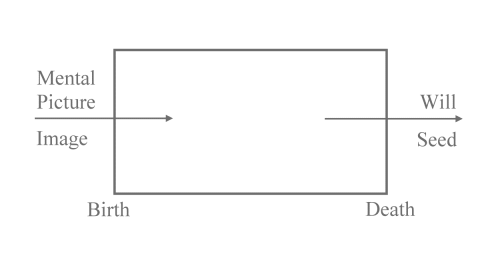 You must then further represent to yourself that mental picturing is continually playing in from the other side of birth and is reflected by the human being himself. And it is because the activity which you accomplish in the spiritual world before birth or conception is rejected by your bodily nature that you experience mental picturing. For true knowledge this activity is a proof, because it is an image, of life before birth. I want to place this first before you as an idea (we shall come back to a real explanation of these things later) in order to show you that we can get away from the mere verbal explanations which you find in psychologies and theories of education, and arrive at a true understanding of what the activity of mental picturing is, by learning to know that in it we have a reflection of the activity which was carried on by the soul before birth or conception, in the purely spiritual world. All other definitions of mental picturing are of absolutely no value, because they give us no true idea of what it is. We must now investigate will in the same way. For the ordinary consciousness will is really a very great enigma. It is the crux of psychologists simply because to the psychologist will appears as something very real but basically without content. For if you examine what content psychologists give to will you will always find that this content comes from mental picturing. As for will itself it has no immediate real content of its own. Then again the fact is that there are no definitions of will: these definitions of will are all the more difficult because it has no real content. But what is will really? It is nothing else but the seed in us of that which after death will be reality of spirit and of soul. Thus when you picture to yourself what will be our spirit-soul reality after death, and picture it as seed within us, then you have will. In our drawing our life's course ends with death on the one side, and will passes over beyond it. Thus we have to picture to ourselves: mental picturing on the one hand, which we must conceive of as an image from pre-natal life; and will, on the other hand, which we must conceive of as the seed of something which appears later. I beg you to bear clearly in mind the difference between seed and image. For a seed is something more than real, and an image is something less than real; a seed does not become real until later, it carries within it the ground of what will appear later as reality; so that the will is indeed of a very spiritual nature. Schopenhauer had a feeling for this truth, but naturally he could not advance to the knowledge that will is a seed of the Spirit-Soul as it unfolds after death in the spiritual world. Now we have divided man's soul-life into two spheres, as it were: into mental picturing, which is in the nature of image, and will, which is in the nature of seed, and between image and seed there lies a boundary. This boundary is the whole life of the physical man himself who reflects back the pre-natal, thus producing the images of mental picturing, and who does not allow the will to fulfil itself, thereby keeping it continually as seed, allowing it to be nothing more than seed. Now we must ask: what are the forces that really bring this about? We must be quite clear that in man there are certain forces which reflect back the pre-natal reality and hold the after death reality in seed. And now we come to the most important psychological concepts of facts which are reflections of the forces described in my book Theosophy—reflections of sympathy and antipathy. Because we can no longer remain in the spiritual world (and here we come back to what was said yesterday) we are brought down into the physical world. In being brought down into the physical world we develop an antipathy for everything spiritual so that we radiate back the spiritual, pre-natal reality in an antipathy of which we are unconscious. We bear the force of antipathy within us, and through it transform the pre-natal element into a mere mental picture or image. And we unite ourselves in sympathy with that which radiates out towards our later existence as the reality of will after death. We are not immediately conscious of these two, sympathy and antipathy, but they live unconsciously in us, and they signify our feeling, which consists continually of a rhythm, of an alternating between sympathy and antipathy. 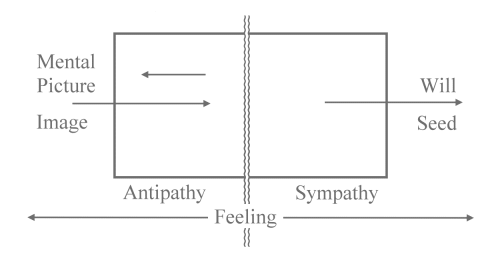 We develop within us all the world of feeling, which is a continual alternation—systole, diastole—between sympathy and antipathy. This alternation is continually within us. Antipathy on the one hand changes our soul life into picture image: sympathy, which goes in the other direction, changes our soul life into what we know as our will for action, into that which holds in germ what after death is spiritual reality. Here we come to the real understanding of the life of soul and spirit. We create the seed of the soul life as a rhythm of sympathy and antipathy. Now what is it that you ray back in antipathy. You ray back the whole life, the whole world, which you have experienced before birth or conception. That has in the main the character of cognition. Thus you really owe your cognition to the shining in, the raying in of your pre-natal life. And this cognising, which possesses great reality before birth or conception, is weakened to such a degree through antipathy that it becomes only a picture image. Thus we can say: this cognising comes up against antipathy and is thereby reduced to mental picture. If antipathy is sufficiently strong something very remarkable happens. For in ordinary life after birth we could not picture mentally if we did not do it in a measure with the very force which has remained in us from the time before birth. When you use this faculty to-day as physical man you do not do it with a force which is in you, but with a force which comes from a time before birth, and which still works on in you. You might suppose it ceased with conception, but it remains active, and we make our mental pictures with this force which continues to ray into us. You have it in you, continually living on from pre-natal times, only you have the force in you to ray it back. You have this force in your antipathy. When in your present life you make mental pictures, each such process meets antipathy, and if the antipathy is sufficiently strong a memory image arises. So that memory is nothing else but a result of the antipathy that holds sway within us. Here you have the connection between the purely feeling nature of antipathy which rays back in an indefinite manner, and the definite raying back, the raying back of the activity of perception in memory, an activity which is carried out in a pictorial way. Memory is only heightened antipathy. You could have no memory if you had so great a sympathy for your mental pictures that you could devour them; you have a memory only because you have a kind of “disgust” for them, you fling them back and in this way make them present. That is their reality. When you have gone through this whole process, when you have produced a mental picture, reflected this back in the memory, and held fast the image element, then there arises the concept. This then is one side of the soul's activity: antipathy, which is connected with our pre-natal life. Now we will take the other side, that of willing, which is in the nature of a germ in us and belongs to the life after death. Willing is present in us because we have sympathy with it, because we have sympathy with this seed which will not be developed until after death. Just as our thinking depends upon antipathy, so our willing depends on sympathy. Now if this sympathy is sufficiently strong—as strong as the antipathy which enables mental picturing to become memory—then out of sympathy there arises imagination. Just as memory arises out of antipathy so imagination arises out of sympathy. And if your imagination is sufficiently strong (which only happens unconsciously in ordinary life), if it is so strong that it permeates your whole being right down into the senses, then you get the ordinary picture forms* through which you make mental pictures of outer things. This activity has its starting point in the will. People are very much mistaken when in speaking psychologically they constantly say: “We look at things, then we make them abstract, and thus we get the mental picture.” This is not the case. The fact that chalk is white to us is a result of the application of the will, which by way of sympathy and imagination has become picture form.1 But when we form a concept, on the other hand, it has quite a different origin; for the concept arises from memory. Here I have described to you the soul processes. It is impossible for you to comprehend the being of man unless you understand the difference between the elements of sympathy and antipathy in man. These elements, as I have described, find their full expression in the soul world after death. There sympathy and antipathy hold sway undisguised. I have been describing the soul-man who, on the physical plane, is united with the bodily man. Everything pertaining to the soul is expressed and revealed in the body, so that on the one hand we find revealed in the body what is expressed in antipathy, memory and concept. All this is bound up with the nerves in the bodily organisation. While the nervous system is being formed in the body all that belongs to the pre-natal life is at work there. The pre-natal life of the soul works into the human body through antipathy, memory and concept, and hereby creates the nerves. This is the true concept of nerves. All talk of classifying nerves as sensory and motor is meaningless, as I have often explained to you. Similarly, in a certain sense, the activity of willing, sympathy, picture-forming and imagination works out of the human being. This is bound to the seed condition; it can never really come to completion but must perish at the moment it arises; it has to remain as a seed, and the seed must not evolve too far. Thus it must perish in the moment of arising. Here we come to a very important fact about the human being. You must learn to understand the whole man, spirit, soul and body. Now in man there is something continually being formed which always has the tendency to become spiritual. But because out of our great love, albeit selfish love, we want to hold it fast in the body, it never can become spiritual; it loses itself in its bodily nature. We have something within us which is material but which is always wanting to pass over from its material condition and become spiritual. We do not let it become spiritual, and therefore we destroy it in the very moment when it is striving to become spiritual—I refer to blood, the opposite of the nerves. 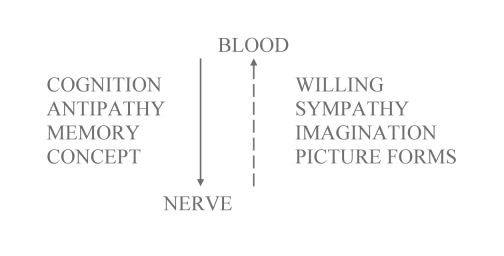 Blood is really a “very special fluid.” For it is the fluid which would whirl away as spirit if we were able to remove it from the human body so that it still remained blood and was not destroyed by other physical agencies—an impossibility while it is bound to earthly conditions. Blood has to be destroyed in order that it may not whirl away as spirit, in order that we may retain it within us as long as we are on the earth, up to the moment of death. For this reason we have perpetually within us: formation of blood—destruction of blood—formation of blood—destruction of blood: through in-breathing and out-breathing. We have a polaric process within us. We have those processes within us which, working through the blood and blood-vessels, continually have the tendency to lead our being out into the spiritual. To talk of motor nerves, as has become customary, does not correspond to the facts, because the motor-nerves would really be blood-vessels. In contrast to the blood all nerves are so constituted that they are constantly in the process of dying, of becoming materialised. What lies along the nerve-paths is really extruded, rejected material. Blood wants to become ever more spiritual—nerve ever more material. Herein consists the polaric contrast. In the later lectures we shall follow these fundamental principles further and we shall see how this can give us help to arrange our teaching in a hygienic way, so that we can lead a child to health of soul and body, and not to decadence of spirit and soul. The amount of bad education now prevalent is because so much is unknown. Although physiology believes it has discovered a truth when it talks of sensory and motor nerves, it is nevertheless only playing with words. Motor nerves are spoken of because of the fact that when certain nerves are injured, i.e. those which go to the legs, a man cannot walk when he wants to do so. It is said that he cannot walk because he has injured the nerves which, as motor nerves, set the leg in motion. In reality the reason why he cannot walk is that he has no perception of his own legs. This age in which we live has been obliged to entangle itself in a mass of errors, so that, through having to disentangle ourselves from them, we may become independent human beings. Now you will have seen, from what I have here developed, that really the human being can only be understood in connection with the cosmos. For when we make mental pictures we have what is cosmic within us. We were in the cosmos before we were born, and our experience there is now mirrored in us; we shall be in the cosmos again when we have passed through the gate of death, and our future life is expressed in seed form in what rules our will. What works unconsciously in us works in full consciousness for higher knowledge in the cosmos. We have a threefold expression of this sympathy and antipathy revealed in our physical body. We have, as it were, three centres where sympathy and antipathy interplay. First we have a centre of this kind in the head, in the working together of blood and nerves, whereby memory arises. At every point where the activity of the nerves is broken off, at every point where there is a gap, there is a centre where sympathy and antipathy interplay. Another gap of this kind is to be found in the spinal marrow; for instance, when one nerve passes in towards the posterior horn of the spinal marrow and another passes out from the anterior horn. And again there is such a gap in the little bundles of ganglia, which are embedded in the sympathetic nerves. We are by no means such simple beings as it might seem. In three parts of our organism, in the head, in the chest and in the lower body, there are boundaries at which antipathy and sympathy meet. In perceiving and willing it is not that something leads round from a sensory to a motor nerve, but a direct stream springs over from one nerve to another, and through this the soul in us is touched; in the brain and in the spinal marrow. At these places where the nerves are interrupted we unite ourselves with our sympathy and antipathy to the soul-life; and we do so again where the ganglia systems are developed in the sympathetic nervous system. We are united with our experience with the cosmos. Just as we develop activities which have to be continued in the cosmos, so does the cosmos constantly develop with us the activity of antipathy and sympathy. When we look upon ourselves as men, then we see ourselves as the result of the sympathies and the antipathies of the cosmos. We develop antipathy from out of ourselves, the cosmos develops antipathy together with us; we develop sympathy, the cosmos develops sympathy with us. Now as human beings we are manifestly divided into the head system, the chest system, and the digestive system with the limbs. But please notice that this division into organised systems can very easily be combated, because when men make systems to-day they want to have the separate parts neatly arranged side by side. If we say that a man is divided into a head system, chest system, and a system of the lower body with the limbs, then people expect each of these systems to have a fixed boundary. People want to draw lines where they divide, and that cannot be done when dealing with realities. In the head we are principally head, but the whole human being is head, only what is outside the head is not principally head. For though the actual sense organs are in the head, we have the sense of touch and the sense of warmth over the whole body. Thus in that we feel warmth we are head all over. In the head only are we principally head, but we are secondarily head in the rest of the body. Thus the parts are intermingled, and we are not so simply divided as the pedants would have us be. The head extends everywhere, only it is specially developed in the head proper. The same is true of the chest. Chest is the real chest but only principally, for again the whole man is chest. For the head is also to some extent chest as is the lower body with the limbs. The different parts are intermingled. And it is just the same in the lower body. Some physiologists have noticed that the head is “lower body.” For the very fine development of the head-nerve system does not really lie within the outer brain layer of which we are so proud; it does not lie within but below the outer layer of the brain. For the outer covering of the brain is, to some extent, a retrogression; this wonderful artistic structure is already on the retrograde path; it is much more a system of nourishment. So that in a manner of speaking, we may say a man has no need to be so conceited about the outer brain for it is a retrogression of the complicated brain into a brain more used for nourishment. We have the outer layer so that the nerves which are connected with knowing may be properly supplied with nourishment. And the reason that our brain excels the animal brain is only that we supply our brain nerves better with nourishment. We are only able to develop our higher powers of cognition because we are able to nourish our brain nerves better than the animals are able to do. Actually the brain and the nervous system have nothing to do with real cognition but only with the expression of cognition in the physical organism. Now the question is: why have we the contrast between the head system (we will leave the middle system out of account for the present) and the polaric limb system with the lower body? We have this contrast because at a certain moment the head system is breathed out by the cosmos. Man has the form of his head by reason of the antipathy of the cosmos. When the cosmos has such aversion for what man bears within him that it pushes it out, then the image or copy arises. In the head man really bears the copy of the cosmos in him. The roundly formed head is such a copy. The cosmos, through antipathy, creates a copy of itself outside itself. That is our head. We can use our head as an organ for freedom because it has been pushed out by the cosmos. We do not regard the head correctly if we think of it as incorporated in the cosmos as intensively as is our limb-masses system, in which are included the sexual organs. Our limb system is incorporated in the cosmos and the cosmos attracts it, has sympathy with it, just as it has antipathy towards the head. In the head our antipathy meets the antipathy of the cosmos; there they come into collision. And in the rebounding of our antipathies upon those of the cosmos our perceptions arise. All inner life which rises on the other side of man's being has its origin in the loving sympathetic embrace between the cosmos and the limb system of man. Thus the human bodily form expresses how a man, even in his soul nature, is formed out of the cosmos, and also what he then takes from the cosmos. If you look at it from this point of view you will more easily see that there is a great difference between the formation of the mental picture and the formation of will. If you work exclusively and one-sidedly on the building up of the former, then you really point the child back to his pre-natal existence, and you will harm him if you are educating him rationalistically, because you are coercing his will into what he has already done with—the pre-natal life. You must not introduce too many abstract concepts into what you bring to the child. You must rather introduce imaginative pictures. Why is this? Imaginative pictures stem from picture-forming and sympathy. Concepts, abstract concepts, are abstractions; they go through memory and antipathy, and they stem from the pre-natal life. If you use many abstractions in teaching a child, you involve him too intensely in the production of carbonic acid in the blood, namely in processes of the hardening of the body, and decay. If you bring to the child as many imaginations as possible, if you educate him as much as possible by speaking to him in images, then you are actually laying in the child the germ for the preservation of oxygen, for continuous growth, because you point to the future, to what comes after death. In educating we take up again in some measure the activities which were carried out with us men before birth. We must realise that mental picturing is an activity connected with images, originating in what we have experienced before birth or conception. The spiritual Powers have so dealt with us that they have planted within us this image activity which works on in us after birth, If in our education we ourselves give the children images we are taking up this cosmic activity again. We plant images in them which can become germs, seeds, because we plant them into a bodily activity. Therefore, whilst as educators we acquire the power to work in images we must continually have the feeling: you are working on the whole man; it echoes, as it were, through the whole human being, if you work in images. If you yourselves continually feel that in all education you are supplying a kind of continuation of pre-natal super-sensible activity, then you will give to all your education the necessary consecration, for without this consecration it is impossible to educate at all. To-day we have learnt of two systems of concepts: cognition, antipathy, memory, concept: willing, sympathy, picture-forming, imagination: two systems which we shall be able to apply practically in all that we have to do in our educational work. We will speak further of this tomorrow.
|
| 293. The Study of Man: Lecture III
23 Aug 1919, Stuttgart Translated by Daphne Harwood, Helen Fox Rudolf Steiner |
|---|
| The teacher of the present day should have a comprehensive view of the laws of the universe as a background to all he undertakes in his school work. And clearly, it is particularly in the lower classes, in the lower school grades, that education demands a connection in the teacher's soul with the highest ideas of humanity. |
| But as modern philosophy will have nothing to do with the elements through which alone the human being can be fully comprehended, it produces this law of the conservation of energy; a law which, in a sense, does no harm when applied to the other kingdoms of nature, to the mineral, plant and animal kingdoms—but which applied to man destroys all possibility of a true understanding and knowledge. As teachers it will be necessary for you on the one hand to give your pupils an understanding of nature, and on the other hand to lead them to a certain comprehension of spiritual life. |
| Of course certain circles of people to-day would find it exceedingly hard to understand such a thought. But unless we permeate ourselves with such conceptions we cannot possibly become true educators. |
| 293. The Study of Man: Lecture III
23 Aug 1919, Stuttgart Translated by Daphne Harwood, Helen Fox Rudolf Steiner |
|---|
The teacher of the present day should have a comprehensive view of the laws of the universe as a background to all he undertakes in his school work. And clearly, it is particularly in the lower classes, in the lower school grades, that education demands a connection in the teacher's soul with the highest ideas of humanity. A real canker in school constitution of recent years has been the habit of keeping the teacher of younger classes in a kind of dependent position, in a position which has made his existence seem of less value than that of teachers in the upper school. Naturally this is not the place for me to speak in general of the spiritual branch of the social organism. But I must point out that in future everything in the sphere of teaching must be on an equal footing; and public opinion will have to recognise that the teacher of the lower grades, both spiritually and in other ways, has the same intrinsic value as the teacher of the upper grades. It will not surprise you, therefore, if we point out to-day in the background of all teaching—with younger children as with older—there must be something that one cannot of course use directly in one's work with the children, but which it is essential that the teacher should know if his teaching is to be fruitful. In our teaching we bring to the child the world of nature on the one hand and the world of the spirit on the other. In so far as we are human beings on the earth, on the physical plane, fulfilling our existence between birth and death, we are intimately connected with the natural world on the one hand and the spiritual world on the other hand. Now the psychological science of our time is a very weak growth. It is still suffering from the after-effects of that dogmatic Church pronouncement of A.D. 869—to which I have often alluded—a decree which obscured an earlier vision resting on instinctive knowledge: the insight that man is divided into body, soul and spirit. When you hear psychologists speak to-day you will nearly always find that they speak only of the twofold nature of man. You will hear it said that man consists of matter and soul, or of body and spirit, however it may be put. Thus matter and body, and equally soul and spirit, are regarded as meaning much the same thing.1 Nearly all psychologies are built up on this erroneous conception of the twofold division of the human being. It is impossible to come to a real insight into human nature if one adopts this twofold division alone. It is for this fundamental reason that nearly everything that is put forward to-day as psychology is only dilettantism, a mere playing with words. This is chiefly due to that error, which reached its full magnitude only in the second half of the nineteenth century, and which arose from a misconception of a really great achievement of physical science. You know that the good people of Heilbronn have erected a memorial in the middle of their city to the man they shut up in an asylum during his life: Julius Robert Mayer. And you know that this personality, of whom the Heilbronn people are to-day naturally extremely proud, is associated with what is called the law of the Conservation of Energy or Force. This law states that the sum of all energies or forces present in the universe is constant, only that these forces undergo certain changes, and appear, now as heat, now as mechanical force, or the like. This is the form in which the law of Julius Robert Mayer is presented, because it is completely misunderstood. For he was really concerned with the discovery of the metamorphosis of forces, and not with the exposition of such an abstract law as that of the conservation of energy. Now, considered broadly and from the point of view of the history of civilisation, what is this law of the conservation of energy or force? It is the great stumbling-block to any understanding of man. For as soon as people think that forces can never be created afresh, it becomes impossible to arrive at a knowledge of the true being of man. For the true nature of man rests on the fact that through him new forces are continually coming into existence. It is certainly true that, under the conditions in which we are living in the world, man is the only being in whom new forces and even—as we shall hear later—new matter is being formed. But as modern philosophy will have nothing to do with the elements through which alone the human being can be fully comprehended, it produces this law of the conservation of energy; a law which, in a sense, does no harm when applied to the other kingdoms of nature, to the mineral, plant and animal kingdoms—but which applied to man destroys all possibility of a true understanding and knowledge. As teachers it will be necessary for you on the one hand to give your pupils an understanding of nature, and on the other hand to lead them to a certain comprehension of spiritual life. Without a knowledge of nature in some degree, and without some relation to spiritual life, man cannot take his place in social life. Let us therefore first of all turn our attention to external nature. Outer nature presents itself to us in two ways. On the one side, we confront nature in our thought life which as you know is of an image character and is a kind of reflection of our pre-natal life. On the other side we come into touch with that nature which may be called will-nature, which, as germ, points to our life after death. In this way we are continuously involved with nature. This might of course appear to be a two fold relationship between man and the world, and it has in point of fact given rise to the error of the twofold nature of man. We shall return to this subject later. When we confront the world from the side of thinking and of the mental picture, then we can really only comprehend that part of the world which is perpetually dying. This is a law of extraordinary importance. You must be very clear on this point: you may come across the most marvellous natural laws, but if they have been discovered by means of the intellect and the powers of the mental picture, then they will always refer to what is in process of dying in external nature. When, however, the living will, present in man as germ, is turned to the external world, it experiences laws very different from those connected with death. Hence those of you, who still retain conceptions which have sprung from the modern age and the errors of present-day science, will find something difficult to understand. What brings us into contact with the external world through the senses—including the whole range of the twelve senses—has not the nature of cognition, but rather of will. A man of to-day has lost all perception of this. He therefore considers it childish when he reads in Plato that actually sight comes about by the stretching forth of a kind of prehensile pair of arms from the eyes to the objects. These prehensile arms cannot of course be perceived by means of the senses; but that Plato was conscious of them is proof that he had penetrated into the super-sensible world. Actually, looking at things involves the same process as taking hold of things, only it is more delicate. For example, when you take hold of a piece of chalk this is a physical process exactly like the spiritual process that takes place when you send the etheric forces from your eyes to grasp an object in the act of sight. If people of the present day had any power of observation, they would be able to deduce these facts from observing natural phenomena. If, for example, you look at a horse's eyes, which are directed outwards, you will get the feeling that the horse, simply through the position of his eyes, has a different attitude to his environment from the human being. I can show you the causes of this most clearly by the following hypothesis: imagine that your two arms were so constituted that it was quite impossible for you to bring them together in front, so that you could never take hold of yourself. Suppose you had to remain in the position of “Ah” in Eurythmy and could never come to “0,” that, through some resisting force, it were impossible for you by stretching your arms forward to bring them together in front. Now the horse is in this situation with respect to the super-sensible arms of his eyes: the arm of his right eye can never touch the arm of his left eye. But the position of man's eyes is such that he can continually make these two super-sensible arms of his eyes touch one another. This is the basis of our sensation of the Ego, the I—a super-sensible sensation. If we had no possibility at all of bringing left and right into contact; or if the touching of left and right meant as little as it does with animals, who never rightly join their fore-feet, in prayer for instance, or in any similar spiritual exercise—if this were the case we should not be able to attain this spiritualised sensation of our own self. What is of paramount importance in the sensations of eye and ear is not so much the passive element, it is the activity, i.e. how we meet the outside world in our will. Modern philosophy has often had an inkling of some truth, and has then invented all kinds of words, which, however, usually show how far one is from a real comprehension of the matter. For example, the Localzeichen of Lotze's philosophy exhibit a trace of this knowledge that the will is active in the senses. But our lower sense organism, which clearly shows its connection with the metabolic system in the senses of touch, taste and smell, is indeed closely bound up with the metabolic system right into the higher senses—and the metabolic system is of a will nature. You can therefore say: man confronts nature with his intellectual faculties and through their means he grasps all that is dead in Nature, and he acquires laws concerning what is dead. But what rises in Nature from the womb of death to become the future of the world, this is comprehended by man's will—that will which is seemingly so indeterminate, but which extends right into the senses themselves. Think how living your relationship to Nature will become if you keep clearly in view what I have just said. For then you will say to yourselves: when I go out into Nature I have the play of light and colour continually before me; in assimilating the light and its colours I am uniting myself with that part of Nature which is being carried on into the future; and when I return to my room and think over what I have seen in Nature, and spin laws about it, then I am concerning myself with that element in the world which is perpetually dying. In Nature dying and becoming are continuously flowing into one another. We are able to comprehend the dying element because we bear within us the reflection of our prenatal life, the world of intellect, the world of thought, whereby we can see in our mind's eye the elements of death at the basis of Nature. And we are able to grasp what will come of Nature in the future because we confront Nature, not only with our intellect and thought, but with that which is of a will-nature within ourselves. Were it not that, during his earthly life, man could preserve some part of what before his birth became purely thought life, he would never be able to achieve freedom. For, in that case, man would be bound up with what is dead, and the moment he wanted to call into free activity what in himself is related to the dead element in Nature, he would be wanting to call into free activity a dying thing. And if he wished to make use of what unites him with Nature as a being of will, his consciousness would be deadened, for what unites him as a will being with Nature is still in germ. He would be a Nature being, but not a free being. Over and above these two elements—the comprehension of what is dead through the intellect, and the comprehension of what is living and becoming through the will—there dwells something in man which he alone and no other earthly being bears within him from birth to death, and that is pure thinking; that kind of thinking which is not directed to external nature, but is solely directed to the super-sensible nature in man himself, to that which makes him an autonomous being, something over and above what lives in the “less than death” and “more than life.” When speaking of human freedom therefore, one has to pay attention to this autonomous thing in man, this pure sense-free thinking in which the will too is always present. Now when you turn to consider Nature itself from this point of view you will say: I am looking out upon the world, the stream of dying is in me, and also the stream of renewing: dying—being born again. Modern science understands but little of this process; for it regards the external world as more or less of a unity, and continually muddles up dying and becoming. So that the many statements about Nature and its essence which are common to-day are entirely confused, because dying and becoming are mixed up and confounded with one another. In order clearly to differentiate between these two streams in Nature the question must be asked: how would it be with the world if man himself were not within it? This question presents a great dilemma for the philosophy of modern science. For, suppose you were to ask a truly modern research scientist: what would Nature be like if man were not within it? Of course he might at first be rather shocked, for the question would seem to be to him a strange one. Then, however, he would consider what grounds his science gives for answering such a question, and he would say: in this case, minerals, plants and animals would be on the earth, only man would not be there; and the course of the earth right through from the beginning, when it was still in the nebulous condition described by Kant and Laplace, would have been the same as it has been, only that man would not have been present in this progress. Practically speaking this is the only answer that could result. He might perhaps add: man tills the ground and so alters the surface of the earth, or he constructs machines and thereby also brings about certain alterations; but these are immaterial in comparison with the changes that are caused by Nature itself. In any case the gist of the scientist's answer would be that minerals, plants and animals would develop without man being present on the earth. This is not correct. For if man were not present in the earth's evolution then the animals, for the most part, would not be there either; for a great many animals, and particularly the higher animals, have only arisen in the earth's evolution because man was obliged—figuratively speaking, of course—to use his elbows. The nature of man formerly contained many things which are not there now, and at a certain stage of his earthly development he had to separate out from himself the higher animals, to throw them off, as it were, so that he himself could progress. I will make a comparison to describe this throwing out: imagine a solution where something is being dissolved, and then imagine that this dissolved substance is separated out and falls to the bottom as sediment. In the same way man was united with the animal world in earlier conditions of his development and later he separated out the animal world like a precipitate, or sediment. The animals would not have become what they are to-day if man had not had to develop as he has done. Thus without man in the earth evolution the animal forms as well as the earth itself would have looked quite other than they do to-day. But let us pass on to consider the mineral and plant world. Here we must be clear that not only the lower animal forms but also the plant and mineral kingdoms would long ago have dried up and ceased to develop if man were not upon the earth. And, again, present-day philosophy, based as it is on a one-sided view of the natural world, is bound to say: certainly men die, and their bodies are burned or buried, and thereby are given over to the earth, but this is of no significance for the development of the earth; for if the earth did not receive human bodies into itself it would take its course in precisely the same way as now, when it does receive these bodies. But this means that men are quite unaware that the continuous giving over of human corpses to the earth—whether by cremation or burial—is a real process which works on in the earth. Peasant women in the country know much better than town women that yeast plays an important part in bread making, although only a little is added to the bread; they know that the bread could not rise unless yeast were added to the dough. In the same way the earth would long ago have reached the final stage of its development if there had not been continuously added to it the forces of the human corpse, which is separated in death from what is of soul and spirit. Through the forces present in human corpses which are thus received by the earth, the evolution of the earth itself is maintained. It is owing to this that the minerals can still go on producing their powers of crystallisation, a thing they would otherwise long ago have ceased to do; without these forces they would long ago have crumbled away or dissolved. Plants, also, which would long ago have ceased to grow are enabled, thanks to these forces, to go on growing to-day. And it is the same with the lower animals forms. In giving his body over to the earth the human being is giving the ferment, the yeast for future—development. Hence it is by no means a matter of indifference whether man is living on the earth or not. It is simply untrue that the evolution of the earth with respect to its mineral, plant and animal kingdoms, would continue if man himself were not there. The process of Nature is a unified whole to which man belongs. We only get a true picture of man if we think of him as standing even in death in the midst of the cosmic process. If you will bear this in mind then you will hardly wonder at what I am now going to say: when man descends from the spiritual into the physical world he receives his physical body as a garment. But naturally the body received as a child differs from the body as we lay it aside in death, at whatever age. Something has happened to the physical body. And what has happened could only come about because this body is permeated with forces of spirit and soul. For, after all, we eat what animals also eat. That is to say, we transform external matter just as the animals do; but we transform it with the help of something which animals have not got; something that came down from the spiritual world in order to unite itself with the physical body of man. Because of this we affect the substances in a different way than do animals or plants. And the substances given over to the earth in the human corpse are transformed substances, something different from what man received when he was born. We can therefore say: man receives certain substances and forces at birth; he renews them during his life and gives them up again to the earth process in a different form. The substances and forces which he gives up to the earth process at death are not the same as those which he received at birth. In giving them up he is bestowing upon the earth process something which continuously streams through him from the super-sensible world into the physical, sense-perceptible, earth process. At birth he brings down something from the super-sensible world; this he incorporates with the substances and forces which make up his body during his earthly life, and then at death the earth receives it. Man is thus the medium for a constant be-dewing of the physical sense world by the super-sensible. You can imagine, as it were, a fine rain falling continuously from the super-sensible on to the sense world; but these drops would remain quite unfruitful for the earth if man did not absorb them and pass them over to the earth through his own body. These drops which man receives at birth and gives up again at death, bring about a continual fructification of the earth by super-sensible forces; and through these fructifying super-sensible forces the evolutionary process of the earth is maintained. Without human corpses therefore, the earth would long ago have become dead. With this presupposition we can now ask: what do the death forces do to human nature? The death-bringing forces which predominate in outer nature work into the nature of man; for if man were not continually bringing life to outer nature it would perish. Now how do these death-bringing forces work in the nature of man? They produce in man all those organisations which range from the bone system to the nerve system. What builds up the bones and everything related to them is of quite a different nature from what builds up the other systems. The death-bringing forces play into us. We leave them as they are, and thereby we become bone men. But the death-bringing forces play further into us and we tone them down, and thereby we become nerve men. What is a nerve? A nerve is something which is continually wanting to become bone, and is only prevented from becoming bone by being in a certain relationship to the non-bony, or non-nervous elements of human nature. Nerve has a constant tendency to ossify, it is constantly compelled towards decay; while bone in man is dead to a very large extent. With animal bones the conditions are different—animal bone is far more living than human bone. Thus you can picture one side of human nature by saying: the death-bringing stream works in the bone and nerve system. That is the one pole. The other stream, that of forces continuously giving life, works in the muscle and blood system and in all that is connected with it. The only reason why nerves are not bones is that their connection with the blood and muscle system is such that the impulse in them to become bone is directly opposed by the forces working in the blood and muscle. The nerve does not become bone solely because the blood and muscle system stands over against it and hinders it from becoming bone. If during the process of growth bone develops a wrong relationship to blood and muscle, then the condition of rickets will result, which is due to the muscle and blood nature hindering a proper deadening of the bone. It is therefore of the utmost importance that the right alternation should come about in man between the muscle and blood system on the one hand and the bone and nerve system on the other. The bone nerve system extends into the eye, but in the outer covering the bone system withdraws, and sends into the eye only its weakened form, the nerve; this enables the eye to unite the will nature, which lives in muscles and blood, with the activity of mental picturing. Here again we come upon something which played an important role in ancient science, but which is scorned as a childish conception by the science of to-day. But modern science will come back to it again, only in another form. In the knowledge of ancient times men always felt a relationship between the nerve marrow, the nerve substance, and the bone marrow, the bone substance. And they were of the opinion that man thinks with his bone nature just as much as with his nerve nature. And this is true. All that we have in abstract science we owe to the faculty of our bone system. How is it, for instance, that man can do geometry? The higher animals have no geometry; that can be seen from their way of life. It is pure nonsense when people say: “Perhaps the higher animals have a geometry, only we do not notice it.” Now, man can form a geometry. But how, for example, does he form the conception of a triangle? If one truly reflects on this matter, that man can form the conception of a triangle, it will seem a marvellous thing that man forms a triangle, an abstract triangle—nowhere to be found in concrete life—purely out of his geometrical, mathematical imagination. There is much that is hidden and unknown behind the manifest events of the world. Now imagine, for example, that you are standing at a definite place in this room. As a super-sensible human being you will, at certain times, perform strange movements about which as a rule you know nothing; like this, for example: you go a little way to one side, then you go a little way backwards, then you come back to your place again. You are describing unawares in space a line which actually performs a triangular movement. Such movements are actually there, only you do not perceive them. 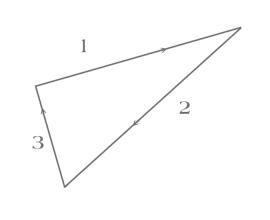 But since your backbone is in a vertical position, you are in the plane in which these movements take place. The animal is not in this plane, his backbone lies otherwise, i.e. horizontally; thus these movements are not carried out. Because man's backbone is vertical, he is in the plane where this movement is produced. He does not bring it to consciousness so that he could say: “I am always dancing in a triangle.” But he draws a triangle and says: “That is a triangle.” In reality this is a movement carried out unconsciously which he accomplishes in the cosmos. These movements to which you give fixed forms in geometry—when you draw geometrical figures, you perform in conjunction with the earth. The earth has not only the movement which belongs to the Copernican system; it has also quite—different, artistic movements, which are constantly being performed; as are also still more complicated movements, such as those, for example, which belong to the lines of geometrical solids: the cube, the octahedron, the dodecahedron, the icosatetrahedron and so forth. These bodies are not invented, they are reality, but unconscious reality. In these and other geometrical solids lies a remarkable harmony with the subconscious knowledge which man has. This is due to the fact that our bone system has an essential knowledge; but your consciousness does not reach down into the bone system. The consciousness of it dies, and it is only reflected back in the geometrical images which man carries out in figures. Man is an intrinsic part of the universe. In evolving geometry he is copying something that he himself does in the cosmos. Thus on the one hand we look into a world which encompasses ourselves and which is in a continuous process of dying. On the other hand we look into all that enters into the forces of our blood and muscle system; this is continuously in movement, in fluctuation, in becoming and arising: it is entirely seedlike, and has nothing dead within it. We arrest the death process within ourselves, and it is only we as human beings who can arrest it, and bring into this dying element a process of life, of becoming. If men were not here on the earth, death would long ago have spread over the whole earth process, and the earth as a whole would have been given over to crystallisation, though single crystals could not have maintained themselves. We draw the single crystals away from the general crystallisation process and preserve them, as long as we need them for our human evolution. And it is by doing so that we keep alive the being of the earth. Thus we human beings cannot be excluded from the life of the earth for it is we who keep the earth alive. Theodore Eduard von Hartmann hit on a true thought when, in his pessimism, he declared that one day mankind would be so mature that everybody would commit suicide; but what he further expected—viewing things as he did from the confines of natural science—would indeed be superfluous: for Hartmann it was not enough that all men should one day commit suicide, he expected in addition that an ingenious invention would blow the earth sky-high. Of this he would have no need. He need only have arranged the day for the general suicide and the earth would of itself have disintegrated slowly into the air. For without the force which is implanted into it by man, the evolution of the earth cannot endure. We must now permeate ourselves with this knowledge once again in a feeling way. It is necessary that these things be understood at the present time. Perhaps you remember that in my earliest writings there constantly recurs a thought through which I wanted to place knowledge on a different footing from that on which it stands to-day. In the external philosophy, which is derived from Anglo-American thought, man is reduced to being a mere spectator of the world. In his inner soul process he is a mere spectator of the world. If man were not here on earth—it is held—if he did not experience in his soul a reflection of what is going on in the world outside, everything would be just as it is. This holds good of natural science where it is a question of the development of events, such as I have described, but it also holds good for philosophy. The philosopher of to-day is quite content to be a spectator, that is, to be merely in the purely destructive element of cognition. I wished to rescue knowledge out of this destructive element. Therefore I have said again and again: man is not merely a spectator of the world: he is rather the world's stage upon which great cosmic events continuously play themselves out. I have repeatedly said that man, and the soul of man, is the stage upon which world events are played. This thought can also be expressed in a philosophic abstract form. And in particular, if you read the final chapter about spiritual activity in my book Truth and Science. you will find this thought strongly emphasised, namely: what takes place in man is not a matter of indifference to the rest of nature, but rather the rest of nature reaches into man and what takes place in man is simultaneously a cosmic process; so that the human soul is a stage upon which not merely a human process but a cosmic process is enacted. Of course certain circles of people to-day would find it exceedingly hard to understand such a thought. But unless we permeate ourselves with such conceptions we cannot possibly become true educators. Now what is it that actually happens within man's being? On the one hand we have the bone-nerve nature, on the other hand the blood-muscle nature. Through the co-operation of these two, substances and forces are constantly being formed anew. And it is because of this, because in man himself substances and forces are recreated, that the earth is preserved from death. What I have just said of the blood, namely that through its contact with the nerves it brings about re-creation of substances and forces—this you can now connect with what I said yesterday: that blood is perpetually on the way to becoming spiritual but is arrested on its way. To-morrow we shall link up the thoughts we have acquired in these two lectures and develop them further. But you can see already how erroneous the thought of the conservation of energy and matter really is, in the form in which it is usually put forward; for it is contradicted by what happens within human nature, and it is only an obstacle to the real comprehension of the human being. Only when we grasp the synthesizing thought, not indeed that something can proceed out of nothing, but that a thing can in reality be so transformed that it will pass away and another thing will arise, only when we substitute this thought for that of the conservation of energy and matter, will we attain something really fruitful for science. You see what the tendency is which leads so much of our thinking astray. We put forward something, as for example, the law of the conservation of force and matter, and we proclaim it a universal law. This is due to a certain tendency of our thought life, and especially of our soul life, to describe things in a one-sided way; whereas we should only set up postulates on the results of our mental picturing. For instance, in our books on physics you will find the law of the mutual impenetrability of bodies set up as an axiom: at that place in space where there is one body no other body can be at the same time. This is laid down as a universal quality of bodies. But one ought only to say: bodies and beings of such a nature that in the place where they are in space no other similar object can be at the same time are “impenetrable” bodies. You ought only to apply your concepts to differentiate one province from another. You ought only to set up postulates, and not to give definitions which claim to be universal. And so we should not lay down a “law” of the conservation of force and substance, but we should find out what beings this law applies to. It was a tendency of the nineteenth century to lay down laws and say: this holds good in every case. Instead of this we should devote our soul powers to acquainting ourselves with things, and observing our experiences in connection with them.
|
| 293. The Study of Man: Lecture IV
25 Aug 1919, Stuttgart Translated by Daphne Harwood, Helen Fox Rudolf Steiner |
|---|
| For when the human being develops motives, something is sounding quietly in the depths, and this gentle undertone must now be very, very carefully observed. I beg you to distinguish what I call this undertone very carefully from anything of a mental image, or conceptual nature. |
| The intention which a man has is the more important thing, not the repentance—the endeavour to do the same thing on another occasion. And in this intention wish sounds as an undertone; so that we may well ask the question: What is this undertone of wish which accompanies our intention? |
| Of course we must not make too much of such things. Much good may live underneath them. But they give a good impression of what the future has in store for the life of culture. |
| 293. The Study of Man: Lecture IV
25 Aug 1919, Stuttgart Translated by Daphne Harwood, Helen Fox Rudolf Steiner |
|---|
The education and teaching of the future will have to set particular value on the development of the will and the feeling nature. It is constantly being emphasised, even by those who have no thought of a new educational impulse, that special attention must be paid, in education, to the feeling nature and to the will. But with the best will in the world they can accomplish little in this sphere. Feeling and will are left more and more to what is called chance, because there is no insight into the real nature of will. By way of introduction I should like to say the following: it is not until the nature of the will is really known that it is possible to understand even a part of the other emotive powers, a part of the feelings. We can ask the question: what is a feeling in reality? A feeling is very closely related to will. I may even say that will is only the accomplished feeling, and feeling is will in reserve. Will which does not yet express itself, which remains behind in the soul, that is feeling: feeling is like blunted will. On this account the nature of feeling will not be understood until the nature of will has been thoroughly grasped. Now you will know from what I have already developed that nothing that lives in the will fully takes shape in the life between birth and death. Whenever a man makes a resolution with his will there is always something over, something which is not exhausted even up to his death; a remainder of every resolution and act of will lives on and continues beyond death. During the whole of life, and especially in the age of childhood, notice must be taken of this part of the will which remains. We know that when we observe man in his totality, we consider him as body, soul and spirit. The body, at least the main constituents of it, is born first. (You will find details about this in the book Theosophy. Thus the body is involved in the stream of inheritance and bears the inherited characteristics. The soul, in the main, is a principle which comes out of prenatal existence and unites itself with the body; it descends into the body. But the spiritual part of man to-day is only present in embryo—though in future this will be different. And now, when we want to lay the foundations for a good theory of education, we must pay heed to this embryonic form of the spirit in the man of this epoch in evolution. Let us first of all be quite clear as to what it is that exists in embryo for a far distant future of humanity. First there is, in embryonic form, what we call the Spirit-Self. We cannot include the Spirit-Self among the constituents or members of human nature when we are speaking of the present-day man; but there is a clear consciousness of the Spirit-Self in men who are able to see into the spiritual. You know that the whole oriental consciousness, in so far as it is educated consciousness, calls this Spirit-Self Manas, and that Manas is always spoken of in the oriental spiritual teaching as indwelling in man. But amongst western peoples too, even if they are not exactly “learned,” there is a clear consciousness of this Spirit-Self. And I say deliberately: that this clear consciousness exists; for amongst the people, at least before they had completely absorbed the materialistic point of view, that part of man which remains over after death was called the Manes: people said that after death there remains over, the Manes—Manas is the same as the Manes. I say that the people have a clear consciousness of this, for the people in this case use the plural, the Manes. We who from a scientific standpoint connect the Spirit-Self more with man before death, use the singular form, “the Spirit-Self.” The people who speak of the Spirit-Self more realistically from a naive knowledge use the plural number because at the moment in which a man passes through the gate of death, he is received by a plurality of spiritual beings. I have already pointed this out in another connection: we each have a spirit who leads us personally, belonging to the Hierarchy of the Angels; over them we have the spirits belonging to the Hierarchy of the Archangels, who enter into a man immediately he passes through the gate of death, so that he then exists in a certain way in the plural, because many archangels have entered into his being. The people feel this very clearly because they know that after death man perceives himself (to a greater or lesser degree) as a plurality, in contrast to his appearance in this life which is a unity. Thus the Manes live on in the naive folk consciousness as the plural aspect of the Spirit-Self, of Manas. A second higher principle of man is that which we call Life-Spirit. In the Life-Spirit we come to something which is less perceptible in present-day man. It is something of a very spiritual nature in man which will develop in the very distant future of humanity. And then there is the highest in man which at present is only in the very earliest embryonic stage, the real Spirit-Man. But although these three higher principles of human nature are only present in embryo in the earthly life of the man of to-day, yet, albeit under the guardianship of higher spiritual Beings, they develop in a very significant way between death and a new birth. Thus when man dies and enters again into the spiritual world, these three principles develop very markedly, pointing, in a measure, to a future existence of humanity. Thus just as a man in his present life develops in soul and spirit between birth and death, so after death he goes through definite development, only then he is attached, as it were by an umbilical cord to the spiritual beings of the higher Hierarchies. Let us now add to these scarcely perceptible higher members of man's nature others which we can already perceive. These express themselves in the three soul principles: the Consciousness soul, the Intellectual or Mind-soul, and the Sentient soul. These are the true soul constituents of man. If to-day we want to speak of the soul of man as it lives in the body, then we must speak of the three soul principles just mentioned. If we are speaking of his body, we speak, as you know, of the sentient body (which is the finest of all and is also called the astral body), the etheric body and the grosser physical body, which we see with our eye and which external science analyses. With these we have the whole man before us. Now you know that the physical body as we have it belongs also to the animals. It is only when we compare this whole man, according to these nine principles, with the animal world that we can arrive at a useful picture of the relation of man to the animals. I mean a mental picture which enters truly into the life of feeling and which the Will itself can apprehend. We must know that just as the soul of man is clothed with a physical body the animal also is clothed with a physical body, which, however, in many ways is formed differently from that of man. The physical body of man is not really more perfect than that of the animal. Think of some of the higher animals, the beaver, for instance, how he builds his dams. A man could not do this unless he had learned it, unless indeed he had gone through a very complicated training for the purpose, including the study of architecture and kindred subjects. The beaver makes his dam by means of the organisation of his body. He is so related to his environment that he uses the very forces which build up his own physical body in the construction of his dam. His physical body itself is, in this respect his teacher. We can observe the wasps and bees, also the so-called lower animals, and we shall find something inherent in the form of their physical bodies which is not in the physical body of man to the same degree of intensity. This is all that we include in the concept instinct; and we can only make a real study of instinct if we consider it in connection with the form of the physical body. If we study all the different species of animals as distributed in the world we shall find that the forms of their physical bodies always give us the clue to the study of the different kinds of instinct. When we want to study the will, we must first seek it in the sphere of instinct and we must be aware that we find instinct in the forms of the physical bodies of the various animals. If we were to look at the chief animal forms and were to draw them, we should then be able to draw the different spheres of instinct. The form of the physical body in the different animals is a picture of what the instinct is as will. You see that when we are able to apply this view of things it brings meaning into the world. We contemplate the animal bodies and see them as a picture drawn by Nature herself to express what existence holds. Now in our physical body, forming and permeating it throughout, there lives the etheric body. To the external senses it is super-sensible, invisible. But when we look at the will nature we find the following: just as the etheric body permeates the physical body so it also takes hold of what in the physical body manifests as instinct. And then instinct becomes impulse. In the physical body will is instinct: as soon as the etheric body dominates instinct, will becomes impulse*. (*German Trieb: another translation would be Drive, as used in some modern psychology). Now, when instinct—which one can understand more concretely in external form—is viewed as impulse, it is very interesting to observe how it becomes more inward, and also more of a unity. When speaking of instinct, either in animals or in its weaker form in man, we shall always regard it as something stamped upon the being from without: whereas impulse, more inward in its nature, also comes more from within, because the super-sensible etheric body transforms instinct into impulse. Now man has also the sentient body. That is of a still more inward nature. In its turn it takes hold of impulse, and then not only is this made more inward, but instinct and impulse are both lifted into consciousness, and in this way desire arises. You find desire also in the animal, as you find impulse, because the animal has also these three principles, physical body, etheric body and sentient body. But when you speak of desire you will quite instinctively regard it as something of a very inward nature. You describe impulse as a thing which manifests in a uniform manner from birth to old age; while in speaking of desire you speak of something which is created afresh by the soul every time. A desire is not necessarily something belonging to the character; it need not be attached to the soul, but it comes and goes. Thus we see that desire has more of the soul character than mere impulse. And now let us put the question which cannot apply to the animal: when man takes up into his ego—i.e. into his sentient soul, intellectual or mind-soul, and consciousness soul—the instinct, impulse and desire of the body what do they become? We do not distinguish so clearly here as we do within the body, because in the soul, particularly just now, everything is mixed up more or less. Psychologists of to-day are puzzled to know whether to keep the principles of the soul completely apart or let them intermingle. Some psychologists are haunted by the old, strict differentiation between will, feeling and thought; in others, e.g. in the more Herbartian psychologists, everything is directed more to the side of the mental picture, while in the followers of Wundt it goes more to the side of will. They have no true conception of how to deal with the membering of the soul. This is because in actual practical life the ego really permeates all the capacities of the soul, and in the present day human being the differentiation with regard to the three members of the soul does not appear clearly even in practice. Hence language has no words for differentiating the will nature in the soul—instinct, impulse, desire, when it is taken hold of by the ego. But instinct, impulse and desire in man when taken hold of by the ego we generally call motive, so that when we speak of the will impulse in the individual soul, in what belongs to the “I,” we are speaking of motive; and we realise that animals can have desires, but no motives. It is only man who can raise the level of desire by bringing it into the soul world, and hence comes the urge to conceive a motive inwardly. It is only in man that desires grow into a true motive of will. It is a description of the nature of will in man to-day to say: in man instinct, impulse and desire from the animal world still persist, but he raises them to motive. Anyone considering the will nature in man to-day will say: “If I know the man's motives, then I know the man.” But not quite! For when the human being develops motives, something is sounding quietly in the depths, and this gentle undertone must now be very, very carefully observed. I beg you to distinguish what I call this undertone very carefully from anything of a mental image, or conceptual nature. I do not now mean what is more of the nature of mental picture or idea in the will impulse. You can, e.g., have the following idea: something I wished to do, or did, was good; or you can have some other idea; but that is not what I mean. I mean something that can be faintly heard beneath the impulse of will, but which is still of the nature of will. There is something which always works in the will when we have motives; that is, the wish. I do not now mean the strongly developed wishes out of which the desires are formed, but an undercurrent of wishes that accompany all our motives. They are always present. We perceive this wishing particularly clearly when we carry out something which arises out of a motive in our will, and then we think it over and say to ourselves; what you did then you could do much better. But what is there we do in life, without a feeling that we could have done it better? It would be sad if we were completely contented with anything, for there is nothing which we could not do better still. And this is where we see the difference between a man who is somewhat more civilised and one who is not so advanced, for the latter always has the tendency to be satisfied with himself. The more advanced man never wants to be so thoroughly satisfied with himself because he has always in him the soft undertone of a wish to do better, even to do differently. There is much sinning in this domain. Men regard it as a tremendously noble thing to repent of a deed; but that is not the best that can be done with a deed; for often repentance is based upon sheer egoism: one would like to have done something better in order to be a better man. That is egoistic. Our efforts will only cease to be egoistic when we do not wish to have done a thing better than we have done it, but consider it far more important to do the same thing better next time. The intention which a man has is the more important thing, not the repentance—the endeavour to do the same thing on another occasion. And in this intention wish sounds as an undertone; so that we may well ask the question: What is this undertone of wish which accompanies our intention? For anyone who can really observe the soul this wish is the first element of all that remains over after death. It is something of this remainder which we feel when we say: we ought to have done it better: we wish we had done it better. In the wish, in the form in which I have described it to you, we have something which belongs to the Spirit-Self. Now the wish can become more concrete, it can take on a clearer form, Then it becomes similar to an intention. Then there is formed a kind of mental picture of how a thing would be done better if it had to be done again. I do not, however, lay the greatest stress on the mental picture, but on the feeling and the will elements which accompany each motive, the intention to do a thing better in a similar case. Here the so-called sub-conscious in man plays a prominent part. If in your ordinary consciousness to-day you perform an action out of your own will, you do not necessarily make an idea in your mind of how you will do it. But the other man living in you, the “second” man, he always forms—not indeed as a mental picture, but in the region of the will—a clear picture of how he would act if he were again in the same position. Be sure you do not undervalue such knowledge as this. Above all do not fail to appreciate this second man who lives in you. That so-called scientific line of thought which calls itself analytical psychology, “psycho-analysis,” talks a lot of nonsense about this “second man.” This psycho-analysis usually starts from the following classic example in setting forth its principles. I have already told you this story, but it is good to call it to mind again. It is as follows: A man gives an evening party at his house, and it is known that, immediately after the party is over, the lady of the house is going away to a Spa. There are at the party various people, among them a lady. The party is given. The lady of the house is taken to the train that she may travel to the Spa. The rest of the party leaves and with them the lady already mentioned. She, with the other members of the party, is overtaken at a crossroads by a carriage which, coming round a corner from another street, is not seen until it is quite close. What do the people coming from the party do? Of course they avoid the carriage by going right and left, with the exception of the lady. She runs as fast as she can in front of the horses down the middle of the street. The coachman does not stop and the rest of the party are terrified. But the lady runs so fast that the others cannot follow her, and she runs until she comes to a bridge. And even then it does not occur to her to get out of the way. She falls into the water, but she is saved and brought back to her late host's house. And there she is able to spend the night. You find this as an example in many works on psychoanalysis. But something in it is always falsely interpreted. For the question is: what was at the back of this whole incident? The will of the lady. What did she really want to do? She wanted to return to her host's house as soon as his wife had gone away, for she was in love with him. This, however, was not a conscious wish, but something which had its seat in the sub-conscious. And this sub-consciousness of the second man, within us, is often much more shrewd than a man is in his upper consciousness. So clever was the sub-conscious in this case that the lady arranged the whole proceeding up to the moment in which she fell into the water in order to be able to return to her host's house. In fact she saw prophetically that she would be saved. Psycho-analysis tries to get at these hidden soul forces, but it only speaks in general of a “second man.” But we are able to know that there does exist in every man what is at work in the subconscious soul forces, and that it often shows itself to be extraordinarily clever, much cleverer than the ordinary activity of the soul. In every man there dwells, underground, as it were, the “other” man. In this other man there lives also the “better” man, who always makes up his mind, when he has done a thing, to do it better next time, so that always, as an undertone to every deed, there is the intention, the unconscious, subconscious intention to do it better when a similar occasion arises. Not until the soul is freed from the body does this intention become a resolution. This intention remains like a seed in the soul, and the resolution follows later. The resolution has its seat in the Spirit-Man, the intention in the Life-Spirit and the pure wish in the Spirit-Self. When you then consider man as a being of Will you can find all these component parts in him: instinct, impulse, desire and motive, and then, playing in as a gentle accompaniment: wish, intention and resolution which are already living in Spirit-Self, Life-Spirit, and Spirit-Man This has a great significance in the development of the human being. For what is thus present under the surface, waiting for the time after death, is expressed in man in image form between birth and death. We describe it there in the same words. We experience wish, intention and resolution through our mental picturing. But we shall only experience wish, intention, resolution as they accord with true manhood when these things are developed and nurtured in the right manner. What wish, intention and resolution really are in deeper human nature, does not appear in the external man between birth and death. Images of them appear in the life of mental pictures. If you only develop ordinary consciousness you know nothing at all of what “wish” is. You have only an idea, a mental picture of a “wish.” Hence Herbart maintains that the very idea of a wish contains activity and effort. It is the same with intention; you have only a mental picture of it. You want to do something or other which involves a real activity in the depths of the soul, but you do not know what goes on in the depths. And now as to resolution, who knows anything about that? Ordinary psychology speaks only of a “general willing.” Yet the teacher and educator has to enter into all these three soul forces in order to guide and regulate them. To be a teacher and educator one must work with what is taking place in the depths of human nature. It is of the utmost importance that the teacher or educator should realise continually: it is not enough to base our teaching on ordinary life, it must come forth from an understanding of the inner man. Popular socialism is prone to this mistake of arranging education on the basis of everyday life. This is how the current Marxist socialism would like to establish the education of the future. In Russia this has already happened. In the Lunatscharsky school reform there is something terrible. It is the death of all culture. Many dreadful things have come out of Bolshevism, but the most dreadful of all is the Bolshevist method of education, which would entirely eradicate all that former ages have contributed to human culture. This will not be achieved in the first generation but will certainly be attained in following generations, with the result that all culture will soon vanish from the face of the earth. Some people must see this. You have heard in this very room people singing a song of praise to Bolshevism, who have not the faintest idea that through it the Devil has entered socialism. We must take great care that there are men who know that progress in the social sphere demands and depends upon more intimate understanding of the human being in the sphere of education. Hence it must be known that the educator and the teacher of the future must understand the innermost being of man, must live with this inner being and that the ordinary intercourse which takes place between adults cannot be applied to education. What do the ordinary Marxists want? They want to run the Schools socialistically; they want to do away with all authority and let the children educate themselves. Something dreadful would come out of this! We once visited a boarding-school and wanted to see one of the most important lessons, a religion lesson. When we entered the classroom one little ruffian was lying on the window-sill, kicking with his feet out of the window; another was lying on his stomach with his head outside, and all the pupils were behaving in similar fashion. The religion teacher entered and read a story by Gottfried Keller, which the children accompanied with all sorts of racket. Then, when the lesson came to an end, they went out to play. I had the impression that the boarding-school was nothing more than a stable for animals (the sleeping quarters were only a few paces away). Of course we must not make too much of such things. Much good may live underneath them. But they give a good impression of what the future has in store for the life of culture. What do we commonly find advocated? That children should have the same sort of relationship with each other as is usual among adults. But this is the most spurious thing that can be done in education. People must realise that a child has to develop quite different powers of soul and of body than those which adults use in their intercourse with each other. Thus education must be able to reach the depths of the soul; otherwise no progress will be made. Hence we must ask ourselves: what part of education, what part of teaching affects the will nature of man? Once and for all this problem must be faced. If you think of what was said yesterday you will remember that everything intellectual is will grown old, will in its old age. Thus all ordinary exhortation, anything in the form of a concept has no effect upon a child at the usual school age. Let us once more summarise what has been said, so that we may be clear on this point: feeling is will in the becoming, will that has not yet become; but the whole human being lives in the will, so that in a child too the subconscious resolutions must be reckoned with. But let us at all costs guard against believing that we can influence a child's will by all the things we have thought out so well—in our own opinion. We must ask ourselves how we can have a good influence on the feeling nature of the child. This we can only achieve by introducing actions which have to be constantly repeated. You direct the impulse of the will aright, not by telling a child once what the right thing is, but by getting him to do something to-day and tomorrow and again the day after. It is not the right thing to begin by exhorting the child and giving him rules of conduct: you must lead him to do something which you think will awaken his feeling for what is right, and get him to do it repeatedly. An action of this sort must be made into a habit. The more it becomes an unconscious habit, the better it is for the development of the feeling; the more conscious a child is of doing the action repeatedly, out of devotion, because it ought to be done, because it must be done, the more you are raising the deed to a real impulse of will. A more unconscious repetition cultivates feeling: fully conscious repetition cultivates the true will impulse, for it enhances the power of resolution, of determination. The power of determination, which is dormant in the sub-conscious, is spurred and aroused when you lead the child to repeat things consciously. In cultivating the will, therefore, we must not expect to do what is of importance in cultivating the intellect. Where the intellect is concerned we always consider that when an idea is given to a child, the better he “grasps” it, the better it is: the single presentation of the thing is of the greatest importance: after that it has to be retained, remembered. But a thing taught once and afterwards retained has no effect on feeling or will: rather the feeling and will are affected by what is done over and over again, and by what is seen to be the right thing to do because circumstances demand it. The earlier, more naive patriarchal forms of education achieved this in a naive patriarchal way: it simply became a habit of life. In all the things which were used in this way there is something of educational value. Why, for instance, should we use the Lord's Prayer every day? If a man nowadays were expected to read the same story daily, he simply would not do it; he would find it far too dull. The man of to-day is trained to do things once. But men of an earlier time not only said the same Lord's Prayer every day, they also had a book of stories which they read at least every week. And for this reason their wills were stronger than those produced by the present methods of education: for the cultivation of the will depends upon repetition and conscious repetition. This must be taken into consideration. And so it is not enough to say in the abstract that the will must be educated. For then people will believe that if they have good ideas themselves for the development of the will and apply them to the child by some clever methods, they will contribute something to the cultivation of the will. But in reality this is of no use whatever. Those who are exhorted to be good become only weak nervous men. Those become inwardly strong to whom it is said in childhood: “You do this to-day and you do that, and both of you do the same tomorrow and the day after.” And they do it merely on authority because they see that one in the school must command. Thus to assign to the child some kind of work for each day that he can do every day, sometimes even the whole year through, has a great effect upon the development of the will. In the first place it creates a contact amongst the pupils; then it also strengthens the authority of the teacher, and doing the same thing repeatedly works powerfully on the children's will. Why then has the artistic element such a special effect, as I have said already, on the development of the will? Because, in the first place, practice depends upon repetition; but secondly because what a child acquires artistically gives him fresh joy each time. The artistic is enjoyed every time, not only on the first occasion. Art has something in its nature which does not only stir a man once but gives him fresh joy repeatedly. Hence it is that what we have to do in education is intimately bound up with the artistic element. We will go further into this tomorrow. I wanted to show to-day that the education of the will must be brought about in a different way from the education of the intellect. |
| 293. The Study of Man: Lecture V
26 Aug 1919, Stuttgart Translated by Daphne Harwood, Helen Fox Rudolf Steiner |
|---|
| Thus actually we can only say that will activity is chiefly will activity and has an undercurrent of thought within it; and thought activity is chiefly thought activity and has an undercurrent of will. |
| This takes place in a comprehensive way if we bring ideals, moral ideals, into our mere instincts. And now you will understand better the true significance of antipathy in this connection. If the impulses that we notice in the little child were throughout our life to remain only sympathetic, as they are sympathetic in childhood, we should develop in an animal way under the influence of our instincts. |
| Anyone who has a real understanding for these things will see from a dispute of this kind that neither the psychologists nor the logicians have discovered the real facts of the case, namely that the soul activities are always flowing into one another. |
| 293. The Study of Man: Lecture V
26 Aug 1919, Stuttgart Translated by Daphne Harwood, Helen Fox Rudolf Steiner |
|---|
Yesterday we discussed the nature of will in so far as will is embodied in the human organ. Today we will use this knowledge of man's relationship to will to fructify our consideration of the rest of the human being. You will have noticed that in treating of the human being up to now I have chiefly drawn attention to the intellectual activity, the activity of cognition, on the one hand, and the activity of will on the other hand. I have shown you how the activity of cognition has a close connection with the nerve nature of the human being, and how the activity of will has a close connection with the activity of the blood. If you think this over you will also want to know what can be said with regard to the third soul power, that is, the activity of feeling. We have not yet given this much consideration, but today, by thinking more of the activity of feeling, we shall have the opportunity of entering more intensively into an understanding of the two other sides of human nature, namely cognition and will. Now there is one thing that we must be clear about, and this I have already mentioned in various connections. We cannot put the soul powers pedantically side by side, separate from each other, thus: thinking, feeling, willing, because in the living soul, in its entirety, one activity is always merging into another. Consider the will on the one hand. You will realise that you cannot bring your will to bear on anything that you do not represent to yourself as mental picture, that you do not permeate with the activity of cognition. Try in self-contemplation, even superficially, to concentrate on your willing, you will find that in every act of will the mental picture is present in some form. You could not be a human being at all if mental picturing were not involved in your acts of will. And your willing would proceed from a dull instinctive activity, if you did not permeate the action which springs forth from the will with the activity of thought, of mental picturing. Just as thought is present in every act of will, so will is to be found in all thinking. Again, even a purely superficial contemplation of your own self will show you that in thinking you always let your will stream into the formation of your thoughts. In the forming of your own thoughts, in the uniting of one thought with another, or passing over to judgments and conclusions—in all this there streams a delicate current of will. Thus actually we can only say that will activity is chiefly will activity and has an undercurrent of thought within it; and thought activity is chiefly thought activity and has an undercurrent of will. Thus, in considering the separate faculties of soul, it is impossible to place them side-by-side in a pedantic way, because one flows into the other. Now this flowing into one another of the soul activities, which is recognisable in the soul, is also to be seen in the body, where the soul activity comes to expression. For instance, let us look at the human eye. If we look at it in its totality we shall see that the nerves are continued right into the eye itself; but so also are the blood vessels. The presence of the nerves enables the activity of thought and cognition to stream into the eye of the human being; and the presence of the blood vessels enables the will activity to stream in. So also in the body as a whole, right into the periphery of the sense activities, the elements of will on the one hand and thought or cognition on the other hand are bound up with each other. This applies to all the senses and moreover it applies to the limbs, which serve the will: the element of cognition enters into our willing and into our movements through the nerves, and the element of will enters in through the blood vessels. But now we must also learn the special nature of the activities of cognition. We have already spoken of this, but we must be fully conscious of the whole complex belonging to this side of human activity, to thought and cognition. As we have already said, in cognition, in mental picturing lives antipathy. However strange it may seem, everything connected with mental picturing, with thought, is permeated with antipathy. You will probably say, “Yes, but when I look at something I am not exercising any antipathy in this looking.” But indeed you do exercise it. When you look at an object, you exercise antipathy. If nerve activity alone were present in your eye, everything you looked at would be an object of disgust to you, would be absolutely antipathetic to you. But the will, which is made up of sympathy, also pours its activity into the eye, that is, the blood in its physical form penetrates into the eye, and it is only by this means that the feeling of antipathy in sense-perception is overcome in your consciousness, and the objective, neutral act of sight is brought about by the balance between sympathy and antipathy. It is brought about by the fact that sympathy and antipathy balance one another, and by the fact also that we are quite unconscious of this interplay between sympathy and antipathy. If you take Goethe's Theory of Colour, to which I have already referred in this connection, and study especially the physiological-didactic part of it, you will see that it is because Goethe goes more deeply into the activity of sight that there immediately enters into his consideration of the finer shades of colour the elements of sympathy and antipathy. As soon as you begin to enter into the activity of a sense organ you discover the elements of sympathy and antipathy which arise in that activity. Thus in the sense activity itself the antipathetic element comes from the actual cognitive part, from mental picturing, the nerve part—and the sympathetic element comes from the will part, from the blood. As I have often pointed out in general anthroposophical lectures there is a very important difference between animals and man with regard to the constitution of the eye. It is a significant characteristic of the animal that it has much more blood activity in its eye than the human being. In certain animals you will even find organs which are given up to this blood activity, as for example the ensiform cartilage, or the “fan.” From this you can deduce that the animal sends much more blood activity into the eye than the human being, and this is also the case with the other senses. That is to say, in his senses the animal develops much more sympathy, instinctive sympathy with his environment than the human being does. The human being has in reality more antipathy to his environment than the animal only this antipathy does not come into consciousness in ordinary life. It only comes into consciousness when our perception of the external world is intensified to a degree of impression to which we react with disgust. This is only a heightened impression of all sense-perceptions; you react with disgust to the external impression. When you go to a place that has a bad smell and you feel disgust within the range of this smell, then this feeling of disgust is nothing more than an intensification of what takes place in every sense activity, only that the disgust which accompanies the feeling in the sense impression remains as a rule below the threshold of consciousness. But if we human beings had no more antipathy to our environment than the animal, we should not separate ourselves off so markedly from our environment as we actually do. The animal has much more sympathy with his environment, and has therefore grown together with it much more, and hence he is much more dependent on climate, seasons, etc., than the human being is. It is because man has much more antipathy to his environment than the animal has that he is a personality. We have our separate consciousness of personality because the antipathy which lies below the threshold of consciousness enables us to separate ourselves from our environment. Now this brings us to something which plays an important part in our comprehension of man. We have seen how in the activity of thought there flow together thinking (nerve activity as expressed in terms of the body) and willing (blood activity as expressed in terms of the body). But in the same way there flow together in actions of will the real will activity and the activity of thought. When we will to do something, we always develop sympathy for what we wish to do. But it would get no further than an instinctive willing unless we could bring antipathy also into willing, and thus separate ourselves as personalities from the action which we intend to perform. But the sympathy for what we plan to do is predominant, and a balance is only effected by the fact that we bring in antipathy also. Hence it comes about that the sympathy as such lies below the threshold of consciousness, and part of it only enters consciously into that which is willed. In all the numerous actions that we perform not merely out of our reason but with real enthusiasm, and with love and devotion, sympathy predominates so strongly in the will that it penetrates into the consciousness above the threshold, and our willing itself appears charged with sympathy, whereas as a rule it merely unites us with our environment in an objective way. Just as it is only in exceptional circumstances that our antipathy to the environment may become conscious in cognition, so our sympathy with the environment (which is always present) may only become conscious in exceptional circumstances, namely, when we act with enthusiasm and loving devotion. Otherwise we should perform all our actions instinctively. We should never be able to relate ourselves properly to the objective demands of the world, for example in social life. We must permeate our will with thinking, so that this will may make us members of all humanity and partakers in the world's process itself. Perhaps it will be clear to you what really happens if you think what chaos there would be in the human soul if we were perpetually conscious of all this that I have spoken of. For if this were the case man would be conscious of a considerable amount of antipathy accompanying all his actions. This would be terrible! Man would then pass through the world feeling himself continually in an atmosphere of antipathy. It is wisely ordered that this antipathy as a force is indeed essential to our actions, but that we should not be aware of it, that it should lie below the threshold of consciousness. Now in this connection we touch upon a wonderful mystery of human nature, a mystery which can be felt by any person of perception, but which the teacher and educator must bring to full consciousness. In early childhood we act more or less out of pure sympathy, however strange this may seem; all a child does, all its romping and play, it does out of sympathy with the deed, with the romping. When sympathy is born in the world it is strong love, strong willing. But it cannot remain in this condition, it must be permeated with thought, by idea, it must be continuously illumined as it were by the conscious mental picture. This takes place in a comprehensive way if we bring ideals, moral ideals, into our mere instincts. And now you will understand better the true significance of antipathy in this connection. If the impulses that we notice in the little child were throughout our life to remain only sympathetic, as they are sympathetic in childhood, we should develop in an animal way under the influence of our instincts. These instincts must become antipathetic to us; we must pour antipathy into them. When we pour antipathy into them we do it by means of our moral ideals, to which the instincts are antipathetic, and which for our life between birth and death bring antipathy into the childlike sympathy of instincts. For this reason moral development is always somewhat ascetic. But this asceticism must be rightly understood. It always betokens an exercise in the combating of the animal element. This can show us to what a great extent willing in man's practical activity is not merely willing but is also permeated with idea, with the activity of cognition, of mental picturing. Now between cognition or thinking on the one hand and willing on the other hand we find the human activity of feeling. If you picture to yourselves what I have now put forward as willing and as thinking, you can say: From a certain central boundary there stream forth on the one hand all that is sympathy, willing, and on the other hand all that is antipathy, thinking. But the sympathy of willing also works back into thinking, and the antipathy of thinking works over into willing. Thus man is a unity because what is developed principally on the one side plays over into the other. Now between the two, between thinking and willing, there lies feeling, and this feeling is related to thinking on the one hand and to willing on the other hand. In the soul as a whole you cannot keep thought and will strictly apart, and still less can you keep the thought and will elements apart in feeling. In feeling, the will and thought elements are very strongly intermingled. 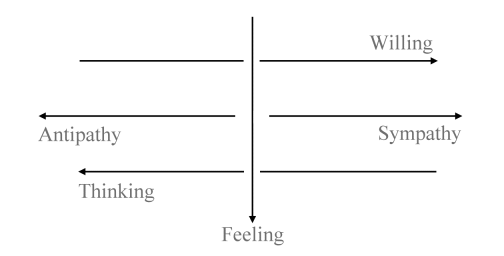 Here again you can convince yourselves of the truth of these remarks by even the most superficial self-examination. What I have already said will lead you to this conviction, for I told you that willing, which in ordinary life proceeds in an objective way, can be intensified to an activity done out of enthusiasm and love. Then you will clearly see willing as permeated with feeling—that willing which otherwise springs forth from the necessities of external life. When you do something which is filled with love or enthusiasm, that action flows out of a willing which you have allowed to become permeated by a subjective feeling. But if you examine the sense activities closely—with the help of Goethe's theory of colour—you will see how these are also permeated by feeling. And if the sense activity is enhanced to a condition of disgust, or on the other hand to the point of drinking in the pleasant scent of a flower, then you have the feeling activity flowing over directly into the activity of the senses. But feeling also flows over into thought. There was once a philosophic dispute which—at all events externally—was of great significance—there have indeed been many such in the history of philosophy—between the psychologist Franz Brentano and the logician Sigwart, in Heidelberg. These two gentlemen were arguing about what it is that is present in man's power of judgment. Sigwart said: “When a man forms a judgment, and says, for example, ‘Man should be good’; then feeling always has a voice in a judgment of this kind; decision concerns feeling.” But Brentano said, “Judgment and feeling (which latter consists of emotions) are so different that the faculty of judgment could not be understood at all if one imagined that feeling played into it.” He meant that in this case something subjective would play into judgment, which ought to be purely objective. Anyone who has a real understanding for these things will see from a dispute of this kind that neither the psychologists nor the logicians have discovered the real facts of the case, namely that the soul activities are always flowing into one another. Now consider what it is that should really be observed here. On the one hand we have judgment, which must of course form an opinion upon something quite objective. The fact that man should be good must not be dependent on our subjective feeling. The content of the judgment must be objective. But when we form a judgment something else comes into consideration which is of a different character. Those things which are objectively correct are not on that account consciously present in our souls. We must first receive them consciously into our soul. And we cannot consciously receive any judgment into our soul without the co-operation of feeling. Therefore, we must say that Brentano and Sigwart should have joined forces and said: True, the objective content of the judgment remains firmly fixed outside the realm of feeling, but in order that the subjective human soul may become convinced of the rightness of the judgment, feeling must develop. From this you will see how difficult it is to get any kind of exact concepts in the inaccurate state of philosophic study which prevails to day. One must rise to a different level before one can reach such exact concepts, and there is no education in exact concepts to-day except by way of spiritual science. External science imagines that it has exact concepts, and rejects what anthroposophical spiritual science has to give, because it has no conception that the concepts arrived at by spiritual science are by comparison more exact and definite than those commonly in use to-day, since they are derived from reality and not from a mere playing with words. When you thus trace the element of feeling on the one hand in cognition, in mental picturing, and on the other hand in willing, then you will say: feeling stands as a soul activity midway between cognition and willing, and radiates its nature out in both directions. Feeling is cognition which has not yet come fully into being, and it is also will which has not yet fully come into being; it is cognition in reserve, and will in reserve. Hence feeling also, is composed of sympathy and antipathy, which—as you have seen—are only present in a hidden form both in thinking and in willing. Both sympathy and antipathy are present in cognition and in will, in the working together of nerves and blood in the body, but they are present in a hidden form. In feeling they become manifest. Now what do the manifestations of feeling in the body look like? You will find places all over the human body where the blood vessels touch the nerves in some way. Now wherever blood vessels and nerves make contact feeling arises. But in certain places, e.g., in the senses, the nerves and the blood are so refined that we no longer perceive the feeling. There is a fine undercurrent of feeling in all our seeing and hearing, but we do not notice it, and the more the sense organ is separated from the rest of the body, the less do we notice it. In looking, in the eye's activity, we hardly notice the feelings of sympathy and antipathy because the eye, embedded in its bony hollow, is almost completely separated from the rest of the organism. And the nerves which extend into the eye are of a very delicate nature and so are the blood vessels which enter into the eye. The sense of feeling in the eye is very strongly suppressed. In the sense of hearing it is less suppressed. Hearing has much more of an organic connection with the activity of the whole organism than sight has. There are numerous organs within the ear which are quite different from those of the eye, and the ear is thus in many ways a true picture of what is at work in the whole organism. Therefore the sense activity which goes on in the ear is very closely accompanied by feeling. And here even people who are good judges of what they hear find it difficult to discriminate clearly—especially in the artistic sphere—between what is purely thought-element and what is really feeling. This fact explains a very interesting historical phenomenon of recent times, one which has even influenced actual artistic production. You all know the figure of Beckmesser in Richard Wagner's “Meistersinger.” What is Beckmesser really supposed to represent? He is supposed to represent a musical connoisseur who quite forgets how the feeling element in the whole human being works into the thought element in the activity of hearing. Wagner, who represented his own conceptions in Walther, was, quite one-sidedly, permeated with the idea that it is chiefly the feeling element that should dwell in music. In the contrast between Walther and Beckmesser, arising out of a mistaken conception—I mean mistaken on both sides—we see the antithesis of the right conception, viz. that feeling and thinking work together in the hearing of music. And this came to be expressed in a historical phenomenon, because as soon as Wagnerian art appeared, or became at all well known, it found an opponent in the person of Eduard Hanslick of Vienna, who looked upon the whole appeal to feeling in Wagner's art as unmusical. There are few works on art which are so interesting from a psychological point of view as the work of Eduard Hanslick On Beauty in Music. The chief thought in this book is that whoever would derive everything in music from a feeling element is no true musician, and has no real understanding for music: for a true musician sees the real essence of what is musical only in the objective joining of one tone with another, and in Arabesque which builds itself up from tone to tone, abstaining from all feeling. In this book, On Beauty in Music Hanslick then works out with wonderful purity his claim that the highest type of music must consist solely in the tone-picture, the tone Arabesque. He pours unmitigated scorn upon the idea which is really the very essence of Wagnerism, namely that tunes should be created out of the element of feeling. The very fact that such a dispute as this between Hanslick and Wagner could arise in the sphere of music is a clear sign that recent psychological ideas about the activities of the soul have been completely confused, otherwise this one-sided idea of Hanslick's could never have arisen. But if we recognise the one-sidedness and then devote ourselves to the study of Hanslick's ideas which have a certain philosophical strength in them, we shall come to the conclusion that the little book On Beauty in Music is very brilliant. From this you will see that, regarding the human being for the moment as feeling being, some senses bear more, some less of this whole human being into the periphery of the body, in consciousness. Now in your task of gaining educational insight it behoves you to consider something which is bringing chaos into the scientific thinking of the present day. Had I not given you these talks as a preparation for the practical reforms you will have to undertake, then you would have had to plan your educational work for yourselves from the pedagogical theories of to-day, from the existing psychologies and systems of logic and from the educational practice of the present time. You would have had to carry into your schoolwork the customary thoughts of the present day. But these thoughts are in a very bad state even with regard to psychology. In every psychology you find a so-called theory of the senses. In investigating the basis of sense-activity the psychologist simply lumps together the activity of the eye, the ear, the nose, etc., all in one great abstraction as “sense-activity.” This is a very grave mistake, a serious error. For if you take only those senses which are known to the psychologist or physiologist of to-day and consider them in their bodily aspect alone, you will notice that the sense of the eye is quite different from the sense of the ear. Eye and ear are two quite different organisms—not to speak of the organisation of the sense of touch which has not been investigated at all as yet, not even in the gratifying manner in which eye and ear have been investigated. But let us keep to the consideration of the eye and ear. They perform two quite different activities so that to class seeing and hearing together as “general sense-activity” is merely “grey theory.” The right way to set to work here would be to speak from a concrete point of view only of the activity of the eye, the activity of the ear, the activity of the organ of smell, etc. Then we should find such a great difference between them that we should lose all desire to put forward a general physiology of the senses as the psychologies of to-day have done. In studying the human soul we only gain true insight if we remain within the sphere which I have endeavoured to outline in my Truth and Science, and also in The Philosophy of Freedom. Here we can speak of the soul as a single entity without falling into abstractions. For here we stand upon a sure foundation; we proceed from the point of view that man lives his way into the world, and does not at first possess the whole of reality. You can study this in Truth and Science, and in The Philosophy of Freedom. To begin with man has not the whole reality; he has first to develop himself further, and in this further development what formerly was not yet reality becomes true reality for him through the interplay of thinking and perception. Man first has to win reality. In this connection Kantianism, which has eaten its way into everything, has wrought the most terrible havoc. What does Kantianism do? First of all it says dogmatically: we look out upon the world that is round about us, and within us there lives only the mirrored image of this world. And so it comes to all its other deductions. Kant himself is not clear as to what is in the environment which man perceives. For reality is not within the environment, nor is it in phenomena: only gradually, through our own winning of it, does reality come in sight, and the first sight of reality is the last thing we get. Strictly speaking, true reality would be what man sees in the moment when he can no longer express himself, the moment in which he passes through the gateway of death. Many false elements have entered into our civilisation, and these work at their deepest in the sphere of education. Therefore we must strive to put true conceptions in the place of the false. Then, also, shall we be able to do what we have to do for our teaching in the right way. |
| 293. The Study of Man: Lecture VI
27 Aug 1919, Stuttgart Translated by Daphne Harwood, Helen Fox Rudolf Steiner |
|---|
| Up to now we have tried to understand the human being from the point of view of the soul, in so far as this understanding is necessary in the education of the child. |
| We count upon these external hypotheses in our actions; we are convinced that the two posts supporting the beam will not give way if they are of a certain thickness. But we cannot understand the whole process which is connected with this, any more than we can understand the movements of our legs when we move forwards. |
| It is only when you see things in such connections as these that you can come to a true understanding of the form of the human body. |
| 293. The Study of Man: Lecture VI
27 Aug 1919, Stuttgart Translated by Daphne Harwood, Helen Fox Rudolf Steiner |
|||||||||||||||
|---|---|---|---|---|---|---|---|---|---|---|---|---|---|---|---|
Up to now we have tried to understand the human being from the point of view of the soul, in so far as this understanding is necessary in the education of the child. We must keep the three standpoints distinct—the standpoints of spirit, of soul and of body, and, in order to arrive at a complete anthropology, we shall study the human being from all three. The first to be taken is the psychic, or soul point of view because this is nearest to man in his ordinary life. And you will have felt that in taking sympathy and antipathy as principal concepts for the understanding of man we have been directing our attention to the soul. It will not answer our purpose if we pass straight over from the psychical to the physical, for we know, from what spiritual science has told us, that the physical can only be understood when it is looked upon as a revelation of the spiritual and also of the soul. Therefore to what we have already sketched in general lines as a study of the soul we will now add a contemplation of the human being from the point of view of spirit, and finally we shall come to a real “anthropology,” as it is now called, a consideration of the human being as he appears in the external physical world. If you want to examine the human being effectively from any point of view you must return again and again to the separation of man's soul activities into cognition (which takes place in thought) and into feeling and willing. Up till now we have considered thinking (or cognition), feeling and willing in the light of antipathy and sympathy. Now we will study willing, feeling and cognition from the point of view of the spirit. From the spiritual point of view, also, you will find a difference between willing, feeling and thinking-knowing. If I may speak pictorially (for the pictorial element will help us to form the right concepts): when you have knowledge through thought you must feel that in a certain way you are living in the light. You cognise, and you feel yourself with your ego right in the midst of this activity of cognition. It is as though every part, every bit of the activity which we call cognition, were there within all that your ego does; and again what your ego does is there within the activity of cognition. You are entirely in the light; you live in a fully conscious activity, if I may express myself in such a concept. And it would be bad indeed if you were not in a fully conscious activity in cognising. Suppose for a moment that you had the feeling that while you were forming a judgment something happened to your ego somewhere in the subconscious and that your judgment was the result of this process. For instance you say: “That man is a good man,” thus forming a judgment. You must be conscious that what you need in order to form this judgment—the subject “man” the predicate “is good”—are parts of a process which is clearly before you and which is permeated by the light of consciousness. If you had to assume that some demon or some mechanism of nature had tangled up the man with the “being good” while you were forming the judgment, then you would not be fully, consciously present in this act of thought, of cognition: in some part of the judgment you would be unconscious. That is the essential thing about thinking cognition, that you are present in complete consciousness in the whole warp and woof of its activity. That is not the case in willing. You know that when you perform the simplest kind of willing, for instance walking, you are only really fully conscious in your mental picture of the walking. You know nothing of what takes place in your muscles whilst one leg moves forward after the other; nothing of what takes place in the mechanism and organism of your body. Just think of what you would have to learn of the world if you had to perform consciously all the arrangements involved when you will to walk. You would have to know exactly how much of the activity produced by your food in the muscles of your legs and other parts of your body is used up in the effort of walking. You have never reckoned out how much you use up of what your food brings to you. You know quite well that all this happens unconsciously in your bodily nature. When we “will” there is always something deeply, unconsciously present in the activity. This is not only so when we look at the nature of willing in our own organism. What we accomplish when we extend our will to the outer world, that, too, we do not by any means completely grasp with the light of consciousness. Suppose you have here two posts set up like pillars. (See drawing.) 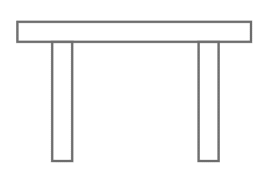 Imagine you lay a third post across the top of them. Now notice carefully, please, how much fully conscious knowing activity there is in what you have done; how much fully conscious activity such as there is when you pass the judgment “a man is good,” where you are right in the midst of it with your knowledge. Distinguish, please, what is present as the activity of cognition here from that of which you know nothing although you had to do it with all your will: why these two pillars through certain forces support the beam that is lying on them? Up to now physics has only hypotheses concerning this, and if men believe that they “know” why the two pillars support the beam they are under an illusion. All the concepts that exist of cohesion, adhesion, forces of attraction and repulsion are, at bottom, only hypotheses on the part of external knowledge. We count upon these external hypotheses in our actions; we are convinced that the two posts supporting the beam will not give way if they are of a certain thickness. But we cannot understand the whole process which is connected with this, any more than we can understand the movements of our legs when we move forwards. Here, too, there is in our willing an element that does not reach into our consciousness. Willing in all its different forms has an unconscious element in it. And feeling stands midway between willing and thinking-cognition. Feeling is also partly permeated by consciousness, and partly by an unconscious element. In this way feeling on the one hand shares the character of cognition-thinking, and on the other hand the character of feeling or felt will. What is this then really from a spiritual point of view? You will only arrive at a true answer to this question if you can grasp the facts characterised above in the following way. In our ordinary life we speak of being awake, of the waking condition of consciousness. But we only have this waking condition of consciousness in the activity of our knowing-thinking. If therefore you want to say absolutely correctly how far a human being is awake you will be obliged to say: A human being is really only awake as long and in so far as he thinks of or knows something. What then is the position with regard to the will? You all know the sleep condition of consciousness—you can also call it, if you like, the condition of unconsciousness—you know that what we experience while we sleep, from falling asleep until we wake, is not in our consciousness. Now it is just the same with all that passes through our will as an unconscious element. In so far as we as human beings are beings of will, we are “asleep” even when we are awake. We are always carrying about with us a sleeping human being—that is, the willing man—and he is accompanied by the waking man, by the man of cognition and thought: in so far as we are beings of will we are asleep even from the time we wake up until we fall asleep. There is always something asleep in us, namely: the inner being of will. We are no more conscious of that than we are of the processes which go on during sleep. We do not understand the human being completely unless we know that sleep plays into his waking life, in so far as he is a being of will. Feeling stands between thinking and willing, and we may now ask: How is it with regard to consciousness in feeling? That too is midway between waking and sleeping. You know the feelings in your soul just as you know your dreams, only that you remember your dreams and have a direct experience of your feelings. But the inner mood and condition of soul which you have with regard to your feelings is just the same as you have with regard to your dreams. Whilst you are awake you are not only a waking man in that you think and know, and a sleeping man in that you will: you are also a “dreamer” in that you feel. Thus we are really immersed in three conditions of consciousness during our waking life: the waking condition in its real sense in thinking and knowing, the dreaming condition in feeling, and the sleeping condition in willing. Seen from the spiritual point of view ordinary dreamless sleep is a condition in which a man gives himself up in his whole soul being to that to which he is given up in his willing nature during his daily life. The only difference is that in real sleep we “sleep” with the whole soul being, and when we are awake we only sleep with our will. In dreaming as it is called in ordinary life we are given up with our whole being to the condition of soul which we call the “dream” and in waking life we only give ourselves up in our feeling nature to this dreaming soul condition. If you look at the matter in this way, from the educational point of view, you will not wonder that the children differ with regard to awakeness of consciousness. For you will find that children in whom the feeling life predominates are dreamy children; if thought is not fully aroused in such children they will certainly incline to dreaminess. This must be an incentive to you to work upon such children through strong feeling. And you can reasonably hope that these strong feelings will awaken clear thought in them, for, following the rhythm of life, everything that is asleep has the tendency sometime to awaken. If we have such a child, who broods dreamily in his feeling life, and we approach him with strong feelings, after some time these feelings awaken of themselves as thoughts. Children who brood still more and are even dull in their feeling life, will reveal specially strong tendencies in their will life. By studying these things you bring knowledge to bear on many a problem in child life. You may get a child in school who behaves like a true dullard. If you were immediately to decide “That is a weak-minded, a stupid child,” if you tested him with experimental psychology, with wonderful memory tests and all the other things which are done now in psychological pedagogical laboratories, and if you then said, “stupid child in his whole disposition; belongs to the school for the feeble-minded, or to the now popular schools for backward children,” you would be very far from understanding the real nature of the child. It may be that the child has special powers in the region of the will; he may be one of those children who, out of his choleric nature will develop active energy in his later life. But at present the will is asleep. And if the thinking cognition in the child is destined not to appear until later, then he must be treated appropriately so that in his later life he may be able to work with active energy. At first he seems to be a veritable dullard, but it may be that he is not that at all. And you must know how to awaken the will in a child of this kind. That means that you must work into his waking sleep-condition, his will, in such a way that later on—because all sleeping has a tendency to change into waking—this sleep is gradually wakened up into conscious will, a will that is perhaps very strong, only it is at present overpowered by the sleeping element. You must treat a child of this kind by building as little as possible on his powers of knowing, on his understanding, but by “hammering” in some things which will work strongly on the will, by letting him walk while he speaks. You will not have many such children, but in a case of this kind you can call the child out from the class—which will be stimulating to the other children, and educative for the child himself—and get him to say sentences and accompany his words by movements. Thus: “The (step) man (step) is (step) good (step).” In this way you combine the whole human being in the will element with the merely intellectual element in cognition, and you can gradually bring it about that the will is awakened into thought in such a child. It is not until we realise that in the waking human being we have to do with different conditions of consciousness, with waking, dreaming, and sleeping, that we are brought to a true knowledge of our task with regard to the growing child. But now we can put this question: How is the true centre of the human being, the ego, related to these different conditions? The easiest way to arrive at a true answer to this is to postulate—what is indeed undeniable—that what we call the world, the cosmos, is a sum of activities. These activities express themselves for us in the different spheres of elemental life. We know that forces are at work in this elemental life. Life-force, for instance, is at work all around us. And between the elemental forces and life-force there is inwoven all that warmth and fire produces. Just think what an important part fire plays in our environment. In certain parts of the world, for instance in South Italy, you only need to light a ball of paper and immediately great clouds of smoke will begin to rise out of the earth. Why does this happen? It happens because when you light the ball of paper and thus produce warmth you rarefy the air in this place, and what is usually at work in the forces under the surface of the earth becomes perceptible through the ascending smoke: the very moment you light the paper ball and throw it on the earth, you are standing in a cloud of smoke. That is an experiment that can be made by every traveler who goes into the neighbourhood of Naples. This is an example to show you that if we do not look at the world superficially we must recognise that our whole environment is permeated by forces. Now there are also higher forces than warmth. They too are round about us. We walk among them continually in going about the world as physical men. Indeed our physical bodies are so constituted that we can endure this, though we are unaware of it in our ordinary knowledge. With our physical body we can pass through the world in this way. With our ego, the youngest member of the human being, we could not pass through these world forces if this ego were to give itself up directly to them. This ego cannot give itself up to all that is round it and in the midst of which it is placed. This ego must still be guarded from having to pour itself out into the world forces. In course of time it will evolve so that it will be able to enter into these world forces. But it cannot do so yet. It is necessary, therefore, that in our fully awakened ego we be not forced to enter into the real world that is around us, but only into the image of that world. Hence in our thinking-cognition we have only images of the world—as already described when speaking from the point of view of the soul. Now we view it also from the point of view of spirit. In thinking-cognition we live in images; and, in our present stage of evolution, while we live between birth and death in our fully wakened ego—it is only in images of the cosmos that we human beings can live, not yet in the real cosmos. Therefore when we are awake our body has to produce images of the cosmos for us. And then our ego dwells in these images. Psychologists take endless trouble to define the relation between body and soul: they speak of the interplay between body and soul, of psycho-physical parallelism and many other things. All these are in reality childish concepts. For the process really at work is this: when the ego in the morning passes over into the waking condition, it enters into the body, but not into the physical processes of the body, only into the world of images, which the body creates from out of the external processes in the very depths of its being. In this way thinking-cognition is communicated to the ego. In feeling it is different. There the ego does enter into the real body, not only into the images. But if, as it enters into the body, it were fully conscious, then (remember this is spoken now of the soul) it would literally “burn up” in the soul. If the same thing happened to you in feeling that happens to you in thinking when you penetrate with your ego into the images which your body has produced in you, you would burn up in your soul. You could not bear it. This penetration which is proper to feeling can only be experienced by you in a dreaming, dulled condition of consciousness. It is only in a dream that you can bear what really happens in your body in the process of feeling. And what happens in willing you can only experience in a sleeping condition. You would experience something most terrible if in your ordinary life you were obliged to participate in all that happens when you will. The most terrible pain would lay hold of you if, for instance, as I have already indicated, you really had to experience how the forces brought to your organism by your food are used up in your legs when you walk. It is lucky for you that you do not experience this, or rather that you only experience it in a condition of sleep. For if you were awake it would mean the greatest pain imaginable, a fearful pain. Hence you will understand it if I now characterise the life of the ego during what is usually called waking consciousness—which comprises: complete waking, dreaming-waking, sleeping-waking—you will understand it if I characterise what the ego actually experiences while it is living in the body in the ordinary waking condition. This ego lives in “thinking-cognition” in that it wakes up into the body; here it is fully awake. But it lives in it only in images. Hence man between birth and death lives in images only, when using his thinking-cognition unless he does such exercises as are indicated in my book Knowledge of the Higher Worlds and How to Attain It. Next the ego, in awaking, also sinks into those processes which condition feeling. In feeling life we are not fully awake, but dreaming-awake. How do we actually experience what we go through in feeling in this dream-waking condition? We actually experience it as what has been called “Inspiration,” inspired—unconsciously inspired—mental pictures. In the artist this is the centre whence rises all that comes out of the feelings into waking consciousness. There it is first worked through. There too are worked through all those “inklings,” which turn to image in waking consciousness. The “Inspirations” spoken of in my book Knowledge of the Higher Worlds and How to Attain It are the same as these; only that the experience of the unconscious inspirations deep within the feeling life of every man is lifted, in these, into clarity and full consciousness. 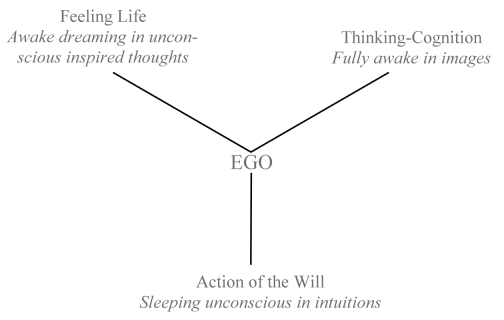 And when especially gifted people speak of their inspirations they really speak of that which the world has laid into their feeling life and has avowed to come into their fully awake consciousness by means of their capacities. It is a matter of world content, no less than thought content is world content. But in the life between birth and death these unconscious inspirations reflect world processes which we can only experience in dreaming, for if we experienced them otherwise our ego would burn up in these processes, or rather it would suffocate. You sometimes find suffocation setting-in in abnormal conditions. Suppose you have a nightmare. This means that the interplay between man and the outer air has come into consciousness in an abnormal way because something in this interplay is out of order. In trying to enter the ego consciousness it does not become conscious as a normal mental picture, but as a tormenting picture, as a nightmare. And just as this abnormal breathing in a nightmare is tormenting, so the breathing process as a whole would be torment if man experienced his breathing with full consciousness. He would experience it in feeling, but it would be torment to him. For this reason it is dulled, and so it is not experienced as a physical process, but only in the dreamlike feeling. And as to the processes which take place in willing as I have already indicated to you they would mean fearful pain. So that we can add a third statement: the ego in action of the will is asleep. What a man really experiences in such action, with a greatly dimmed consciousness (a sleeping consciousness in fact), is unconscious intuitions. A human being has unconscious intuitions continually; but they live in his will. He is asleep in his will. Therefore in ordinary life he cannot call up these intuitions; it is only at auspicious moments in life that they well up. Then in a dim way the human being participates in the spiritual world. Now there is something remarkable in the ordinary life of man. We all know the full consciousness in complete awakeness that we have in our thinking-cognition. Here we are, so to speak, in the clear light of consciousness; here we find certitude. But you know that people when thinking about the world, sometimes say: “We have intuitions.” Vague feelings emanate from these intuitions. What people then relate is often very confused, but it can also be, unconsciously, quite well-ordered. Finally when a poet speaks of his intuitions, that is entirely right for he does not produce them immediately from the region nearest to him—from the inspired representations of his feeling life—but he brings them forth, these completely unconscious intuitions, from the region of his sleeping will. Anyone who looks deeply into these things sees that what appear as the chances of life, are governed by deep laws. For instance, when you read the second part of Goethe's “Faust” you want to study deeply how the structure of this remarkable verse could be achieved. Goethe was already old when he wrote the second part of his “Faust”—at least the greater part of it. This was how it was written: His secretary John sat at the writing table and wrote what Goethe dictated. If Goethe had had to write it down himself he would probably not have been able to produce such marvelously chiseled verses in the second part of his “Faust.” While he was dictating in his little room in Weimar, Goethe continuously walked up and down, and this walking up and down is part and parcel of the conception of the second part of “Faust.” While Goethe was producing this unconscious willed activity in walking, something of his intuitions pressed upwards and this outer motion brought to light what the other man wrote down for him on paper. If you want to make a diagram of the life of the ego in the body it is possible to make it in the following way:
but if you do this you will not be able to make it clear why intuition, of which men speak instinctively, comes up more readily to the image knowing of every day than the inspired feeling which lies nearer to us. If you now want to draw the diagram correctly (for the above is not correct) you must draw it in the following way, and then you will be able to understand the facts more easily. For then you will say: knowing in images descends in the direction of arrow 1 into inspirations, and it comes up again out of intuitions (arrow 2). But this knowing, which is indicated by arrow 1 is the descent into the body. And now observe yourself; you are at first quite quiet, sitting or standing, giving yourself up to thinking-cognition, to the observation of the external world. There you live in images. What further the ego experiences in the outward processes descends into the body—first into the feeling, then into the will. You do not notice what is in your feeling; neither at first do you notice what is in your will. Only, when you begin to walk, when you begin to act, what you first observe outwardly is not the feeling but the will. And then in the descent into the body and the re-ascent, which happens in the direction of arrow 2, it is nearer for intuitive willing to come to the image consciousness than for the dreaming inspired feeling. Hence you will find that people so often say: “I have a vague intuition.” In such a case what are called intuitions in my book Knowledge of the Higher Worlds and How to Attain It are being confused with the superficial intuition of ordinary consciousness. 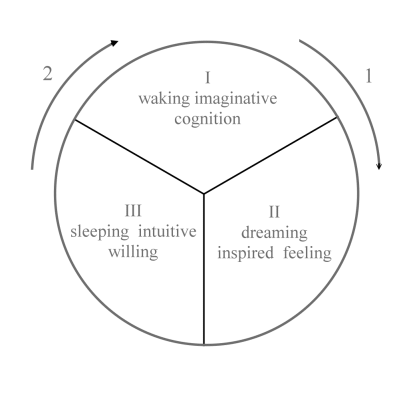 Now you will be able to understand something of the formation of the human body. Imagine to yourself for a moment that you are walking but observing the world. Imagine to yourself that it was not your lower body that was walking with your legs, but that your head had your legs directly attached to it and that it had to walk itself. Then your observing of the world and your willing would be woven into a unity, and the result would be that you could only walk in a sleeping condition. Because your head is placed upon your shoulders and upon the remaining part of your body, it is at rest there. It is at rest, and since you only move with these other parts of your body, you carry your head. Now the head must be able to rest on the body, otherwise it could not be the organ of thinking-cognition. It must be withdrawn from the sleeping-willing; for the moment you brought it into movement, brought it out of relative rest into independent movement, it would fall asleep. It allows the body to carry out the real willing, and it lives in this body as in a carriage and allows itself to be conveyed by this carriage. And it is only because the head allows itself, as in a carriage, to be conveyed by the body, and because it acts while it is being conveyed during the resting condition, that the human being is awake in action. It is only when you see things in such connections as these that you can come to a true understanding of the form of the human body. |

